Maine State Police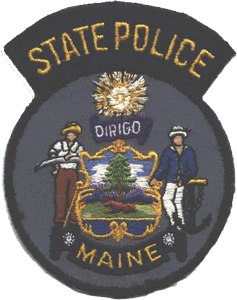
Maine State Police
The Maine State Highway Police was founded in July of 1921 with 34 new officers, known as Inspectors, working under the authority of the State Highway Commission.
In 1925, it was determined that there was a need to increase the size and scope of the State Highway Police, and by 1935, the force was then officially called the Maine State Police with Inspectors re- titled as "Troopers". The number of sworn officers reaches 100 that year.
In 1936, the first 47 patrol cars were purchased to replace most of the 46 Harley Davidson motorcycles and 25 sidecars that patrolled Maine highways and by-ways year-round. MSP patrol cars were black and Highway Safety cars were white.
In March of 1942, the MSP covered 6 Troop areas: Troop A (Wells) Troop B (West Scarborough) Troop C (Fairfield) Troop D (Thomaston) Troop E (Bangor) Troop F (Houlton) In 1955, Troop G is established to patrol the Maine Turnpike from Kittery to Augusta. This was also the first year that MSP license plates went from annual issues to a standard multi-year red character over silvery white background. The following year, roof lights were installed on patrol cars for the first time.
In 1965, MSP patrol car color went from black to medium blue. This was also the year that MSP license plates went from red over white to white over blue. Blue patrol cars with white roofs were experimented with from 1968 to 1972 when the MSP decided to go back to all blue cars. 1970 was the first year 4 door cars were put into service. The Maine Department of Public Safety was established in 1972 with the MSP falling under its direction.
Troop J covers Hancock and Washington counties, and Troop K is the Traffic Division located in Gardiner. Troop K is the largest troop and is home to the Inspection Section and Commercial Vehicle Enforcement. A Special Services Unit handles matters involving Canine, Aviation, Underwater Recovery Team and Executive Protection. Today, the MSP has in excess of 300 sworn officers who wear their uniform proudly.
The Maine State Police has had a history of issuing distinctive license plates for their patrol vehicles from their earliest days.
As early as 1925, the newly-formed Maine State Highway Police had their own distinctive plates for their motorcycle fleet. No car plates have yet been discovered or recorded for the Maine State Highway Police. It is likely that in those earliest of days that only motorcycles were used on patrol.
Designs varied, but the known SHP motorcycle plates of that time were made of embossed steel and measured approximately 6 1/8" x 4 1/2". The colors matched the civilian motorcycle plates of each year. The letters S. H were embossed over POLICE over MAINE 19##.
Titled Maine State Police license plates for patrol cars may have began in 1935, however no surviving specimen or photograph of one can be found. The earliest such confirmed plate was issued in 1936. The plate was made of embossed steel and measured only 6 1/8" x 8 7/8", which was quite small for contemporary automobile license plates of the day.
It was painted black over orange and had the state name stacked along the left margin. The title STATE over POLICE occupied the top center of the plate over the assignment number with 1936 stacked along the right margin. It has been speculated and believed that the number reflected the badge number of the trooper assigned to the vehicle for these earlier issues, but this has not yet been confirmed.
Annual plates were issued from 1936 right on through to 1949.
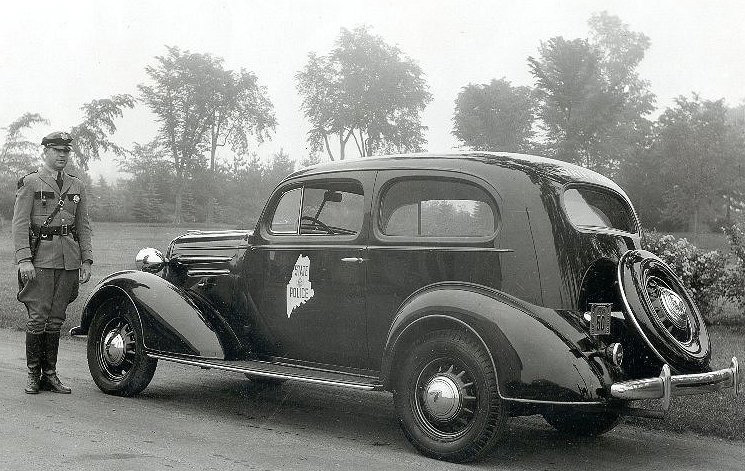
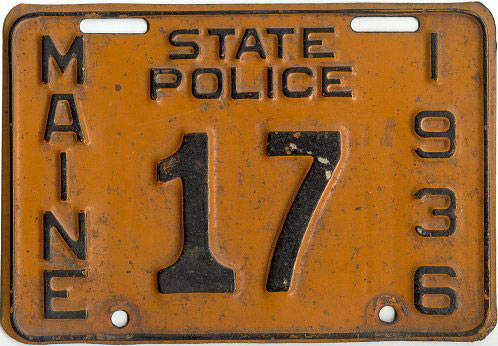 1936 issue. Embossed steel.
1936 issue. Embossed steel.
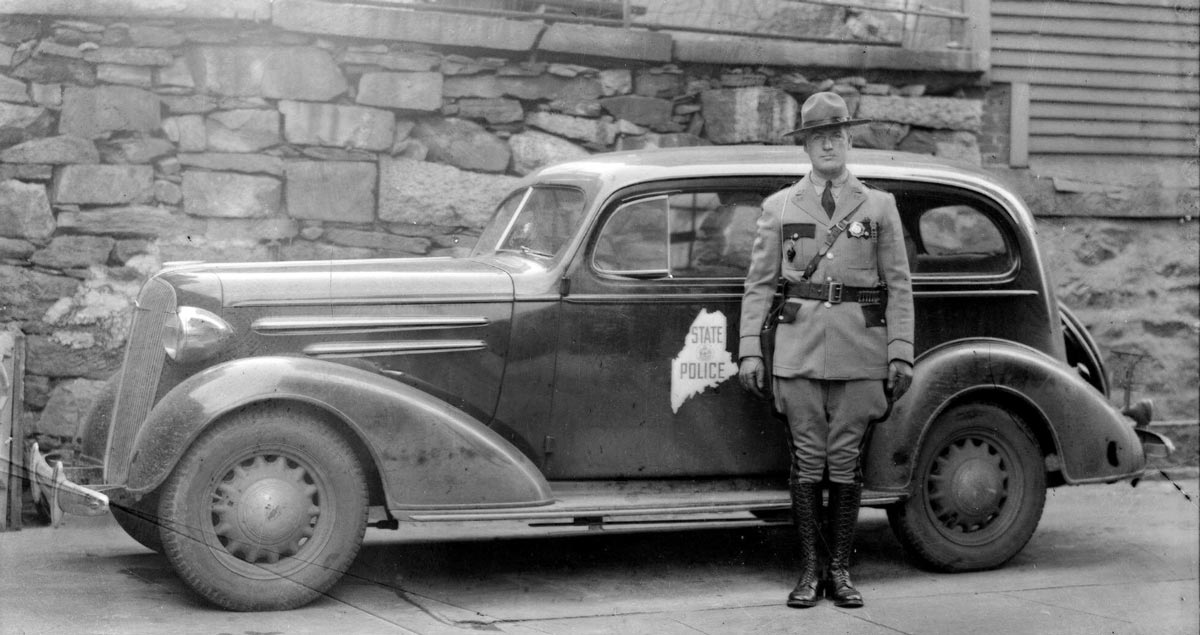 1936
1936 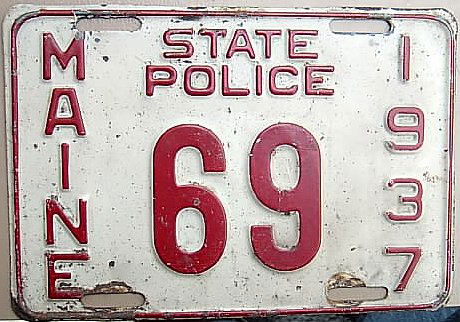 1937 issue. Embossed steel.
1937 issue. Embossed steel. 
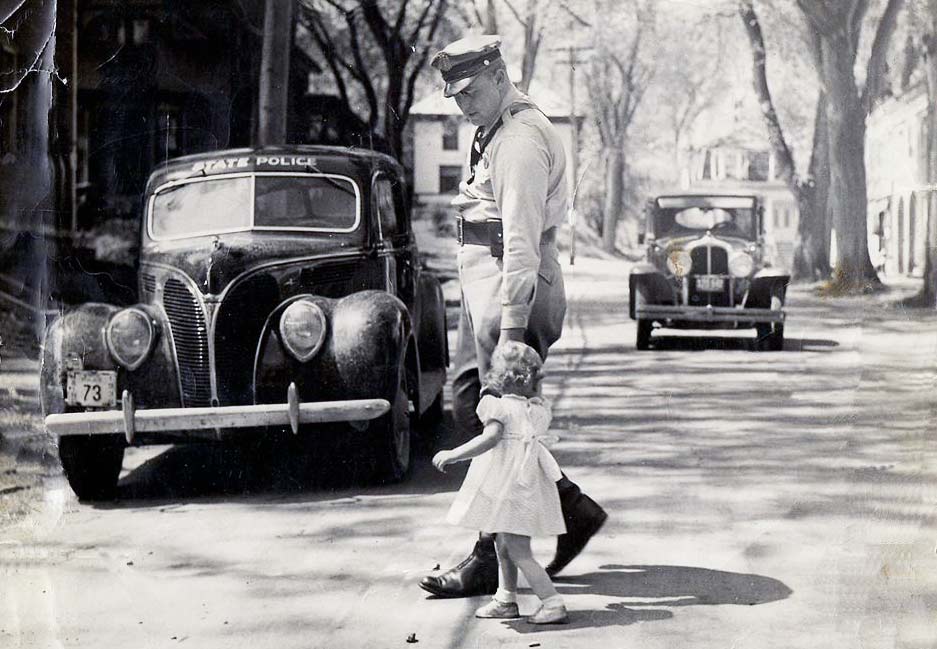 Crossing the Street- 1938.
Crossing the Street- 1938. 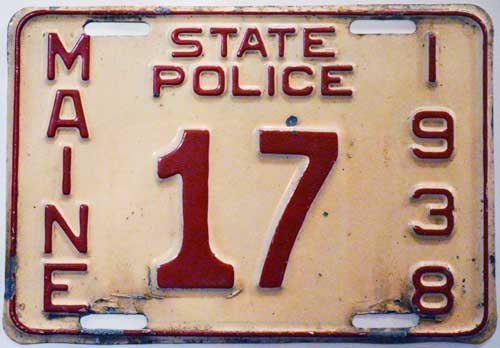 1938 issue. Embossed steel.
1938 issue. Embossed steel. 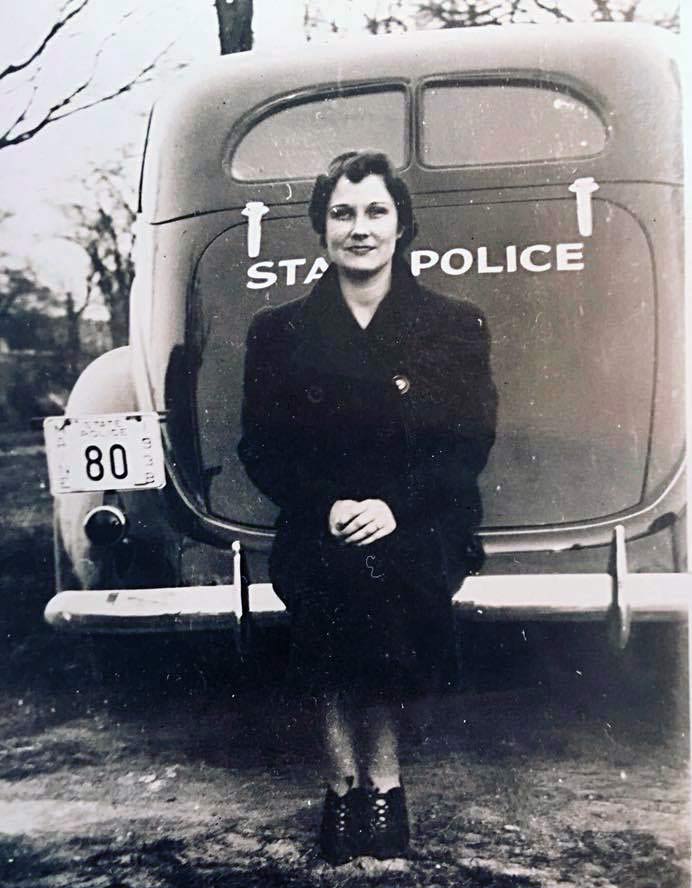
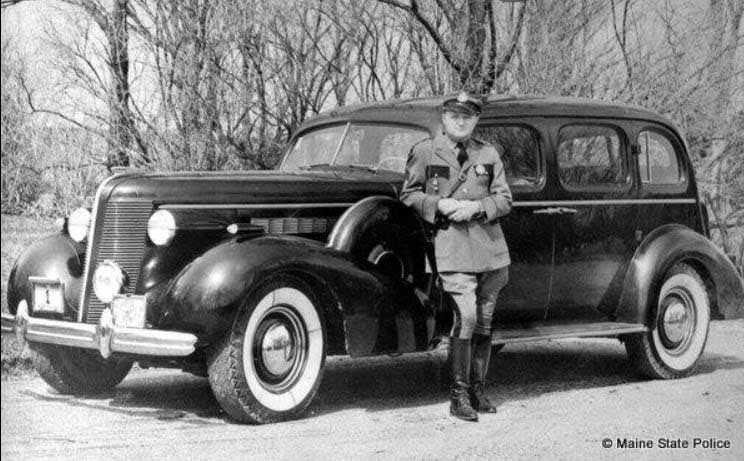 Governor's Detail- 1939
Governor's Detail- 1939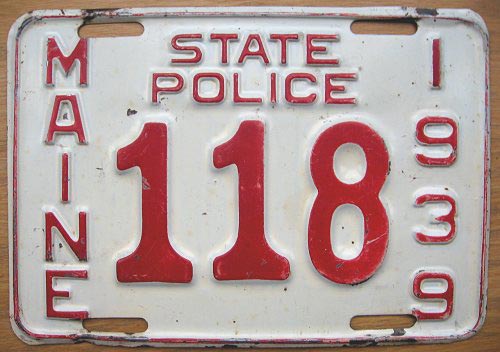 1939 issue. Embossed steel.
1939 issue. Embossed steel. 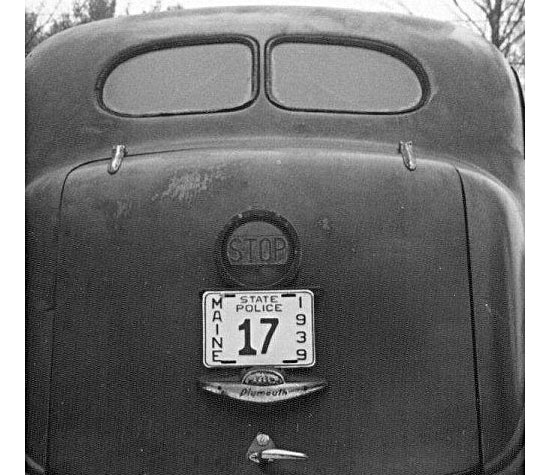
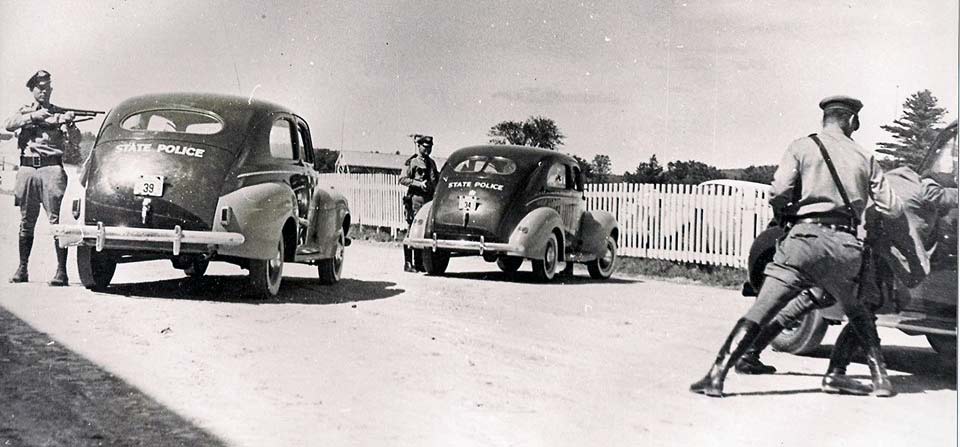 Taking Care of Business- 1939.
Taking Care of Business- 1939. 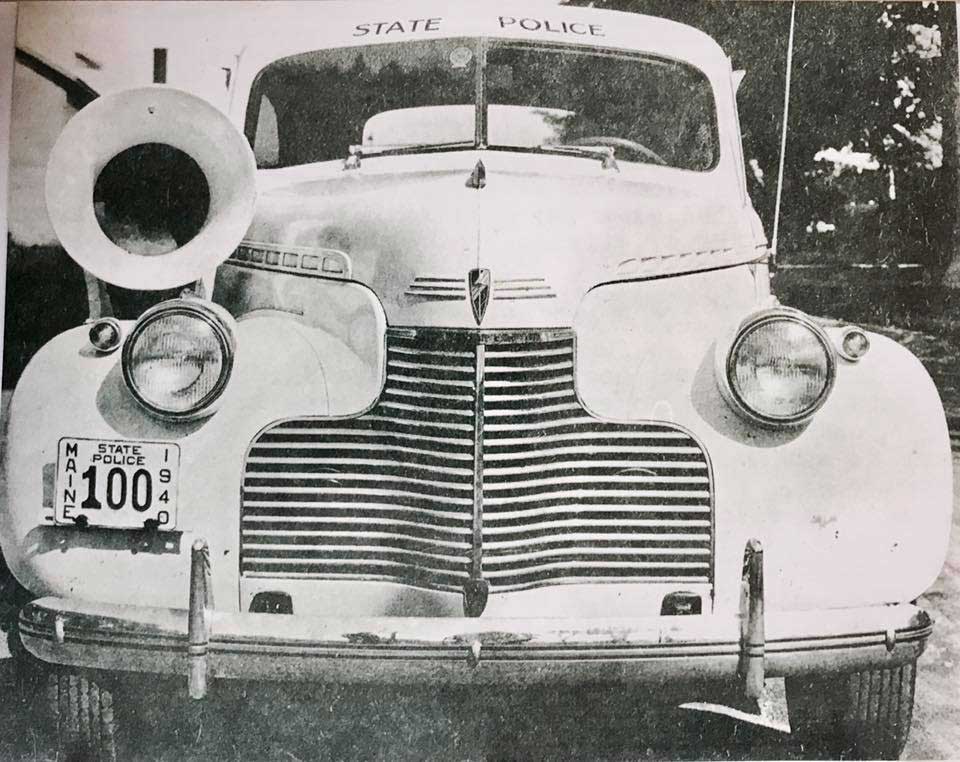 1940 issue. Embossed steel. 6 1/8" x 8 7/8". Unconfirmed color scheme.
1940 issue. Embossed steel. 6 1/8" x 8 7/8". Unconfirmed color scheme.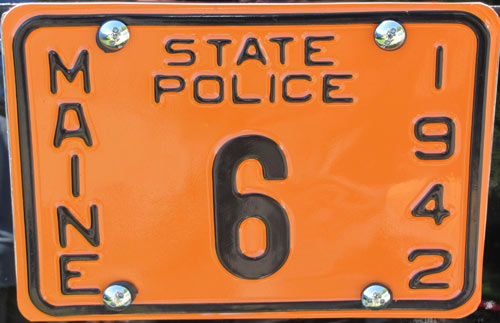 1942 issue. Embossed steel.
1942 issue. Embossed steel. 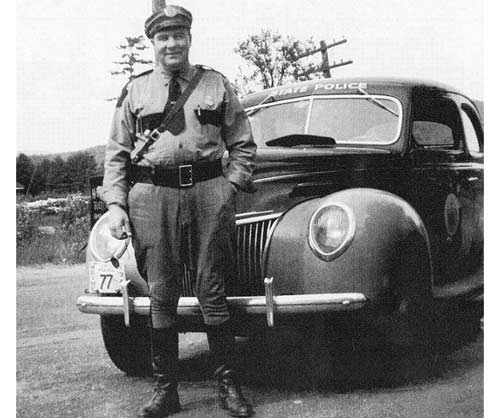
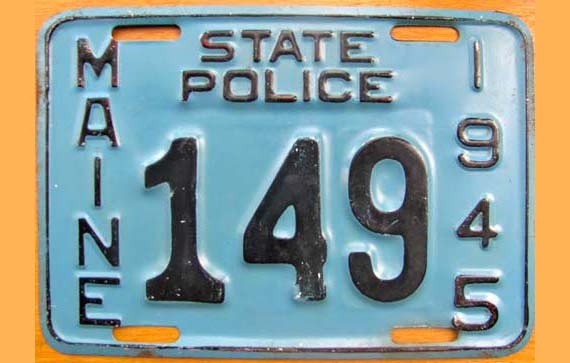 1945 issue. Embossed steel.
1945 issue. Embossed steel. 
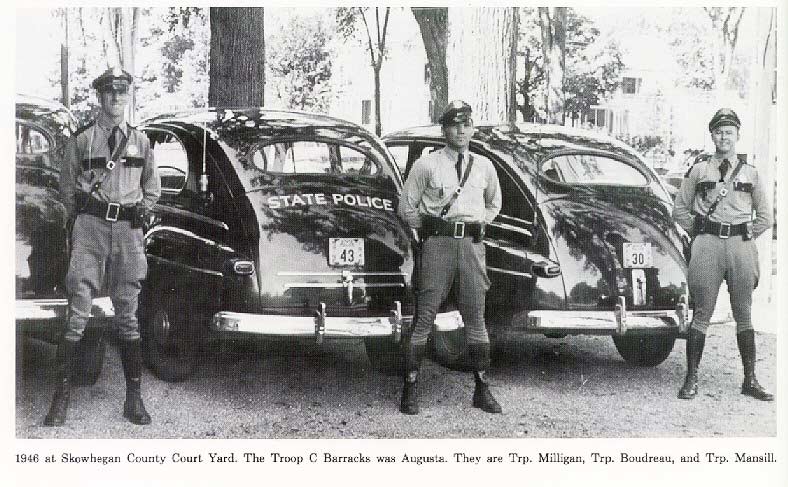
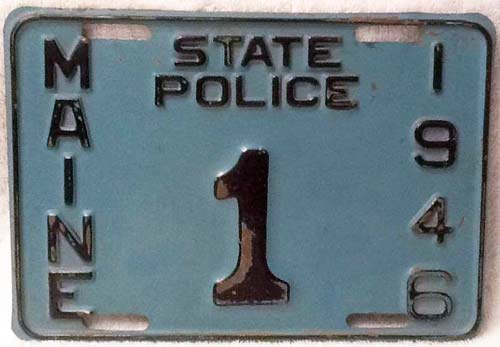 1946 issue. Embossed steel.
1946 issue. Embossed steel. 
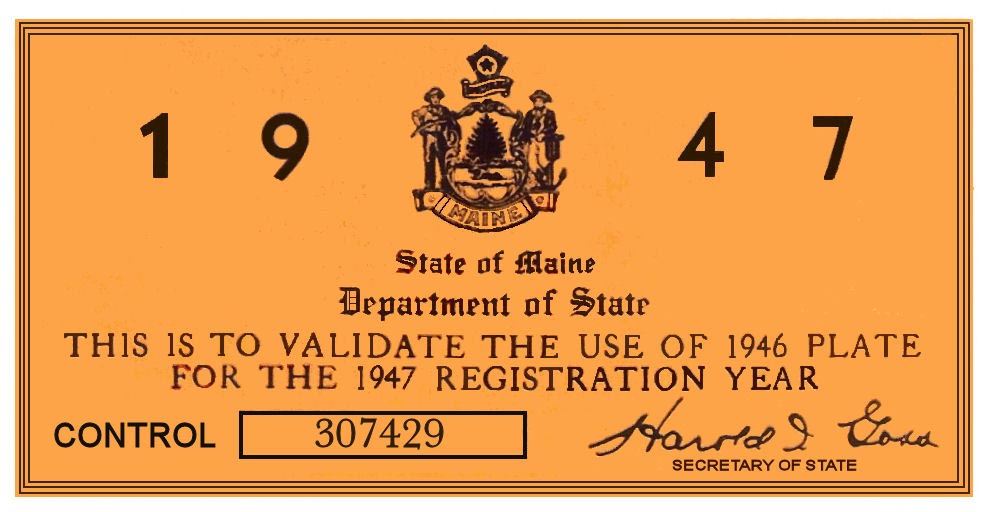
It is believed that the 1947 issue for the Maine State Police was the continued use of the 1946 plate along with the 1947 validation decal seen above affixed to the car's windshield.
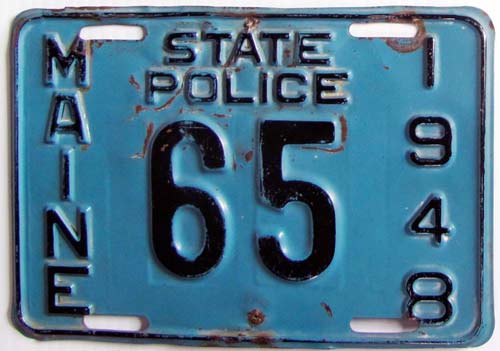 1948 issue. Embossed BRASS.
1948 issue. Embossed BRASS. 
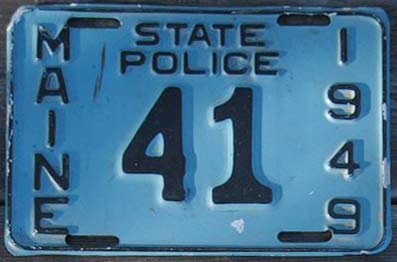 1949 issue. Embossed Aluminum.
1949 issue. Embossed Aluminum. 
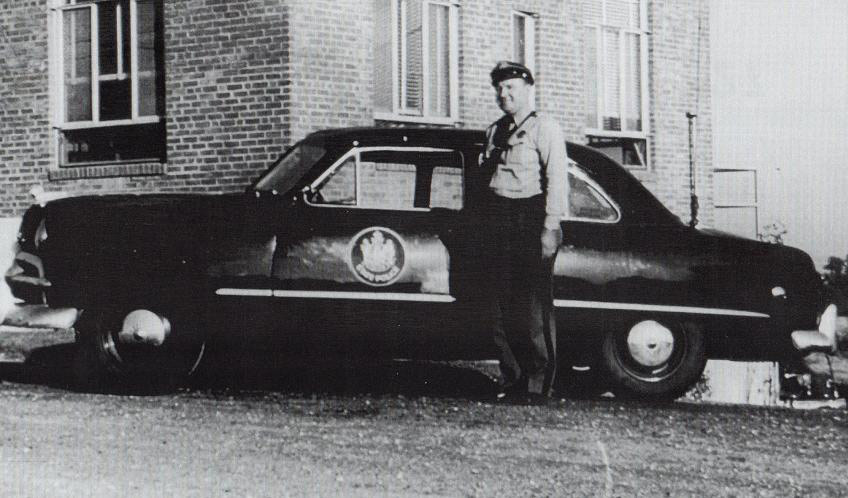
In 1950, a multi-year permanent plate was issued. The plate measured the same as the earlier issues, but made of embossed aluminum and the year on the right margin had been dropped. The plate had black characters painted over a reflective deep blue background. This was done as an added safety measure for Maine State Troopers conducting duties on the side of roadways and highways in the state. The technology of reflective paint coatings was in its infancy at that time and used finely-crushed glass bead material to catch light and reflect it back to the eye. With a black over dark blue background, there was very little contrast to these plates, and although very visible and legible at night when struck by light, they were diffcult to read in daylight conditions. This plate was used continuously through 1954.
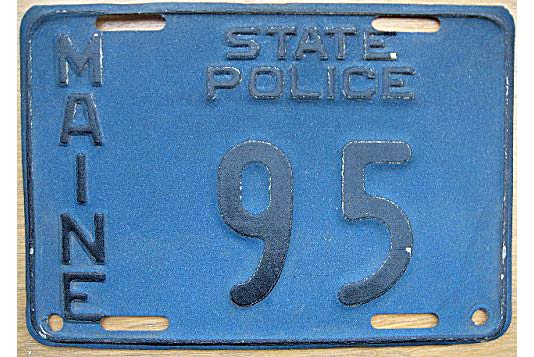 1950-1954 issue .
1950-1954 issue .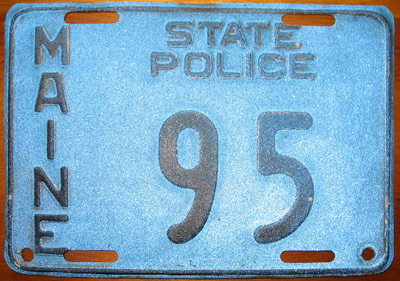 1950-1954 issue in low light reflection
1950-1954 issue in low light reflection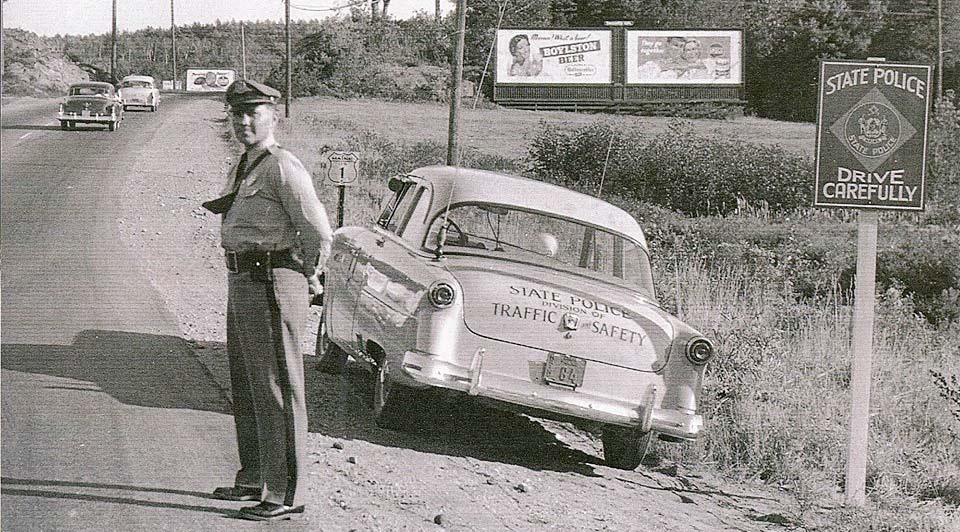 Circa 1954-
Circa 1954- 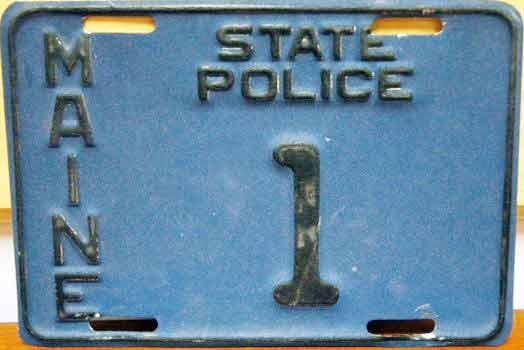 1950-1954 issue. MSP Colonel's plate.
1950-1954 issue. MSP Colonel's plate.

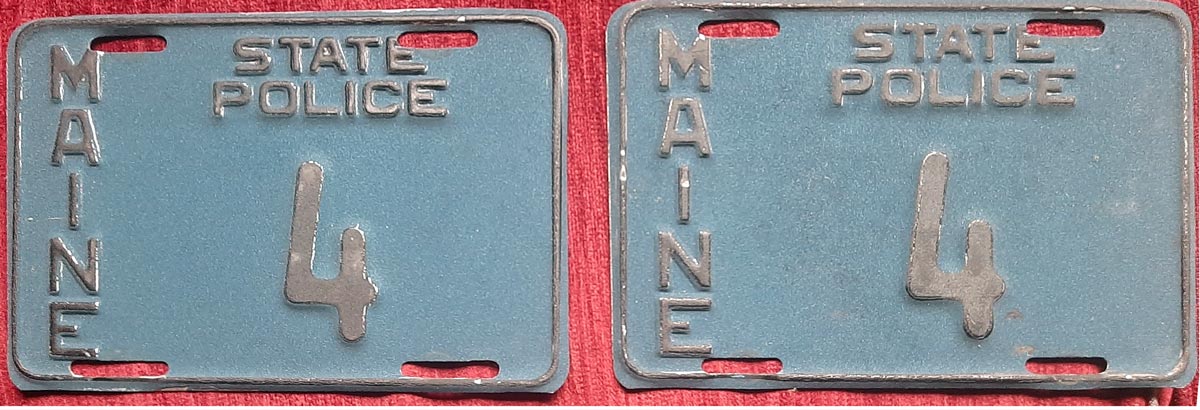 (Courtesy Mark Nickerson)
(Courtesy Mark Nickerson) Sometime in 1954, the black over blue plates were replaced by a 6" x 12" embossed aluminum plate, which became the standard size for all license plates issued in North America in 1956. The colors were red over reflective white made of Flex-O-Lite reflective material. The state name was situated at the top center of the plate. The letters S followed by a short dash, the letter P followed by another short dash was followed by the assignment number.
These plates were used through 1959 in tandem with a full-titled MSP license plate during this time frame.
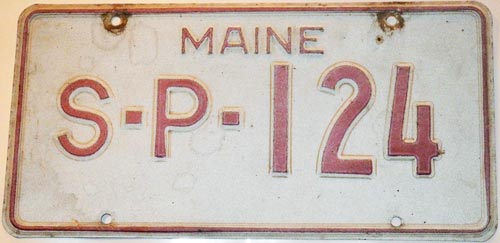 1954-1955 issue.
1954-1955 issue. 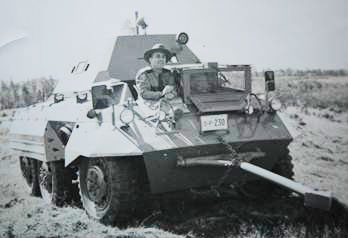
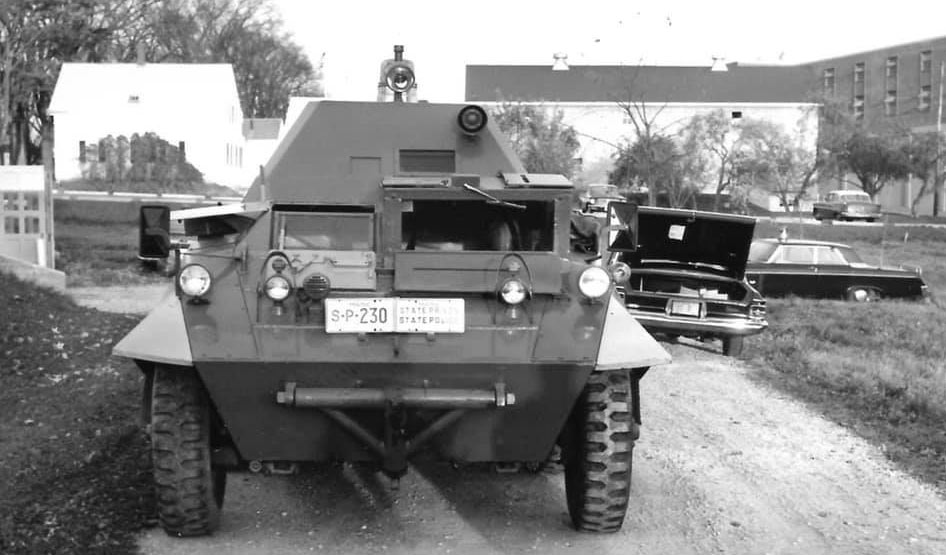 Armored personnel carrier used by State Police assigned to State Prison.
Armored personnel carrier used by State Police assigned to State Prison.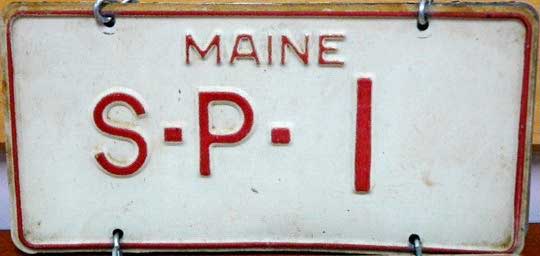 1954-1955 issue. MSP Colonel's plate.
1954-1955 issue. MSP Colonel's plate.
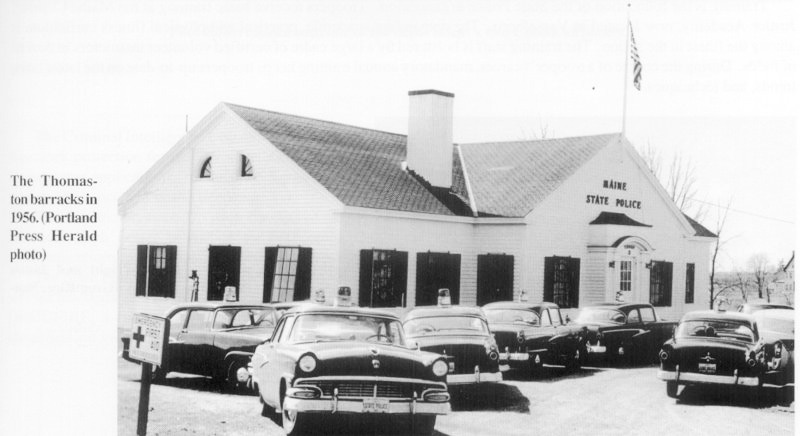
In March of 1955 as the unpopular S-P- prefixed license plates were still being issued, the MSP also commissioned a fully-titled license plate made of the same material and colors. This version, however had STATE POLICE spelled-out in full large dies across the center span of the plate and the assignment number was embossed at the lower center of the plate using a small die. These plates were more well-received by Troopers despite the small assignment number and the new design even attracted media attention as seen below.
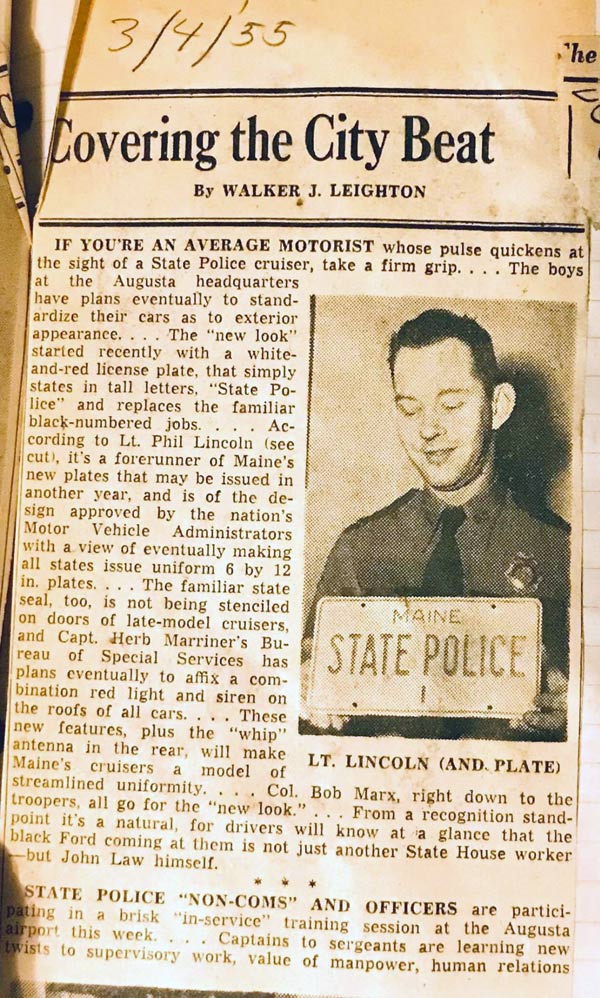
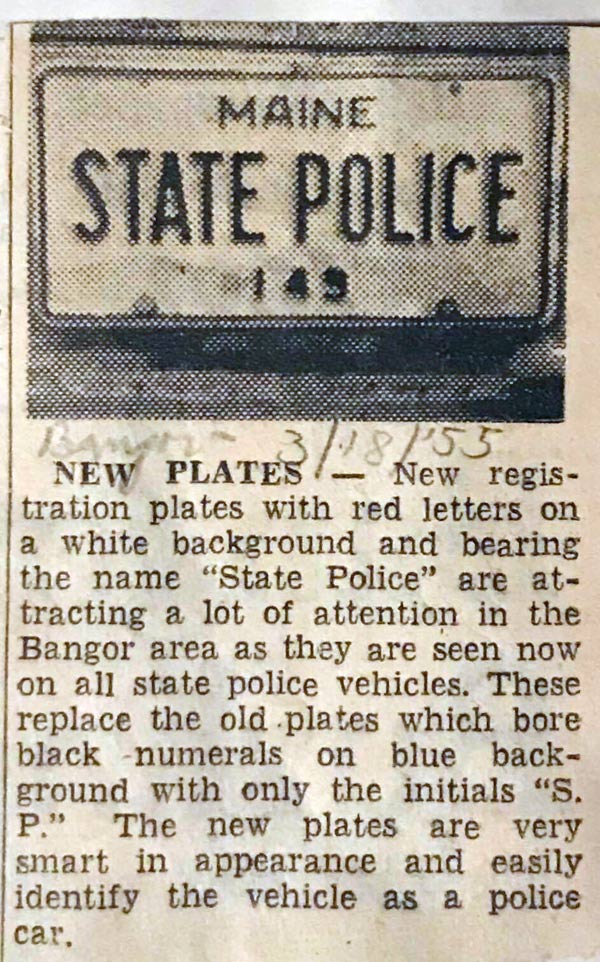
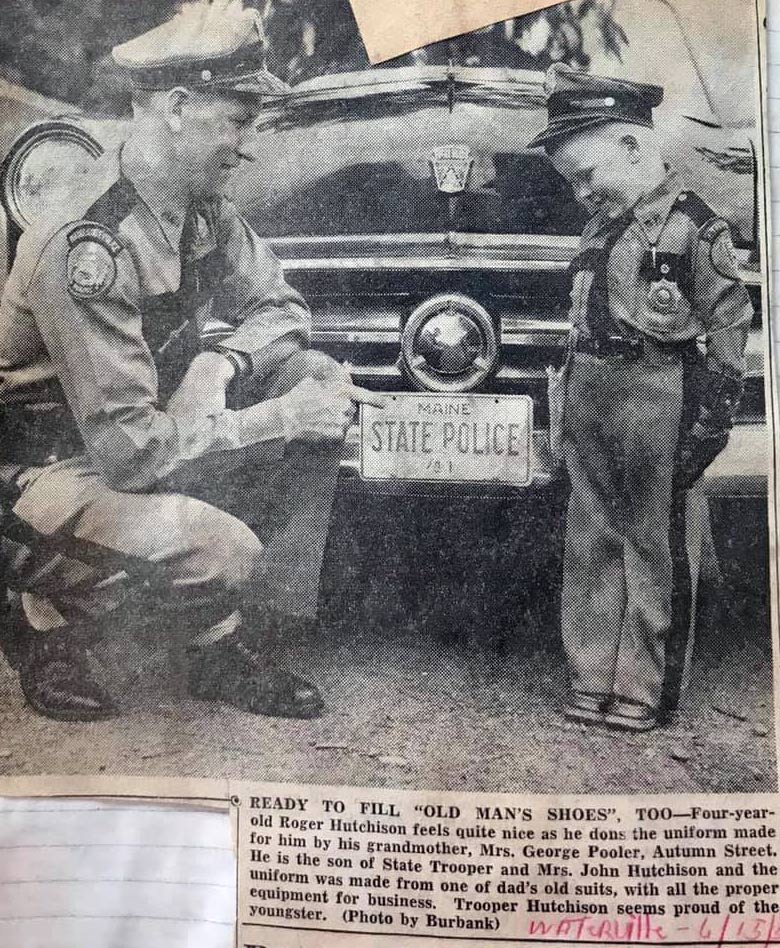 News articles courtesy of Tom Fiske
News articles courtesy of Tom Fiske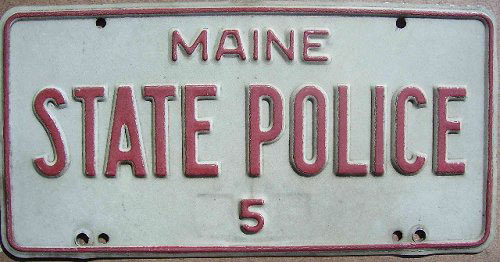 1956-1959 issue.
1956-1959 issue. 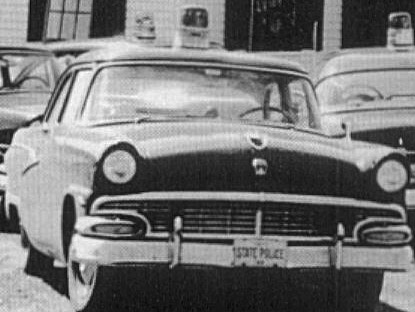
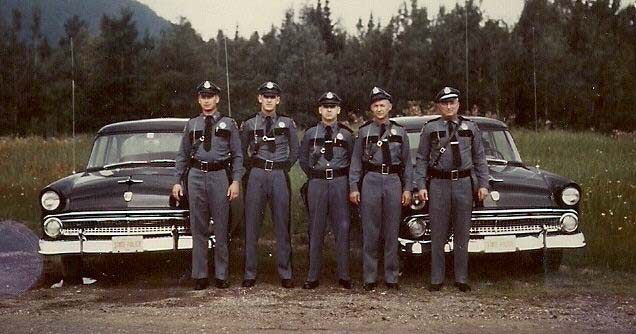 1956-
1956- 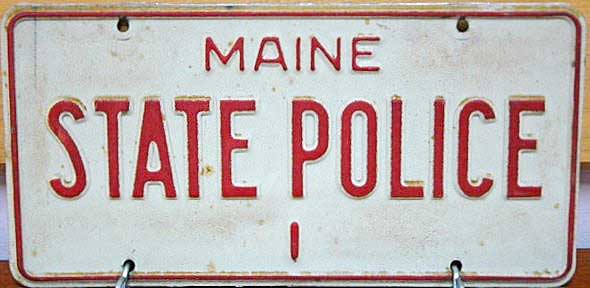 1955-1959 issue. MSP Colonel's plate.
1955-1959 issue. MSP Colonel's plate.
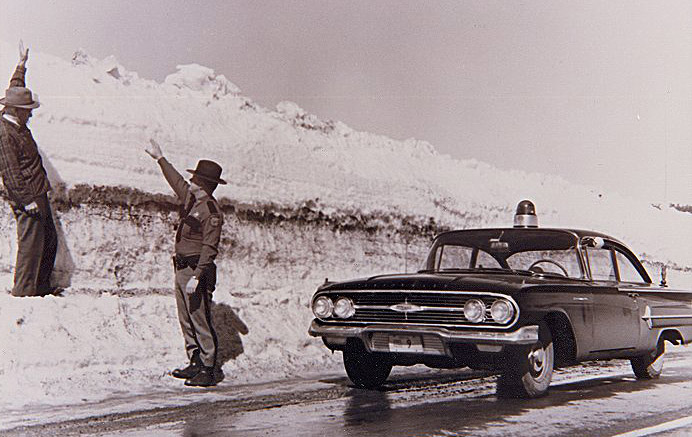
It is believed that in 1960, another re-design of the Maine State Police license plate took place. These plates were made of embossed aluminum and the MSP continued to use the same red over reflective white color scheme. The state name still occupied the top center of the plate but with the title STATE POLICE stacked on the left center field of the plate followed by the assignment number to the right. The earlier versions of this plate used the same finish as the 1956-1959 issue which had a more silver-like reflective background, whereas later versions of this issue had a yellowish tinge. It is not known exactly when the background material changeover took place and it is difficult to determine from black and white photographs taken during that era.
Two sets of each type with the same number (54) are shown just below to show the difference in the background sheeting. These plates are stated to have been used right through the early 1970's.
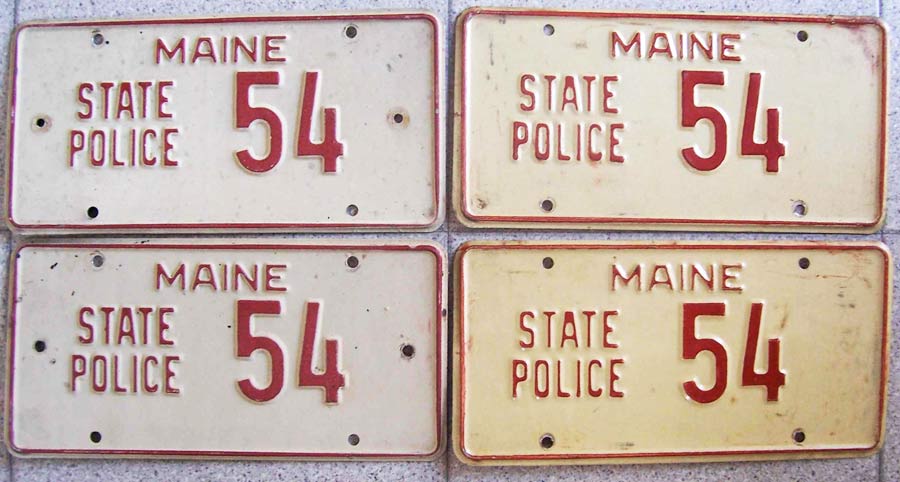
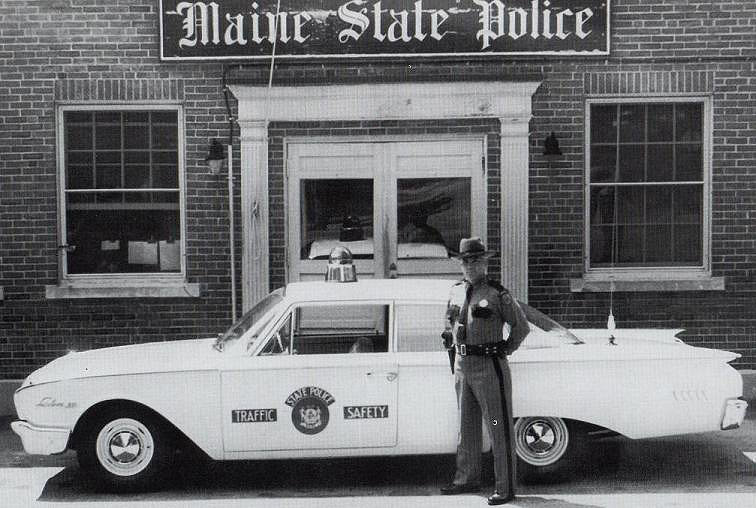
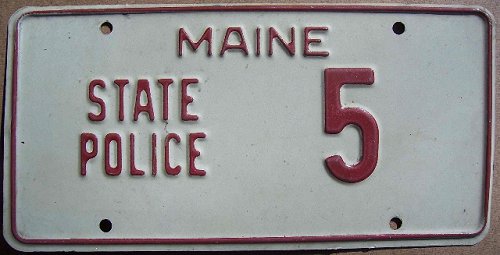 Circa 1960-1970 issue.
Circa 1960-1970 issue. 
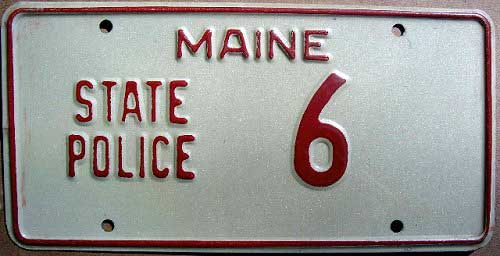 Circa 1960-1970 issue.
Circa 1960-1970 issue. 
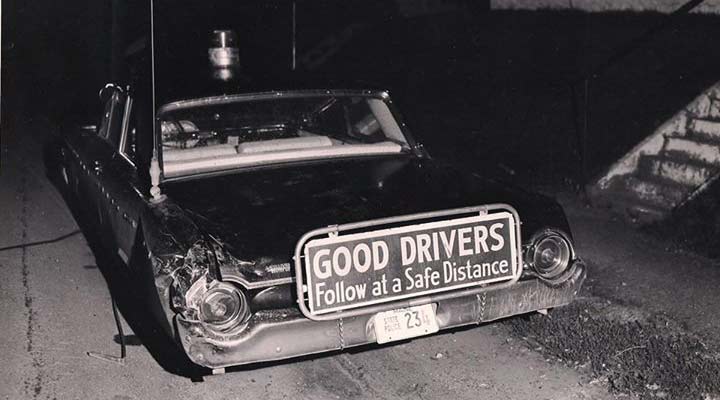 1964 Irony -
1964 Irony - 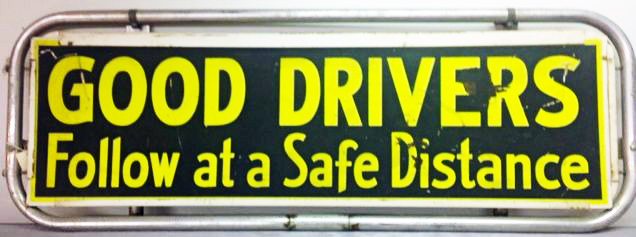 Same type of sign board seen above run on rear of MSP patrol vehicles in the 1960's.
Same type of sign board seen above run on rear of MSP patrol vehicles in the 1960's.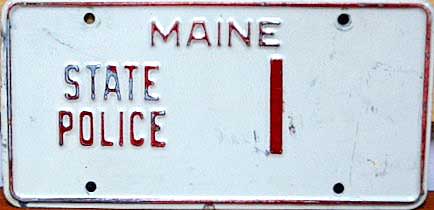 1960-1970 issue. MSP Colonel's plate.
1960-1970 issue. MSP Colonel's plate.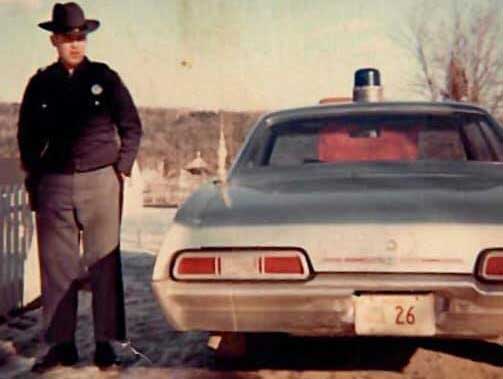 (Courtesy Tom Fiske)
(Courtesy Tom Fiske)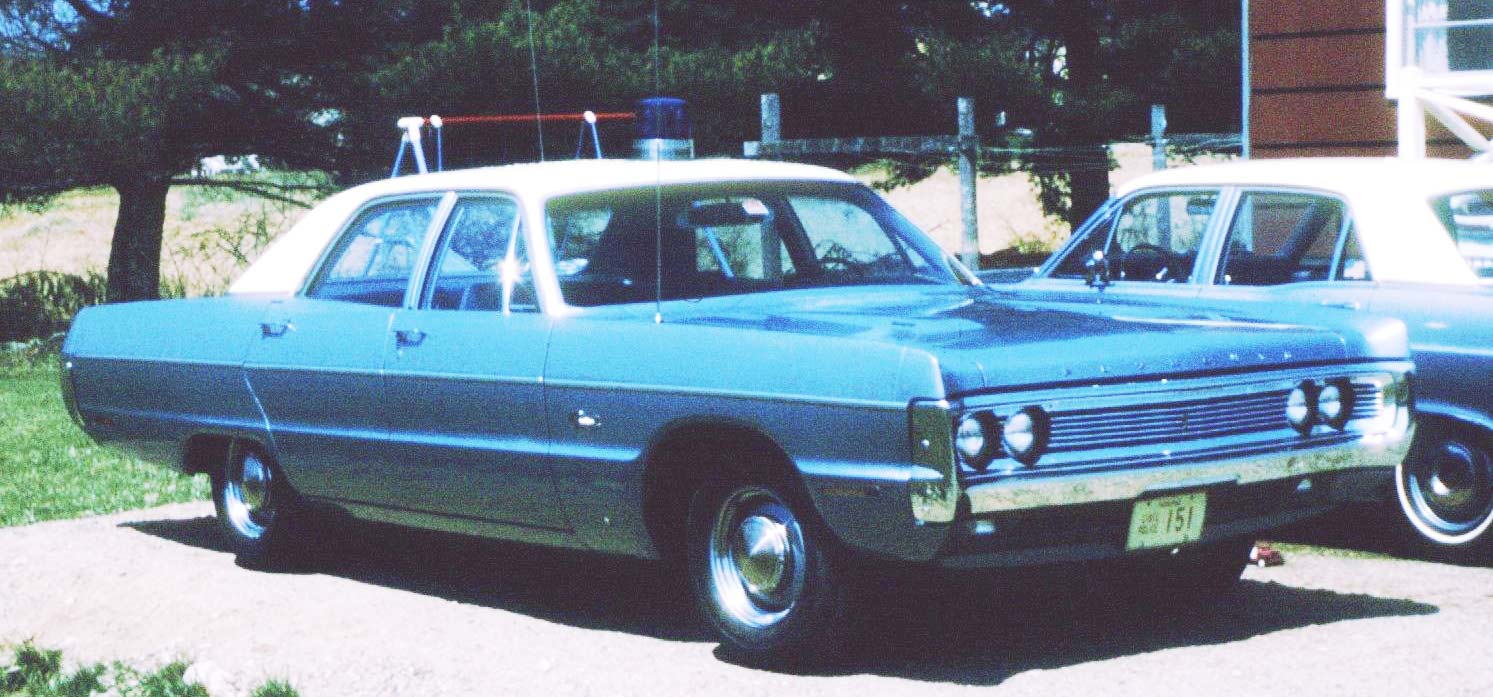 1969
1969 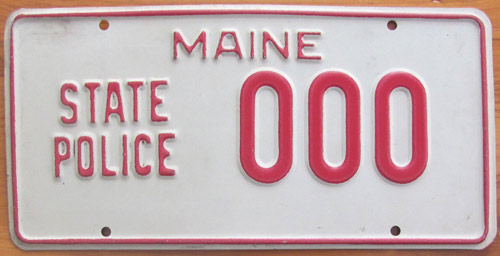 Circa 1960-1970 issue sample.
Circa 1960-1970 issue sample. 
The official launch of the well-known "all-flat" white on blue Maine State Police plate is strangely completely unknown. Some say they began being mounted onto MSP patrol cars as early as 1967/68, and others say they didn't commence issuance until around 1970. It's still anyone's guess as to when this milestone began, but it set the tone and design for decades afterward. Photographic evidence thusfar shows it goes back to at least 1970.
The earliest versions of the "blue plates" saw them manufactured on completley flat aluminum blanks. The layout was simple: MAINE at the top center of the plate, the assignment number in the center and STATE POLICE along the bottom center. What made these earliest versions distinctive from those that followed was the use of an almost Art Deco style font for the lettering and very angular numerals.
By the mid 1970's, the font style was changed to a more fluid-looking font and continues to be used with slight variation to this day.
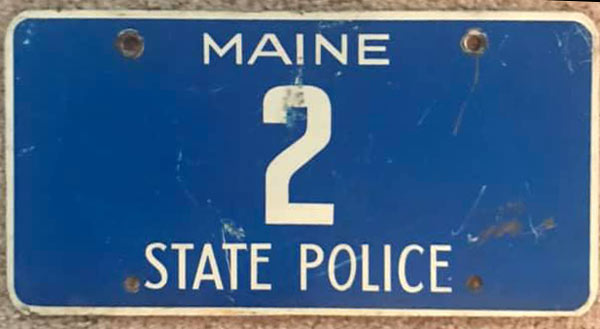 Circa 1970-1976 issue.
Circa 1970-1976 issue. 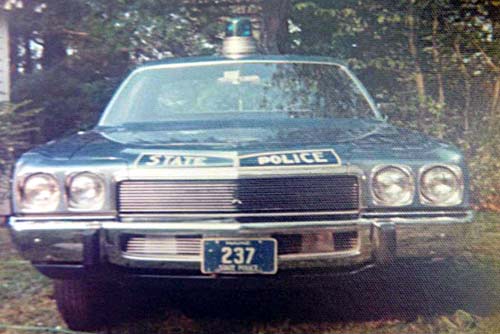 1973
1973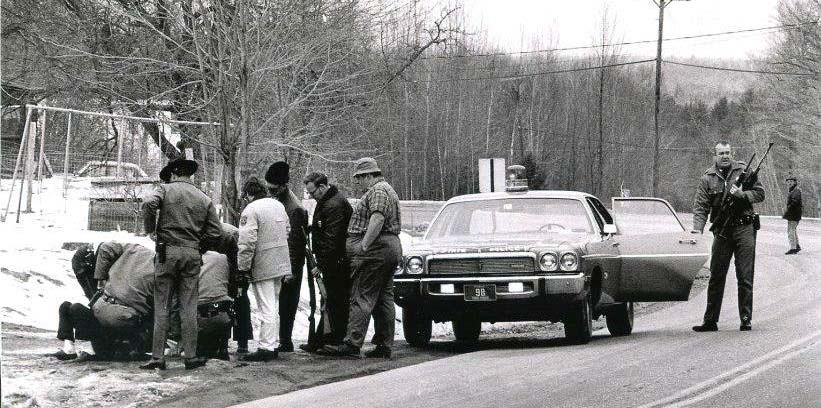 1973
1973 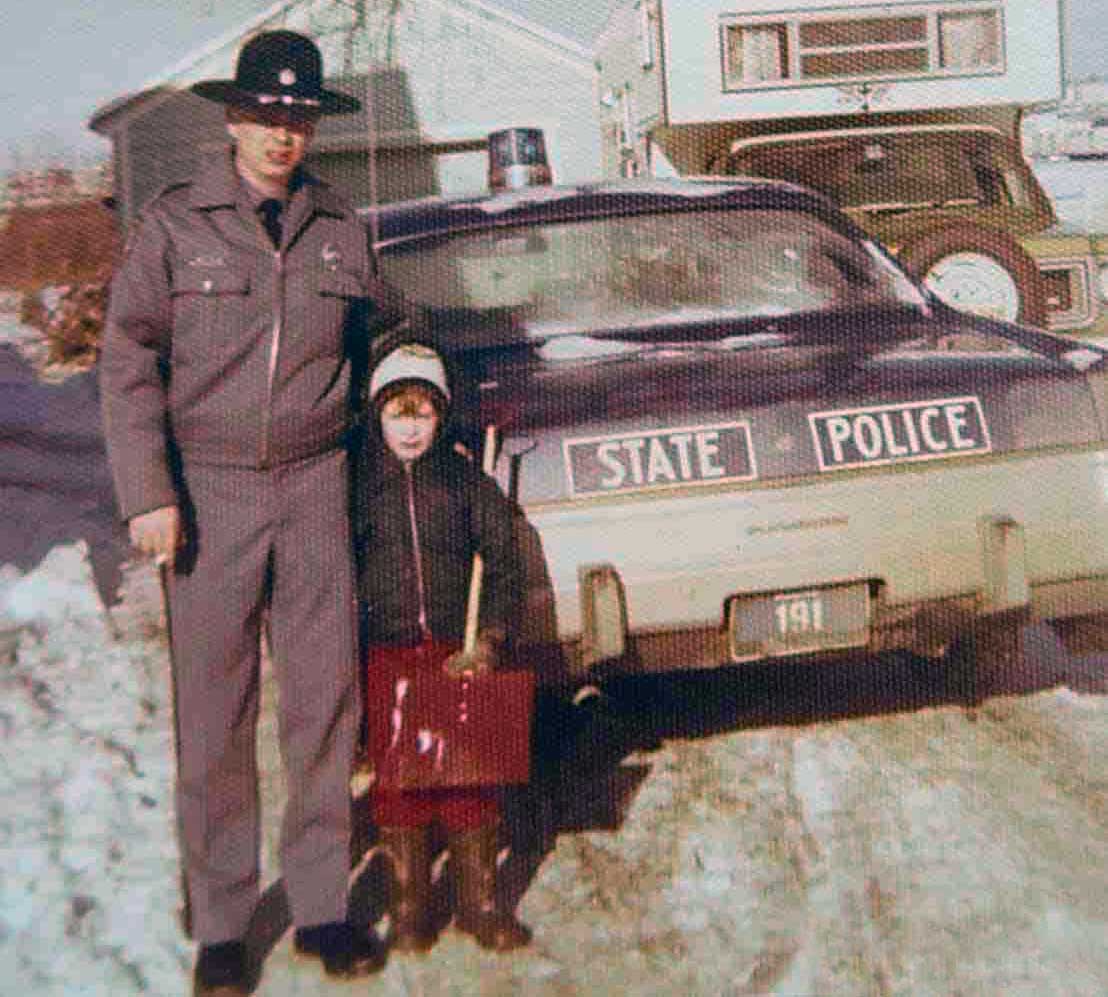 1973
1973 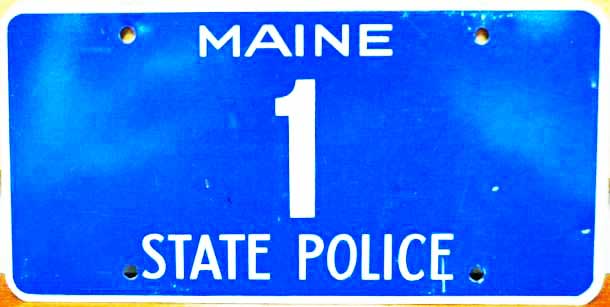 Circa 1970-1976 issue.
Circa 1970-1976 issue. 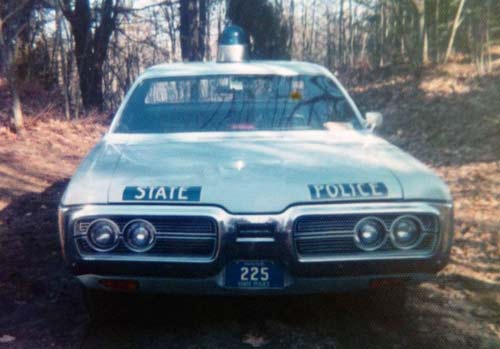 1972
1972  1975
1975 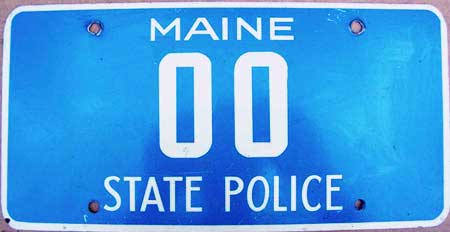 Circa 1970-1976 SAMPLE issue.
Circa 1970-1976 SAMPLE issue. 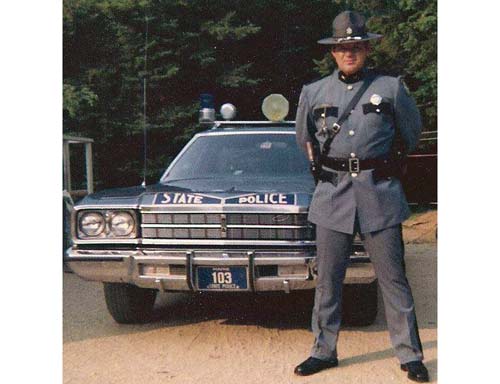
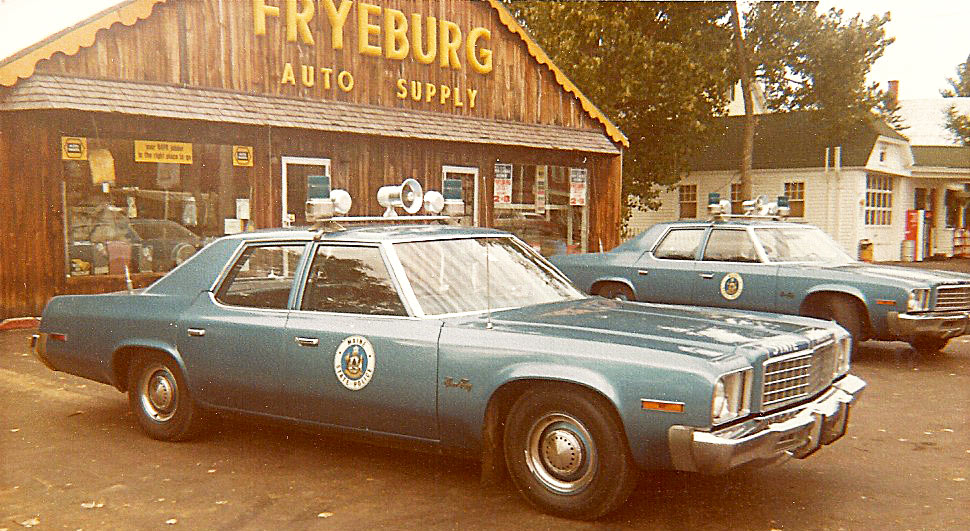
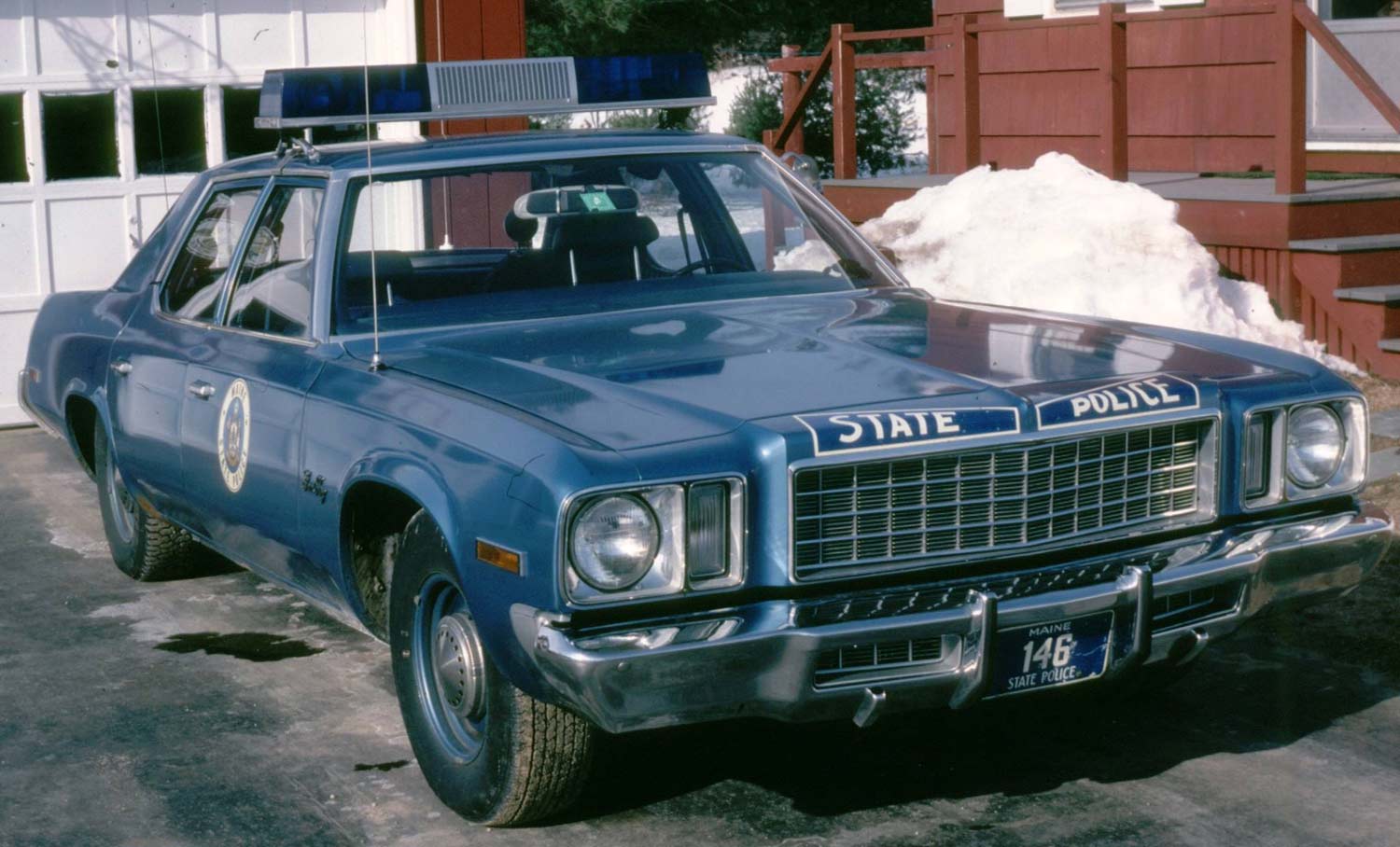 1976
1976 By the mid 1970's MSP license plates continued with the all-flat reflective white over dark blue plates but went to a more utilitarian font for the characters and a larger, rounder font for the numerals.
The MSP license plate numbers issued from this time up until the Summer of 1994 were random and of no particular significance.
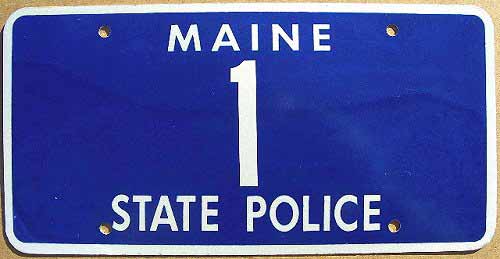 1975-1994 issue.
1975-1994 issue. 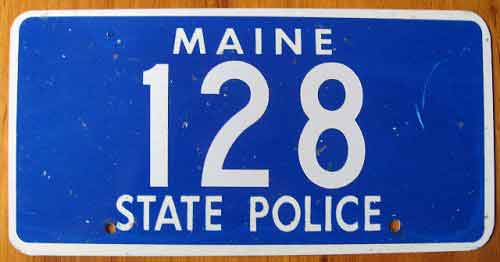 1975-1994 issue. Random number.
1975-1994 issue. Random number.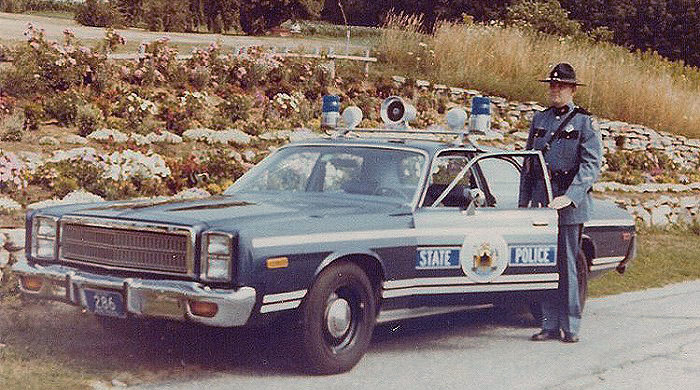
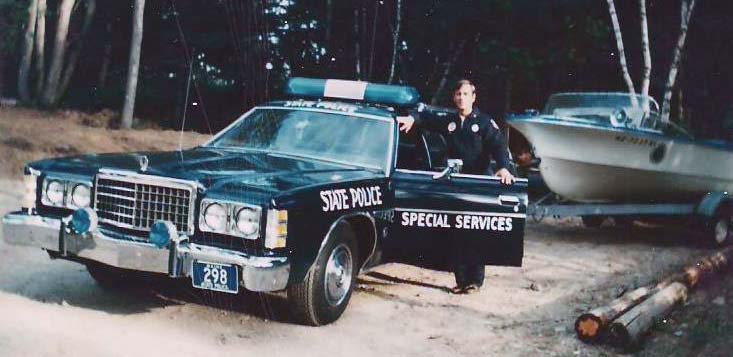 1975 Special Services.
1975 Special Services. 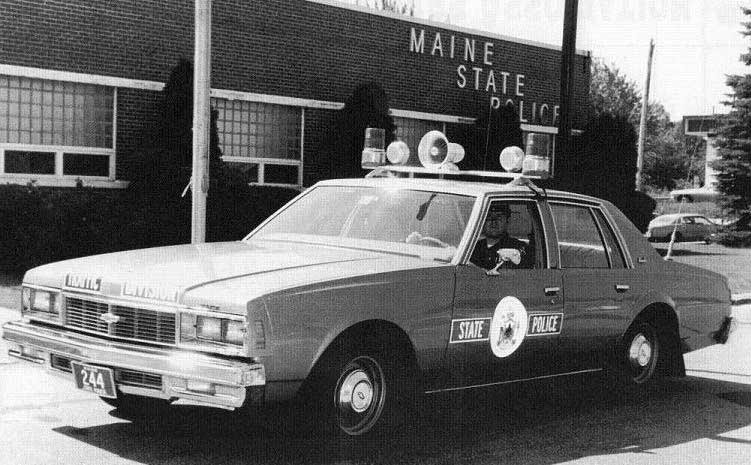
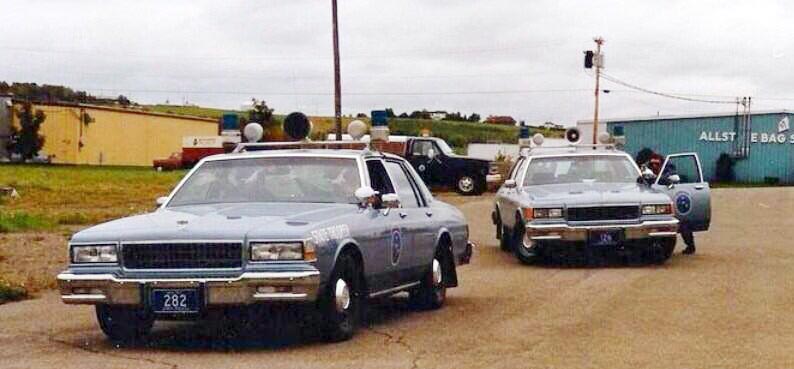
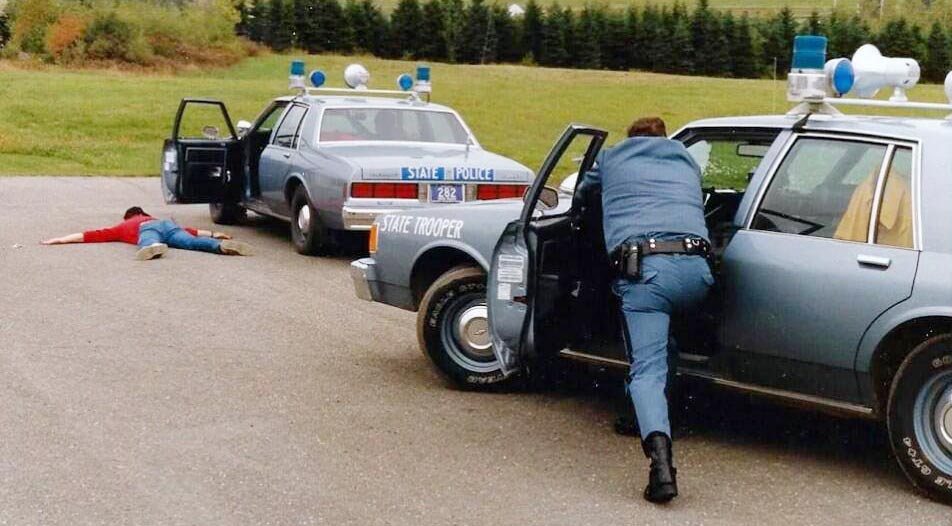
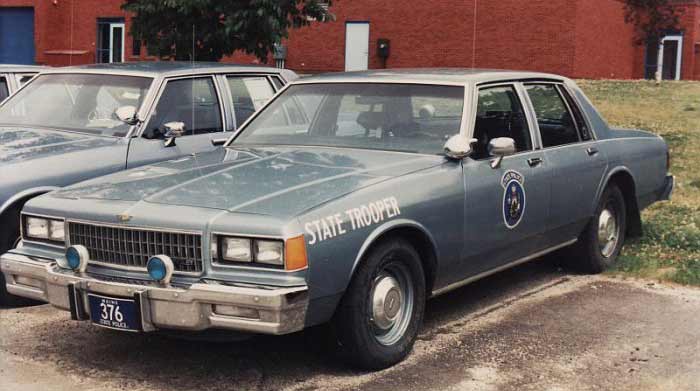
On May 23 1994, Trooper David Preble of Troop E (Orono Barracks) crafted an Inter-departmental memo addressed to the Chief of the Maine State Police, Colonel Alfred R. Skolfield requesting that the Maine State Police consider changing the numbering of MSP license plate numbers from meaningless random numbers to the actual radio call number of the assigned Trooper.
Trooper Preble articulated that not only was this a pragmatic and effective way of identifying an MSP vehicle, but also a morale booster for the rank and file.
Colonel Skolfield responded in writing to Trooper Preble on May 31 1994 not only thanking him for his initative, but agreeing to implement his idea right away!
See Correspondence between Tpr Preble and Colonel Skolfield here.
Therefore, by Summer of 1994, all Maine State Police license plate numbers reflected the radio number of the Trooper or indicated the specialized unit assigned. Even today, when one sees a Maine State Police license plate number, that number signifies a Troop, a rank in some cases, a Section and geographical zones...it even reflects if you are a probationary trooper!
The Maine State Police consists of nine troops which use the following assignment numbers:
100 Series plates: Troop A (Alfred)
200 Series plates: Troop B (Gray)
300 Series plates: Troop C (Skowhegan)
400 Series plates: Troop D (Augusta)
500 Series plates: Troop E (Orono)
600 Series plates: Troop F (Houlton)
700 Series plates: Troop G (Maine Turnpike)
800 Series plates: Troop K (Commercial Vehicle Enforcement)
900 Series plates: Troop J (Ellsworth)
The second number on the license plate indicates a Section (Platoon) within a Troop. Each Troop has 3 Sections with the exception of Troop G (Turnpike) which has 4 (Section 4 is a midnight shift). The Sergeant in charge of the Section is assigned the number 0.
The third number is the geographical patrol zone the trooper is assigned to. This number does not exceed 8.
With manpower issues, this number can become irrelevant as these zones may have staggered deployment on occasion, especially given call-sharing agreements with County Sheriff Departments.
To explain the numbering more clearly, a Troop G (Turnpike) deployment can be explained thusly: Troopers assigned out of Section 1: The Section is lead by a Sergeant who is assigned 701. The Corporal is assigned 710. The "third number" becomes relevant with the assignment of the trooper at the southernost end of the "slot" in Kittery which would be Trooper 711 followed by 712 then 713 and 714 as the patrol area moves northward up the turnpike.
Section 2 would be lead by the Sergeant: 702 followed by the Corporal: 720 then 721, 722, 723 and 724.
In addition to these Troops, the MSP also has Special Units who are also given assignment designations on their license plates:
1000 Series plates are spare cruisers not assigned to a particular troop.
1100 Series plates are for Traffic Division (Inspection/Collision Reconstruction Unit)- Issued but rarely displayed.
1200 Series plates are Detectives (unmarked units) These plates are rarely displayed with the exception of the annual Colonel's Inspection.
2600 Series plates are issued to MSP Academy graduates during their 45 day Field Training period. This number is the probationary trooper's radio number as well as plate number. These plates are issued alphabetically. The recruit whose name is at the A or B end of the alphabet will receive number 2601 and so on down the roster.
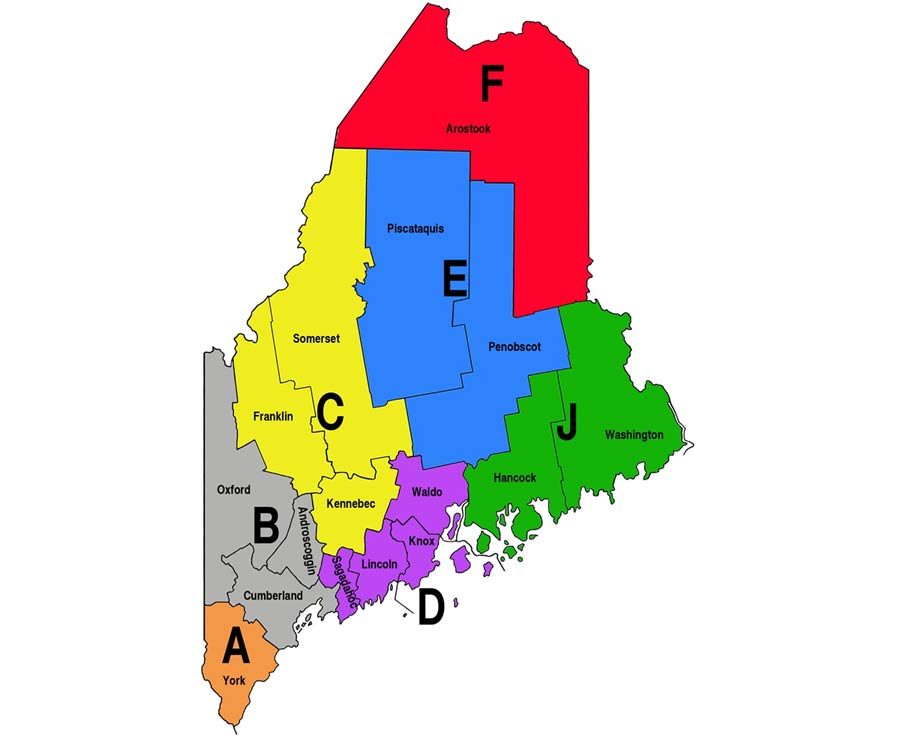
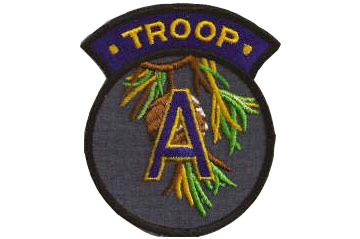
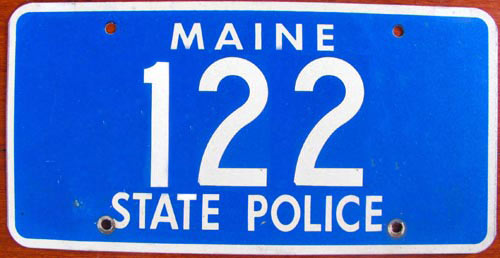 100 Series: Troop A (Alfred)
100 Series: Troop A (Alfred) 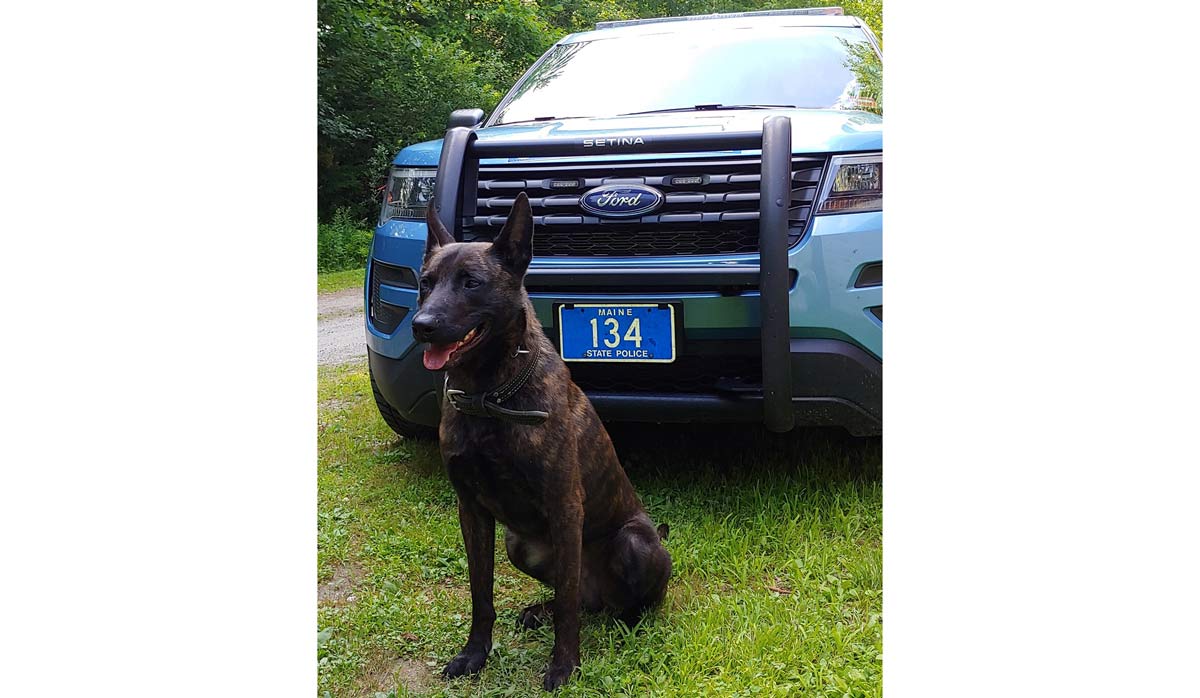
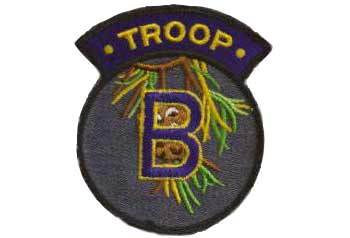
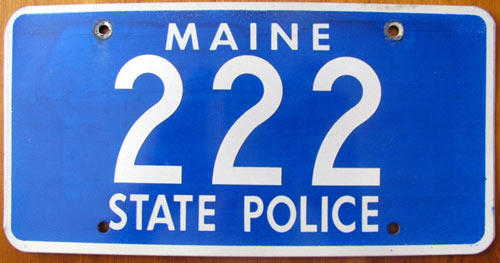 200 Series: Troop B (Gray)
200 Series: Troop B (Gray) 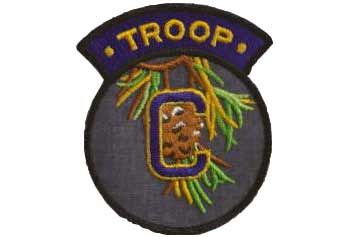
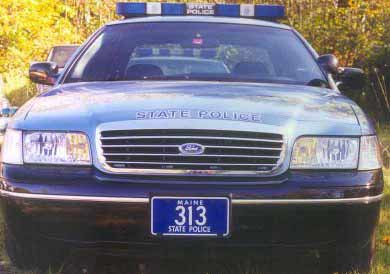 300 Series: Troop C (Skowhegan) Section 1 Zone 3
300 Series: Troop C (Skowhegan) Section 1 Zone 3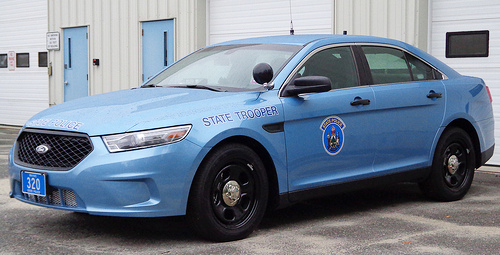

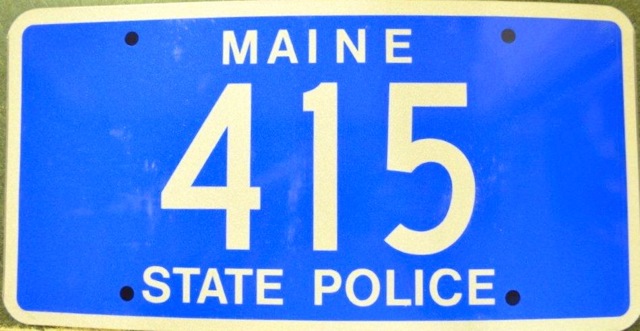 400 Series: Troop D (Augusta)
400 Series: Troop D (Augusta) 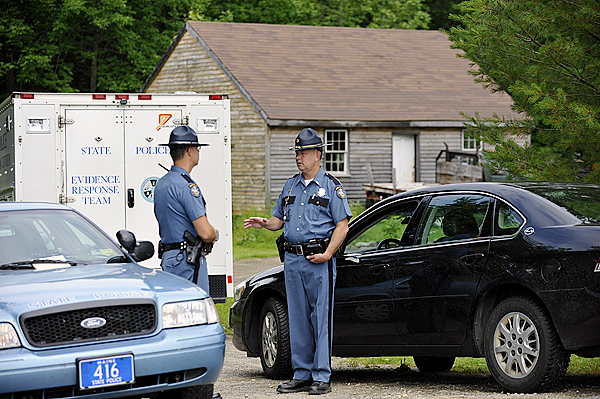
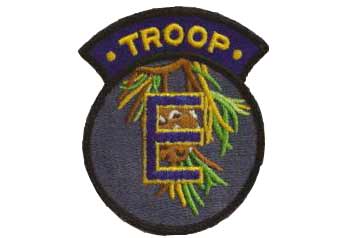
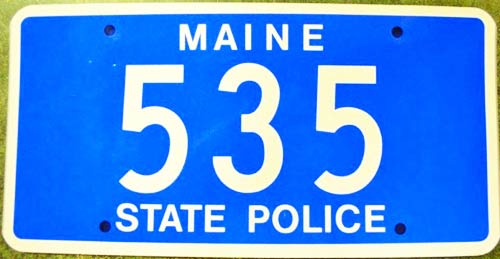 500 Series: Troop E (Orono)
500 Series: Troop E (Orono) 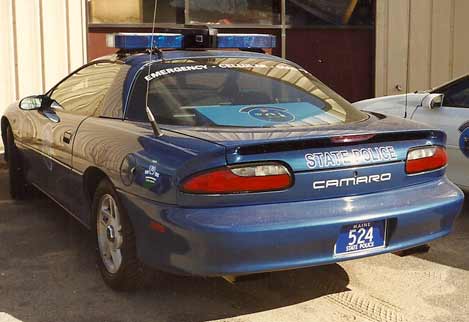
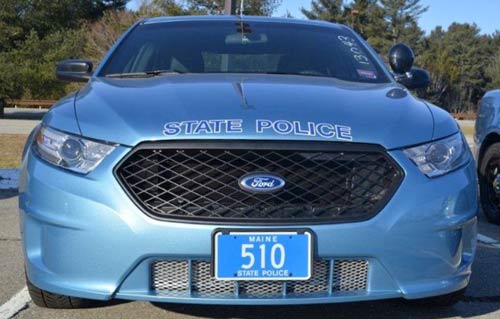 Troop E (Orono) Corporal for Section 1
Troop E (Orono) Corporal for Section 1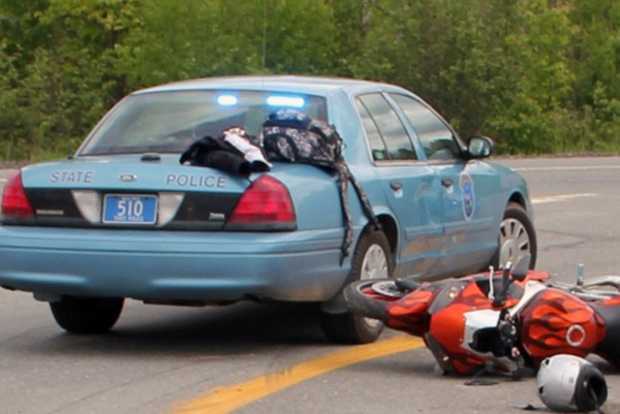
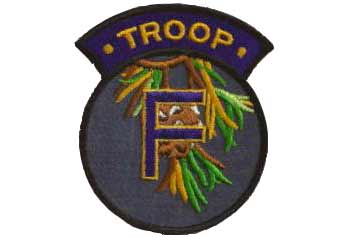
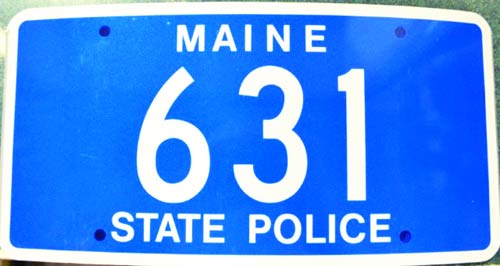 600 Series: Troop F (Houlton)
600 Series: Troop F (Houlton) 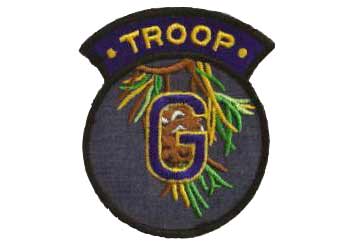
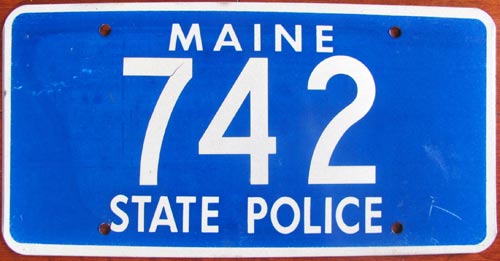 700 Series: Troop G (Maine Turnpike) Section 4 Zone 2
700 Series: Troop G (Maine Turnpike) Section 4 Zone 2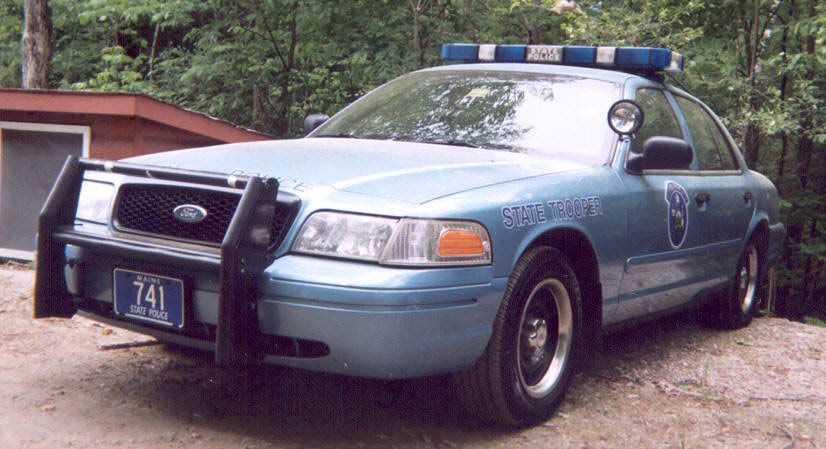
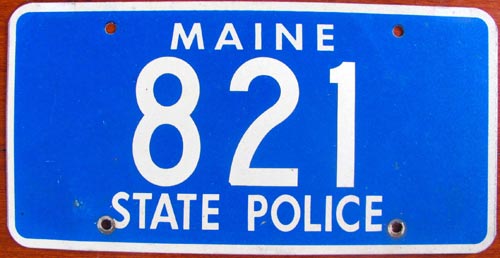 800 Series: Troop K (Commercial Vehicle Enforcement) Section 2 Zone 1
800 Series: Troop K (Commercial Vehicle Enforcement) Section 2 Zone 1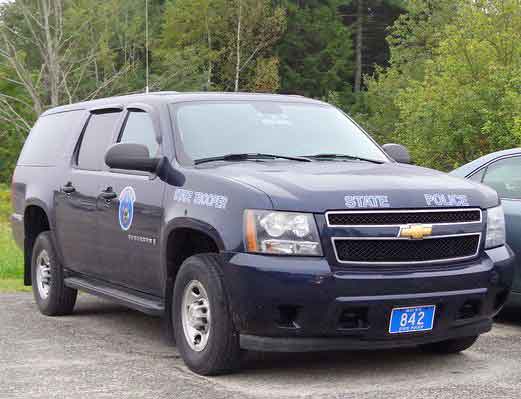
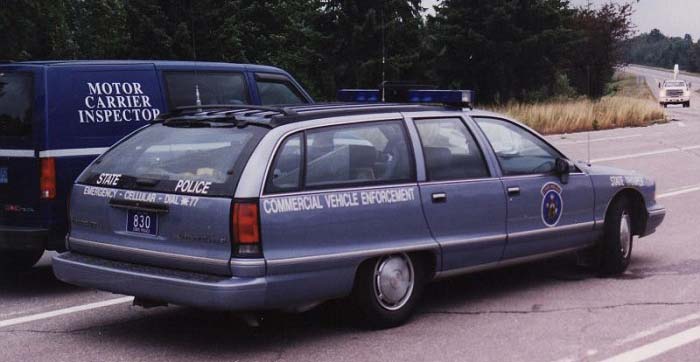
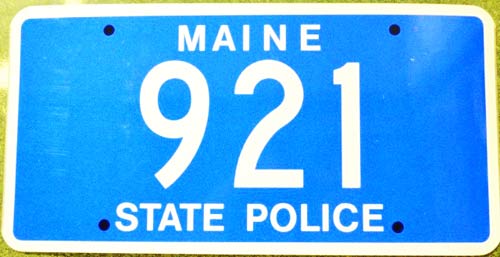 900 Series: Troop J ( Ellsworth) Section 2 Zone 1
900 Series: Troop J ( Ellsworth) Section 2 Zone 1
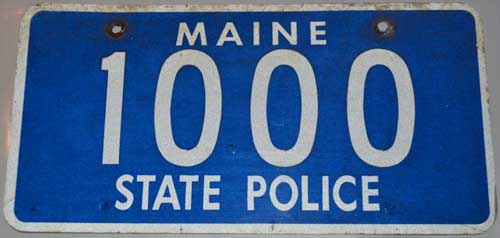 1000 Series: Spare Cruiser.
1000 Series: Spare Cruiser.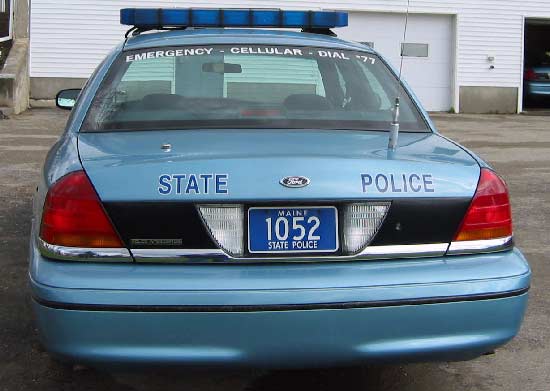 Unassigned Car 52
Unassigned Car 52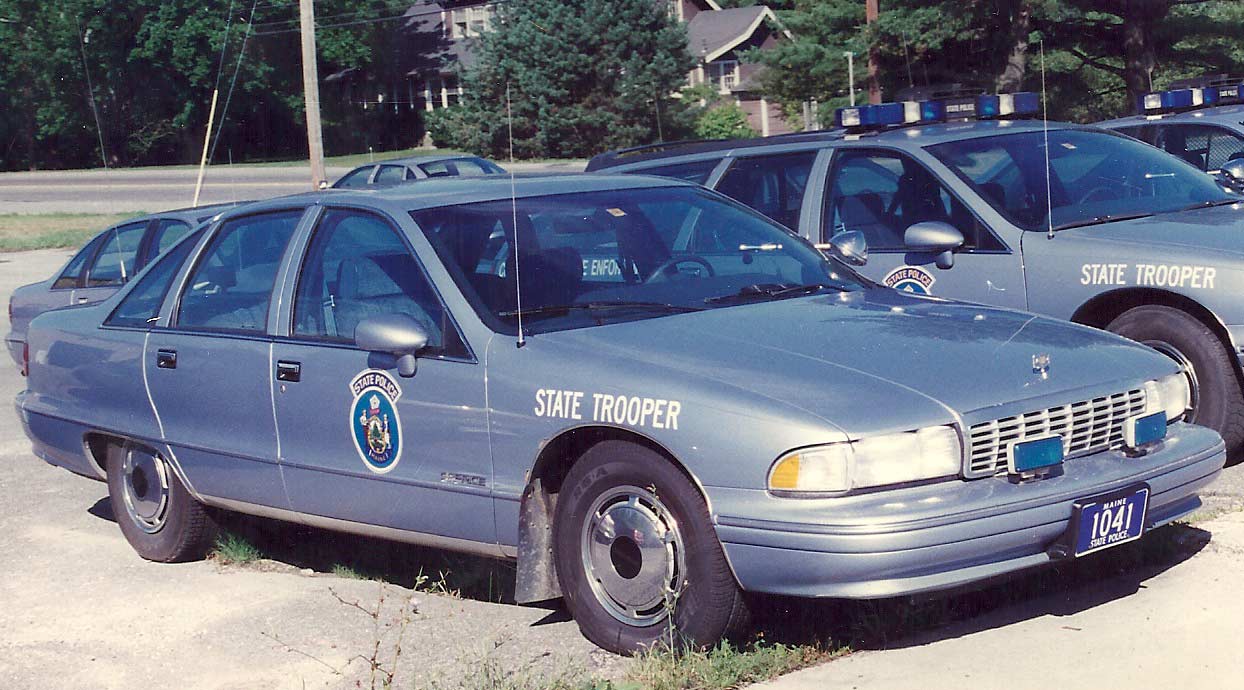
Around 2012, the font used for MAINE and STATE POLICE on MSP license plates was changed. The difference in style is quite subtle but can be seen in the variances on this page.
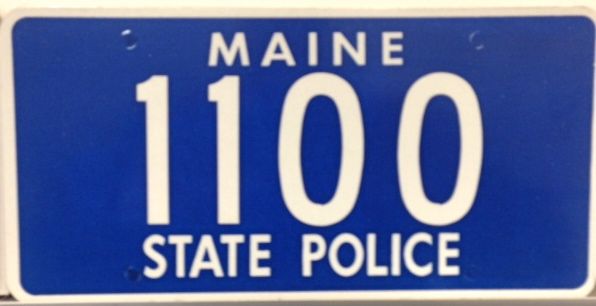 1100 Series: Traffic Division (Inspection/Collision Reconstruction) issue. First in the series.
1100 Series: Traffic Division (Inspection/Collision Reconstruction) issue. First in the series.
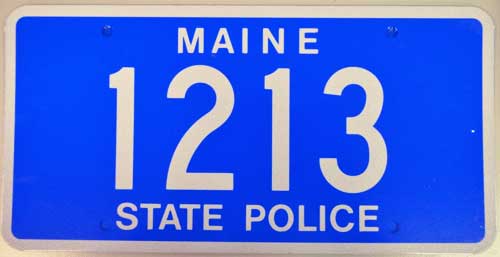 1200 Series: Detective issue.
1200 Series: Detective issue. 
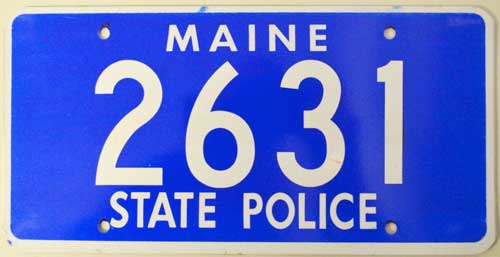 2600 Series: Probationary Trooper/Academy Graduate- Radio Call Sign. Last two digits indicate alphabetical ranking.
2600 Series: Probationary Trooper/Academy Graduate- Radio Call Sign. Last two digits indicate alphabetical ranking.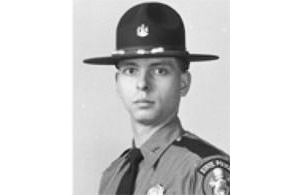 Tpr. Michael R. Veilleux (2631)~Age 24~ End of Watch:June 17, 1986
Officer Down Memorial Page
Tpr. Michael R. Veilleux (2631)~Age 24~ End of Watch:June 17, 1986
Officer Down Memorial Page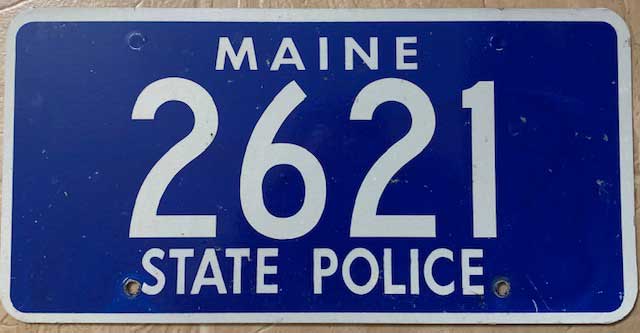 2023 Probationary Trooper 21
2023 Probationary Trooper 21  Preparing for his assigned Troop plate upon passing probation
Preparing for his assigned Troop plate upon passing probation 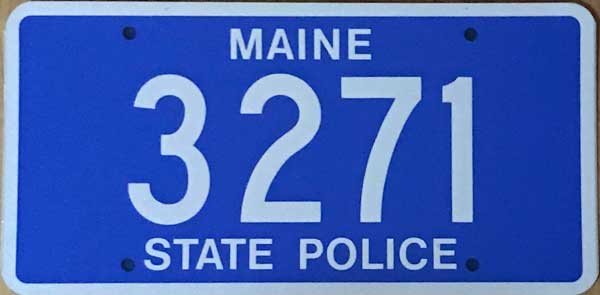 Current issue
Current issue 
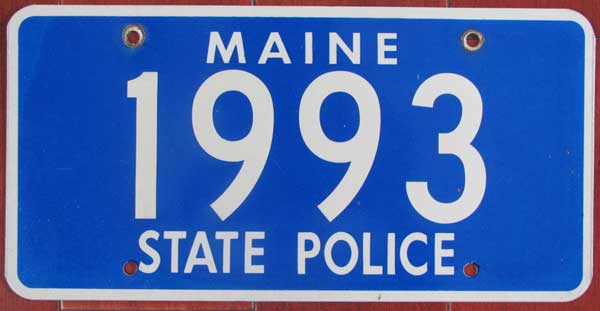 Trooper of the Year issue for 1993.
Trooper of the Year issue for 1993.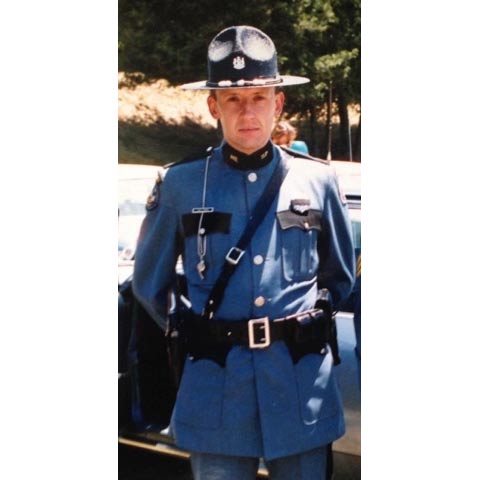
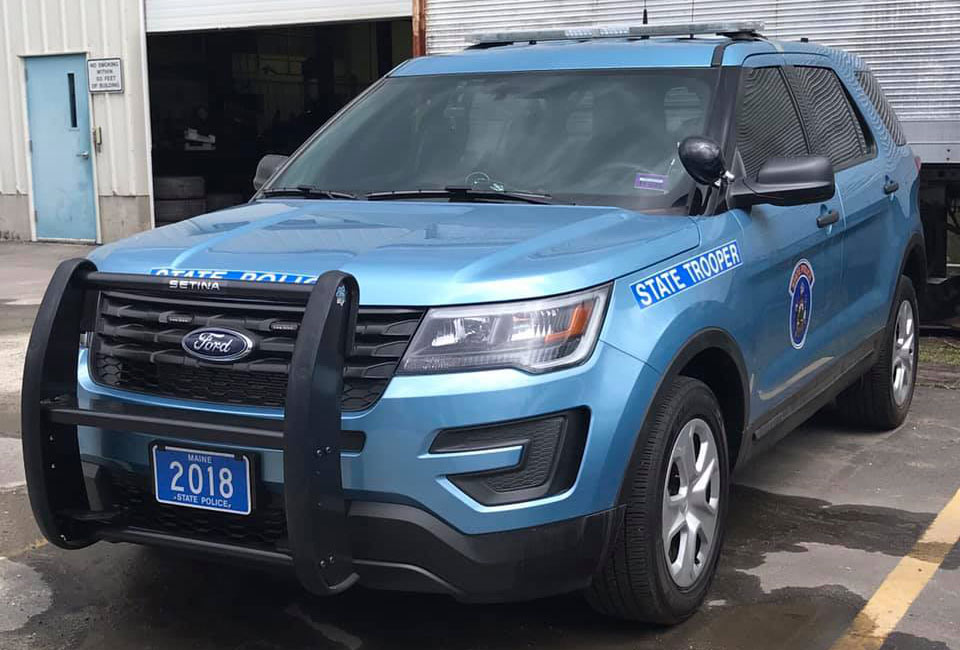 2018 Maine State Police Trooper of the Year- Corporal Adam Schmidt of Troop A
2018 Maine State Police Trooper of the Year- Corporal Adam Schmidt of Troop A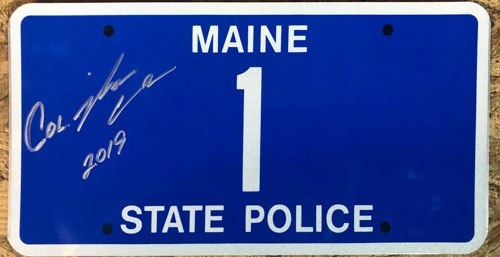 Autographed by Colonel John Cote' (2019)
Autographed by Colonel John Cote' (2019)

Some vehicles in the MSP fleet assigned to specialized duties have specific prefixes to indicate their given specialty. These plates are the same manufacture as their contemporary Troop plates.
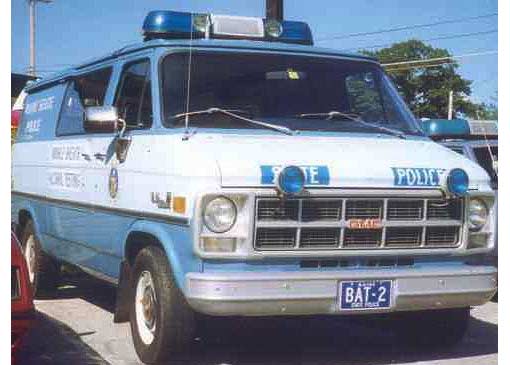 Breath Alcohol Testing- Vehicle 2
Breath Alcohol Testing- Vehicle 2 The BAT Van- Circa 1988
The BAT Van- Circa 1988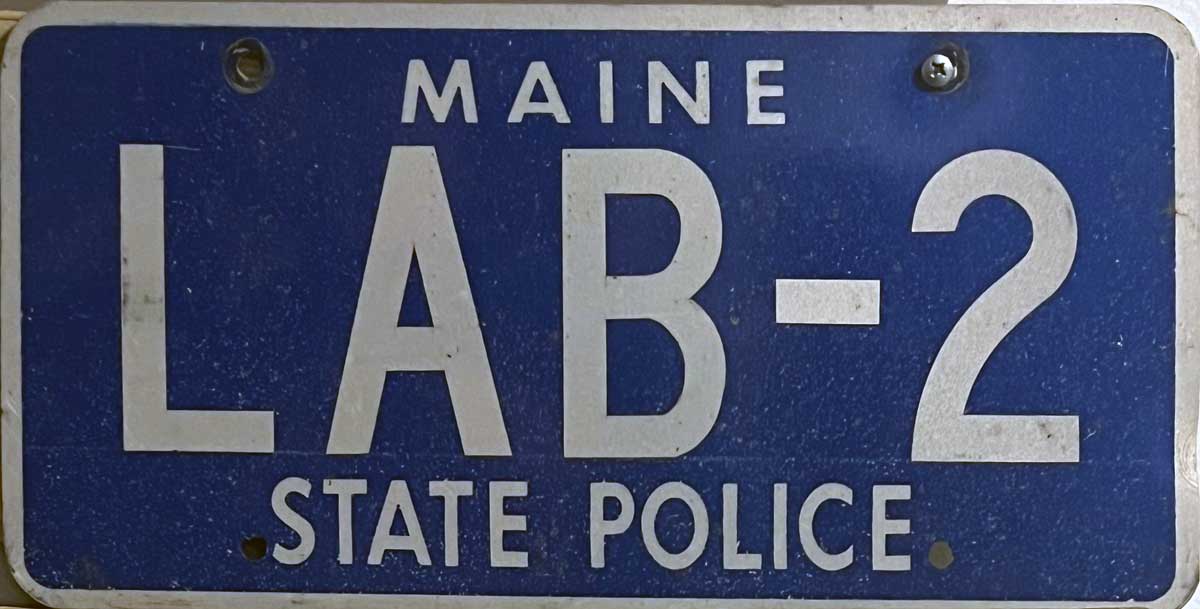 LAB Prefix for Crime lab on Mobile Command Unit seen below
LAB Prefix for Crime lab on Mobile Command Unit seen below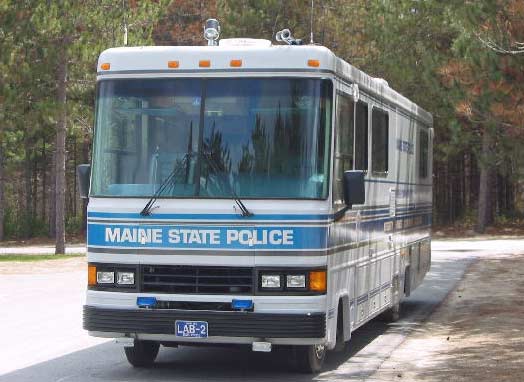 LAB Prefix for Crime lab on Mobile Command Unit
LAB Prefix for Crime lab on Mobile Command Unit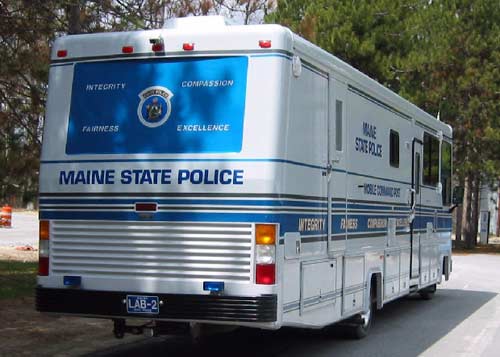 LAB Prefix for Crime lab on Mobile Command Unit
LAB Prefix for Crime lab on Mobile Command Unit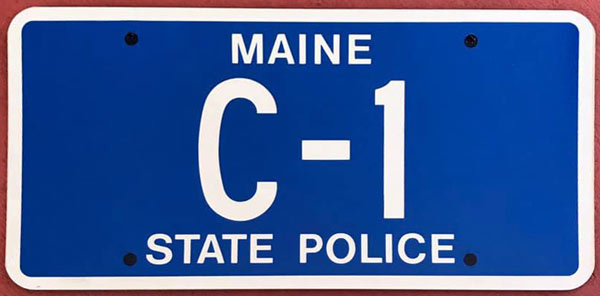 Commissioner of Public Safety.
Commissioner of Public Safety.
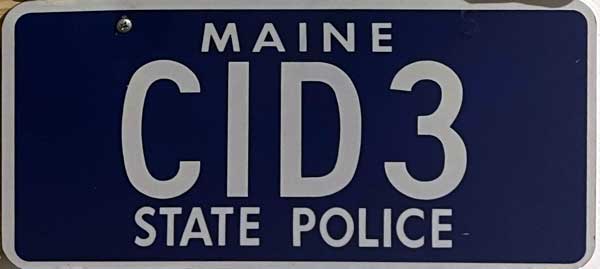 Criminal Investigation Division
Criminal Investigation Division
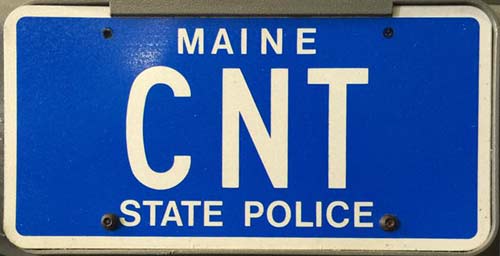 Crisis Negotiation Team
Crisis Negotiation Team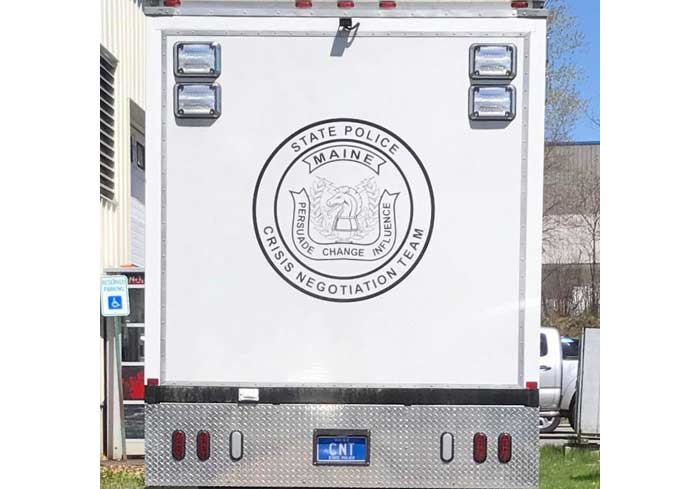 (Courtesy Tom Fiske)
(Courtesy Tom Fiske)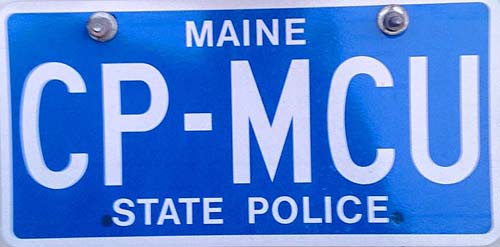 Command Post- Mobile Command Unit
Command Post- Mobile Command Unit
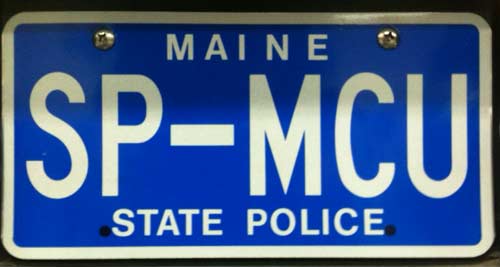 New version for Mobile Command Unit
New version for Mobile Command Unit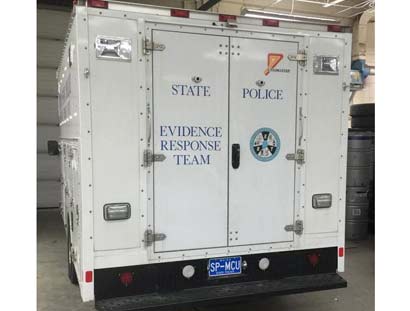
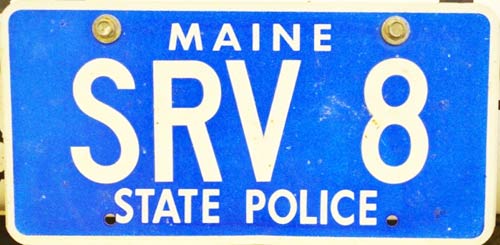 Special Response Vehicle
Special Response Vehicle
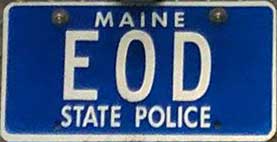 Explosive Ornance Disposal
Explosive Ornance Disposal 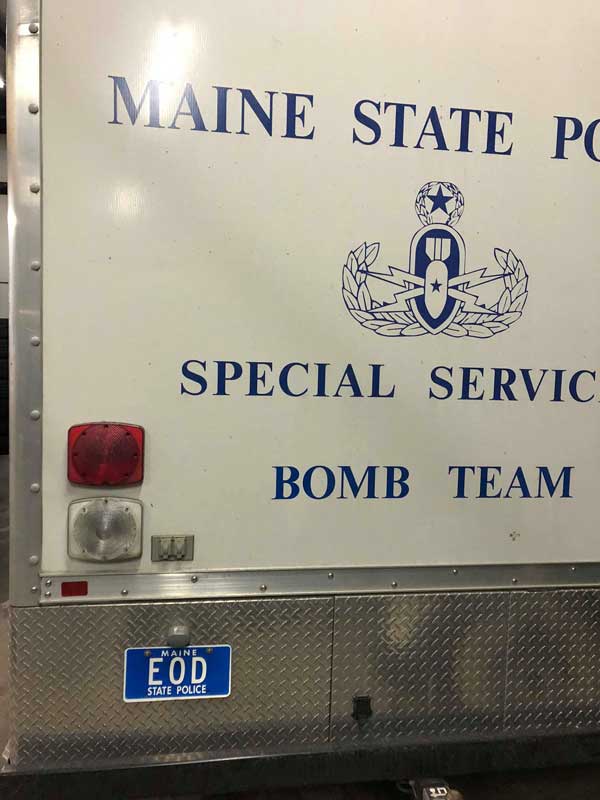 (Courtesy Jim Aitken)
(Courtesy Jim Aitken) 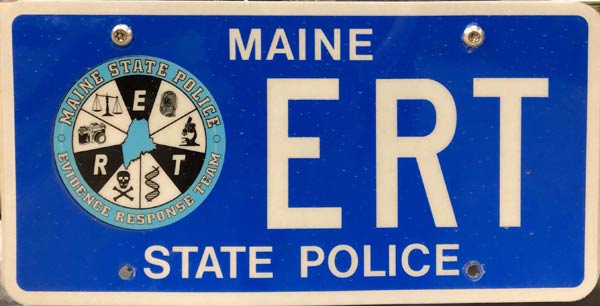 Evidence Response Team
Evidence Response Team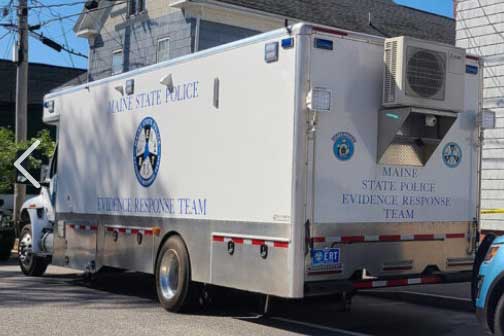 (Courtesy Jim Aitken)
(Courtesy Jim Aitken)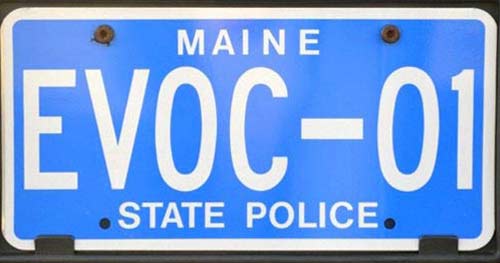 Emergency Vehicle Operators Course (Driving School!)
Emergency Vehicle Operators Course (Driving School!)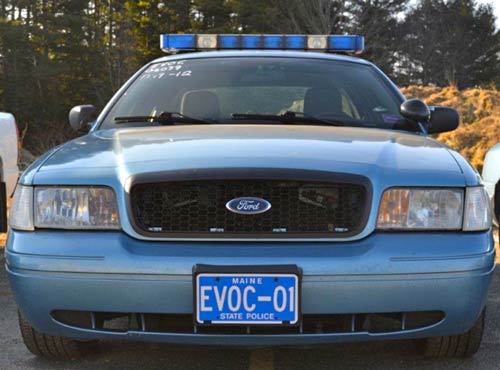
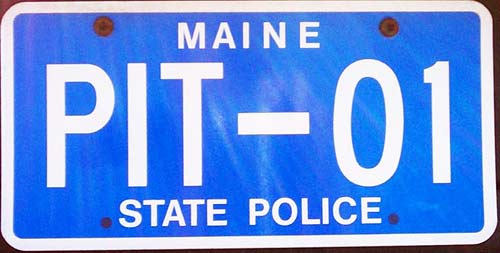 Precision Immobilization Technique training car
Precision Immobilization Technique training car
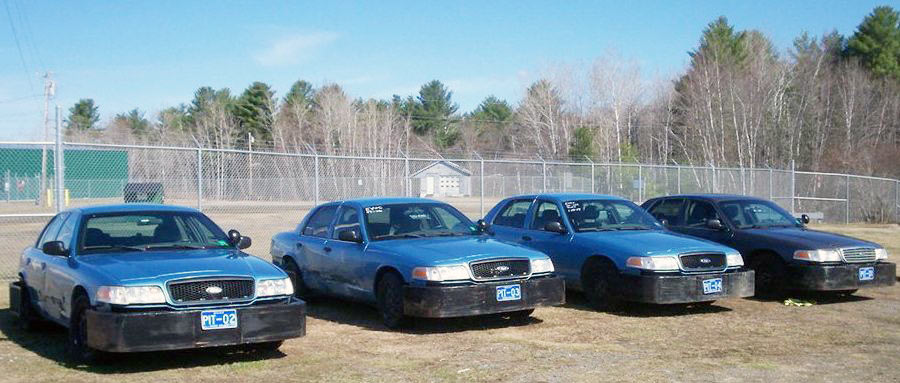
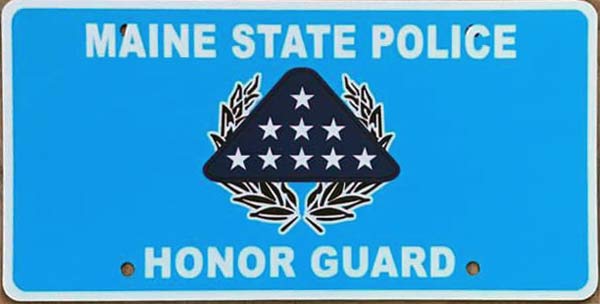 Honor Guard Front Plate
Honor Guard Front Plate
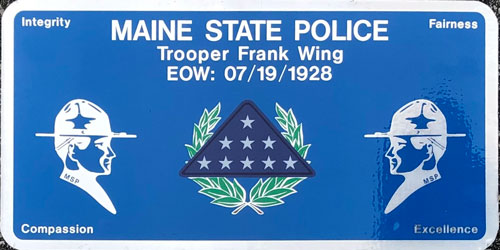 Honor Guard plate for fallen Trooper Frank Wing Ceremony
Honor Guard plate for fallen Trooper Frank Wing Ceremony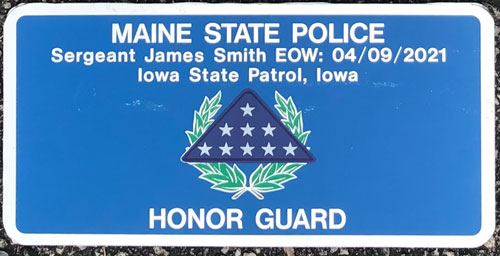 Honor Guard plate for fallen Iowa SP Sgt James Smith Ceremony
Honor Guard plate for fallen Iowa SP Sgt James Smith Ceremony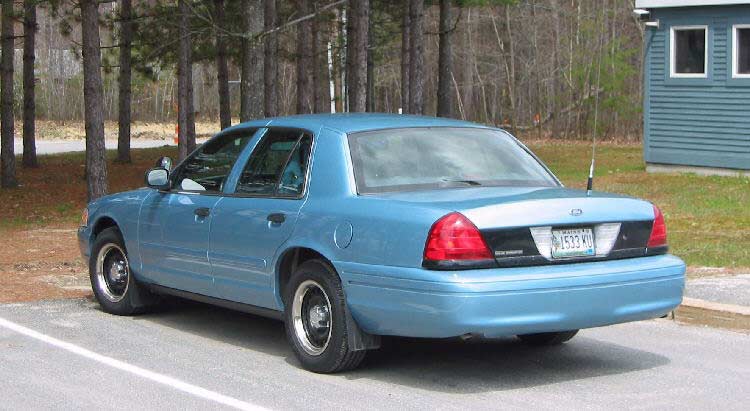
In preparation for the MSP's 90th Anniversary, the Maine State Troopers Association made arrangements with 3M to have these attractive commemorative license plates seen below manufactured. MSP Troopers had the option of purchasing them for $20 a pair and were permitted to retain them when the anniversary was completed and the return to regular MSP plates to their patrol vehicles was mandated.
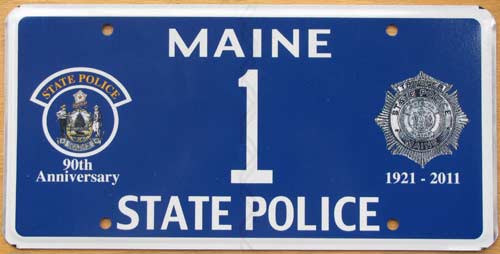 2011 issue.
2011 issue. 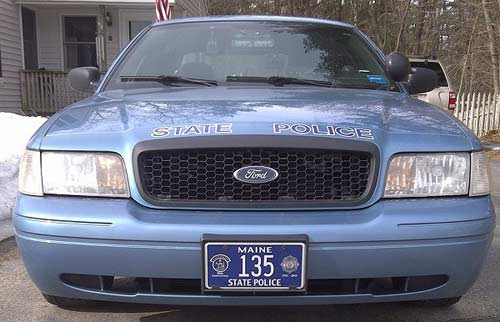 (Courtesy Doug Cropper)
(Courtesy Doug Cropper) Prototype Number 1 license plate with color scheme similar to that of the National Troopers Coalition souvenir plates made for the 2002 event.
Prototype Number 1 license plate with color scheme similar to that of the National Troopers Coalition souvenir plates made for the 2002 event.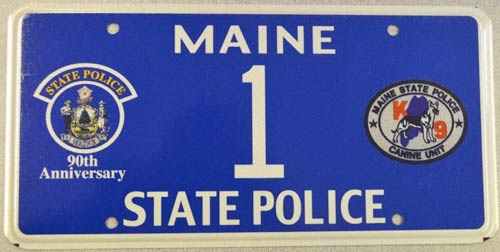 Prototype Number 1 90th Anniversary K-9 issue.
Prototype Number 1 90th Anniversary K-9 issue. Prototype Number 1 90th Anniversary Tactical Team issue.
Prototype Number 1 90th Anniversary Tactical Team issue.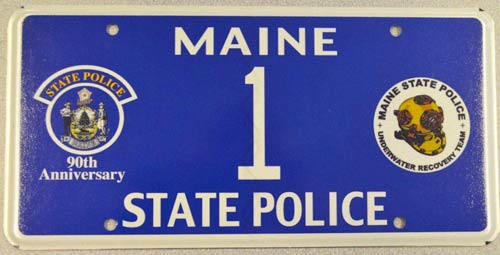 Prototype Number 1 90th Anniversary Underwater Recovery Team issue.
Prototype Number 1 90th Anniversary Underwater Recovery Team issue.In late 2012, MSP Sergeant and Trooper's Association President Mike Edes had an idea to showcase the cause for breast cancer awareness as a special license plate that would be run on all MSP marked vehicles for the month of October 2013 which is breast cancer awareness month.
 Sgt Edes was able to get Colonel Robert A. Williams on board for the idea, and on October 1 2013, the first Maine State Police "Pink Ribbon" license plate was affixed to a marked MSP patrol car.
Sgt Edes was able to get Colonel Robert A. Williams on board for the idea, and on October 1 2013, the first Maine State Police "Pink Ribbon" license plate was affixed to a marked MSP patrol car.
The best way to provide the background to this groundbreaking effort, is to have Sgt Edes (now retired) explain it in his own words:
"In the fall of 2012, a long time dispatcher and close friend of mine who works with the Maine State Police, was diagnosed with breast cancer. As she began her treatments, it got me thinking about the number of people that I knew, who had been affected directly, or indirectly by breast cancer. It struck me that I literally knew dozens of people, whose lives had been affected by this disease. The wife of a trooper I worked with, along with a close high school classmate of mine, both had gone through long and trying treatments for breast cancer, including double mastectomies. I thought to myself that while the first thing you say to a person who is ill and facing a terrible disease such as breast cancer is: "let me know if there is anything I can do ", that you don't usually end up helping and they end up fighting this thing alone or with just a small circle of friends or family. I knew I wanted to get involved, to help and I wanted to make a difference. So I started reading up about breast cancer, it's diagnosis and it's treatment.
The one thing I found consistently in my research is that all the experts stressed that early detection was the key factor in successful diagnosis and treatment of breast cancer. From there, the idea of bringing about awareness of early detection was the theme that I was going to run with. Having travelled extensively across the country through my position as President of the Maine State Trooper's Association and as Chairman of the National Trooper's Coalition, I had seen past examples of health and safety awareness issues on the sides of patrol cars or on license plates. Having experience creating novelty license plates in the past for conferences, association members etc, I knew that creating a breast cancer plate was the idea of what I wanted to run with. Thus, I created the Maine State Police Breast Cancer Awareness plate.
In the spring of 2013, I approached Colonel Bob Williams and Lt. Colonel Ray Bessette of the Maine State Police with the concept of a breast cancer awareness plate to be displayed on the cruisers of the Maine State Police for the month of October (Breast Cancer Awareness month). To their credit, they both immediately bought into the idea and let me run with it. It was agreed that the final design of the plate was at the approval of the State Police Administration and that publicly, we would have to say that this project was being headed up by the Maine State Trooper's Association. We did this for a reason and that being, because no good deed goes unpunished. We knew and expected that somebody(s), would complain about public funds being spent and why wasn't their particular medical or social cause taken in consideration. Sure enough, we did in fact receive a few complaints, but those were relatively few and far between.
The license plates were manufactured by 3M and were made of silkscreened aluminum with a step border.
MAINE STATE POLICE was silkscreened in blue between the upper mounting holes of the plate and "early detection saves lives silkcreened in blue between the lower mounting holes.
A silhouette of the state of Maine was silkscreened in dark pink on the left center portion of the plate with a light pink ribbon superimposed thereon. The unit number was silkscreened in pink in the center field of the plate. The emblem of the Maine State Police was silkscreened in pink on the right center portion of the plate.The numbers were not assigned by Troop and the numbers were issued randomly.
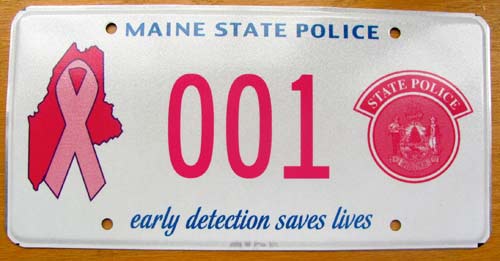 400 sets of Breast Cancer Awareness plates were created, along with a Certificate of Authenticity signed by both the Colonel and the Association President. The plates were displayed on all Maine State Police cruisers during the month of October of 2013. At the end of month, the plates were removed and each MSP trooper was allowed to keep one of the plates for themselves. The trooper then had the choice of either buying the 2nd plate for $20 or turning it back into the Association for public auction. Most of the troopers decided on turning the 2nd plate in for auction and raising money for breast cancer research. Each trooper signed the back of the plate, wrote down their name, academy class number, date of hire and rank. Some of the specialty trooper, such as the K9 officers, even went as far putting their dogs paw prints on the plates as well.
The plates were eventually and individually auctioned off on Ebay. Through the sale of the plates to individual troopers or through the Ebay auction, we were able to raise well over $50,000 for The Maine Cancer Center.
400 sets of Breast Cancer Awareness plates were created, along with a Certificate of Authenticity signed by both the Colonel and the Association President. The plates were displayed on all Maine State Police cruisers during the month of October of 2013. At the end of month, the plates were removed and each MSP trooper was allowed to keep one of the plates for themselves. The trooper then had the choice of either buying the 2nd plate for $20 or turning it back into the Association for public auction. Most of the troopers decided on turning the 2nd plate in for auction and raising money for breast cancer research. Each trooper signed the back of the plate, wrote down their name, academy class number, date of hire and rank. Some of the specialty trooper, such as the K9 officers, even went as far putting their dogs paw prints on the plates as well.
The plates were eventually and individually auctioned off on Ebay. Through the sale of the plates to individual troopers or through the Ebay auction, we were able to raise well over $50,000 for The Maine Cancer Center.
Besides the proceeds from the sales, we were able to raise public awareness of early detection, received great PR for the State Police and in many ways, it brought us closer to the public we serve."~Sgt Michael Edes (Ret)
This was the first time a cancer awareness license plate was ever run by a State Police or Highway Patrol agency in the United States. Congratulations to Sgt Edes and Colonel Williams for being trailblazers for this type of initiative!
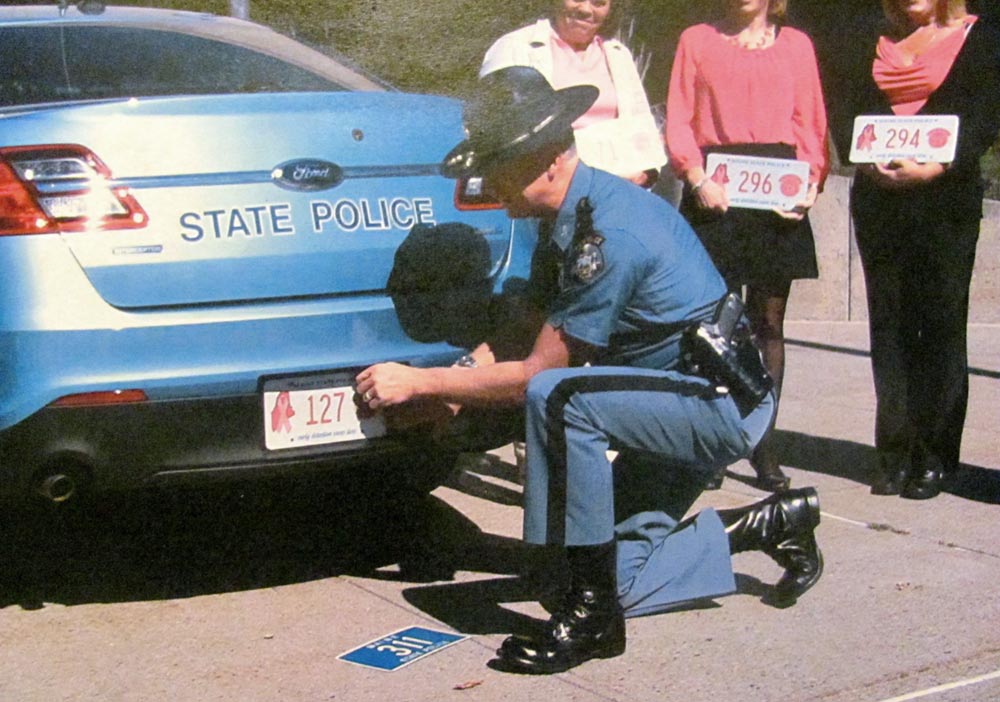 Trooper Samuel Tlumac of Troop C having removed his assigned number 311 license plate and replacing with the first Pink Ribbon license plate for the media kick-off number 127.
Trooper Samuel Tlumac of Troop C having removed his assigned number 311 license plate and replacing with the first Pink Ribbon license plate for the media kick-off number 127.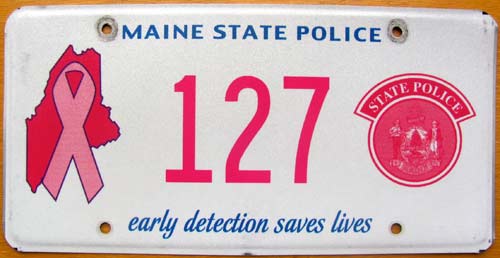 October 2013 Pink Ribbon issue.
October 2013 Pink Ribbon issue. 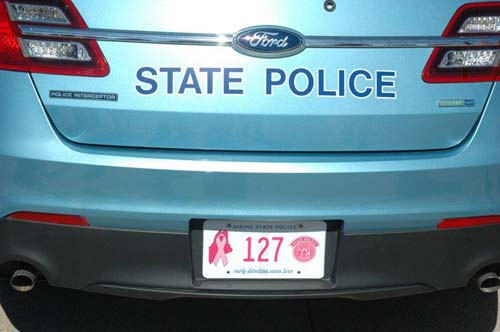
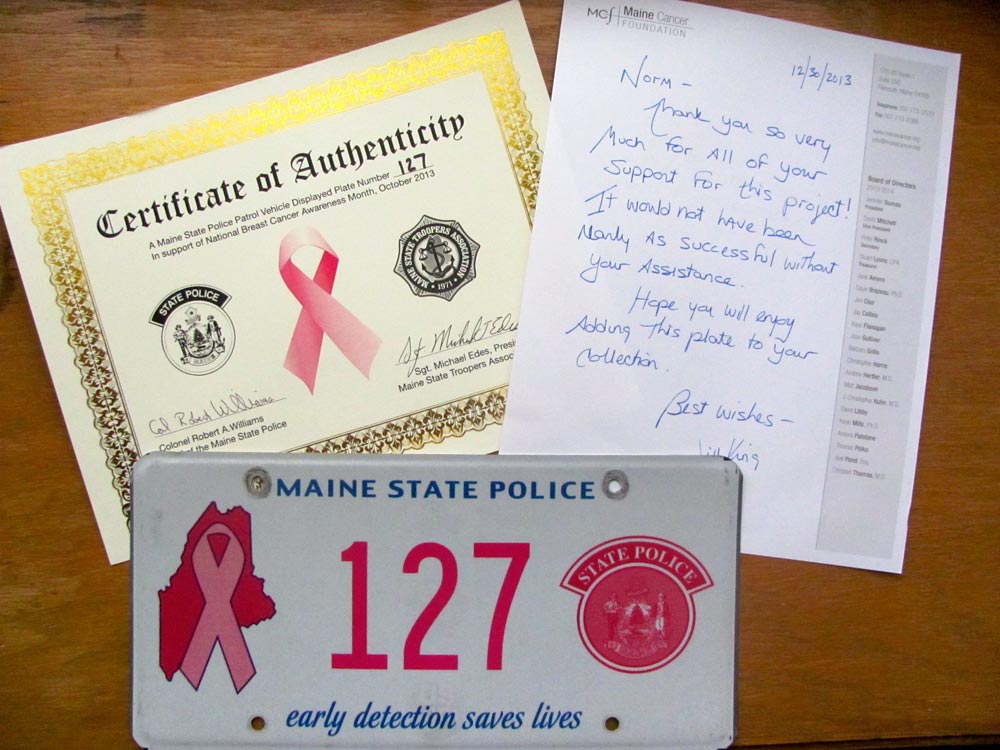 Maine State Police license plate number 127 from the media kick-off was presented to Norm Ratcliffe by the Maine Cancer Foundation at the conclusion of the pink ribbon license plate auction for assistance rendered in the logistics and promotion of the event.
Maine State Police license plate number 127 from the media kick-off was presented to Norm Ratcliffe by the Maine Cancer Foundation at the conclusion of the pink ribbon license plate auction for assistance rendered in the logistics and promotion of the event. In 1992, Merrill Worcester, owner of Worcester Wreath Company of Harrington, ME. had a surplus of Christmas wreaths. Remembering a boyhood trip he made at 12 to visit Arlington National Cemetery, he made arrangements with the help of Maine Senator Olympia Snow to place wreaths in an older section of Arlington Cemetery.
The annual tribute continued for several years, including a special ceremony at the Tomb of the Unknown Soldier, until 2005, when a photo of Arlington in the snow with wreaths on the headstones received national attention. Thousands of requests poured in from all the country from people wanting to help with the Arlington project or emulate the project in their area.
In 2007, Wreaths Across America, a non-profit 501(c)3 Corporation, was formed to continue and expand the wreath effort.
The mission of Wreaths Across America, Remember, Honor, Teach, is carried out in part by coordinating wreath-laying ceremonies on a specified Saturday in December in Arlington, as well as at veterans’ cemeteries and other locations in all 50 states, ceremonies at sea and at 24 national cemeteries on foreign soil. in 2014, 69 trucks delivered 230,000 wreaths, placed by over 40,000 volunteers.
The Maine State Troopers Foundation is a sponsor and supporter of Wreaths Across America and attends the function. The Maine State Police assists in the escort from Maine to Arlington by the Patriot Guard Riders for the trucks carrying the wreaths, and also participate in the ceremony.
During this mission in 2015, all Maine State Police vehicles bore special WREATHS ACROSS AMERICA license plates for the duration of the convoys.
The plates were privately made and constructed of thin aluminum and colored and formatted similar to regular Maine State Police license plates. Mounting holes were long slots as opposed to smaller and round mounting holes on regular MSP plates. The emblem of WREATHS ACROSS AMERICA occupies the left center field of the plate and the emblem of the MSP occupies the center right filed of the plate. The assignment number occupies the center field of the plate in white. REMEMBER HONOR TEACH is spelled-out in white below STATE POLICE at the bottom center of the plate.
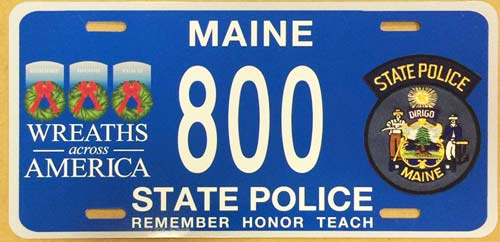 2015 Wreaths Across America issue. Silkscreened aluminum.
2015 Wreaths Across America issue. Silkscreened aluminum.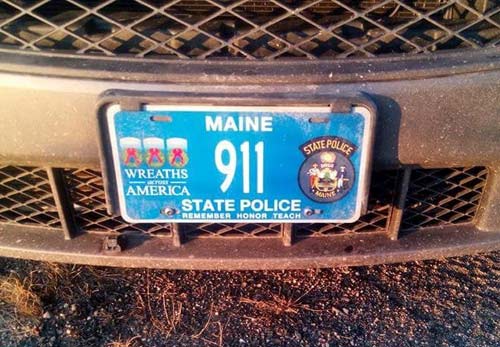 (Courtesy Andy Foss)
(Courtesy Andy Foss)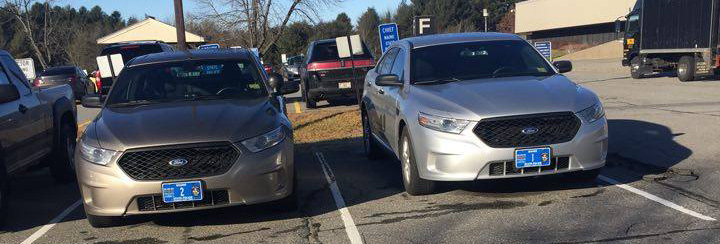 Wreaths Across America number 1 and 2.
Wreaths Across America number 1 and 2. 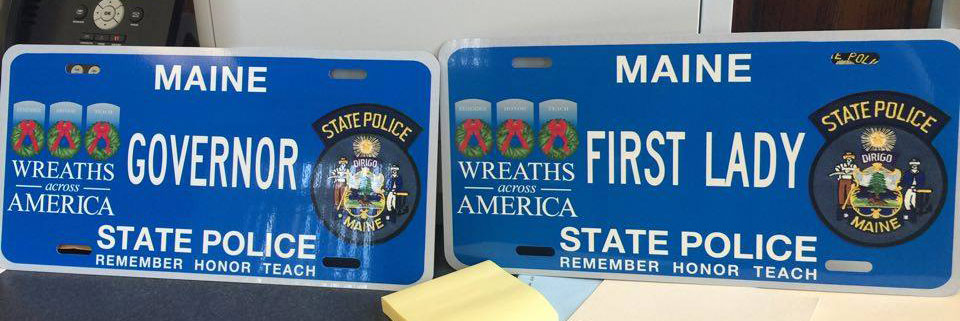 Wreaths Across America for Governor Paul LePage and First Lady Ann LePage- Courtesy Rob Nichols
Wreaths Across America for Governor Paul LePage and First Lady Ann LePage- Courtesy Rob Nichols Autographs of Governor and First Lady on reverse side- Courtesy Rob Nichols
Autographs of Governor and First Lady on reverse side- Courtesy Rob Nichols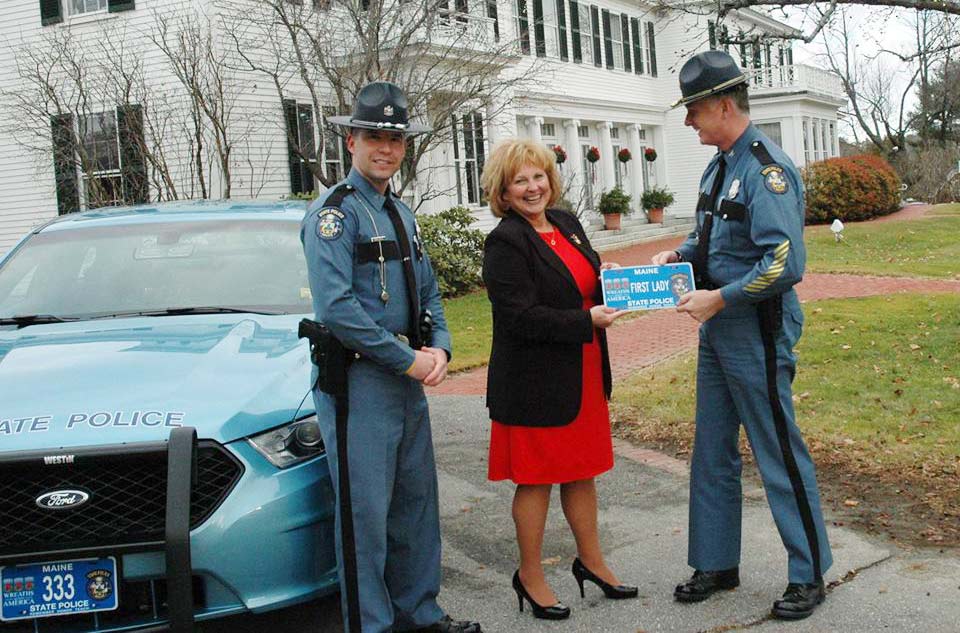 Presentation of 2015 MSP Wreaths Across America license plate to First Lady Ann LePage by Colonel Robert Willams
Presentation of 2015 MSP Wreaths Across America license plate to First Lady Ann LePage by Colonel Robert Willams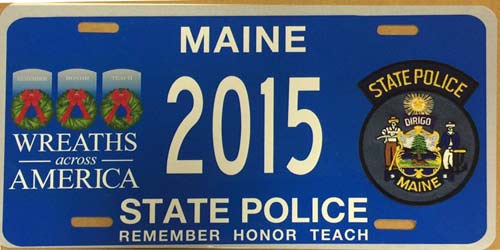 2015 Wreaths Across America souvenir issue.
2015 Wreaths Across America souvenir issue.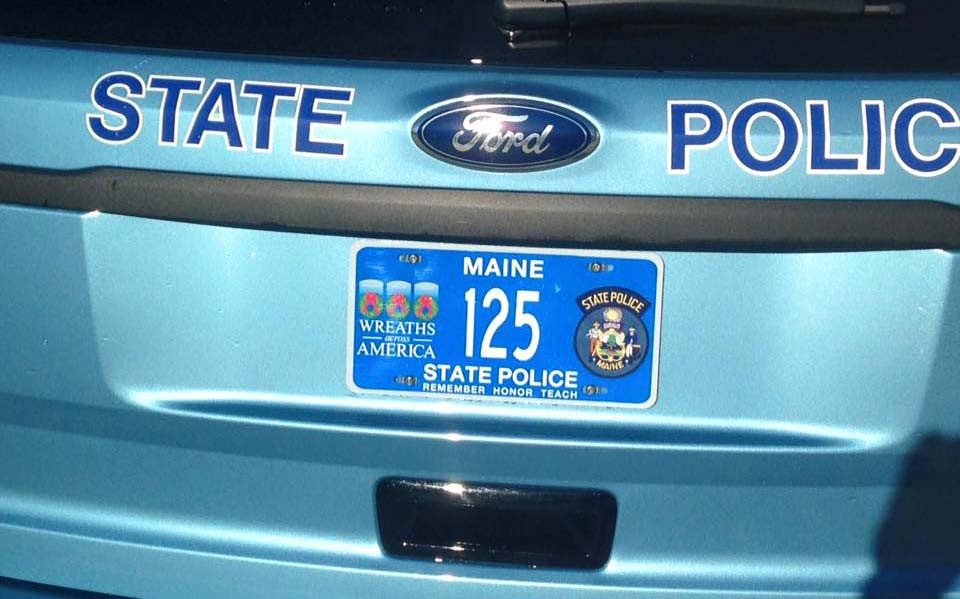 2015 Wreaths Across America plate of Sgt Doug Cropper
2015 Wreaths Across America plate of Sgt Doug CropperOn April 10, 2012, United States Army Staff Sergeant Travis Mills of the 82nd Airborne was critically injured on his third tour of duty in Afghanistan by an IED (improvised explosive device) while on patrol, losing portions of both legs and both arms. He is one of only five quadruple amputees from the wars in Iraq and Afghanistan to survive his injuries.
Thanks to his amazing strength, courage, an incredible will to live, the heroic actions of the men in his unit, the prayers of thousands, and all the healthcare providers at the Walter Reed Army Medical Center, near Washington D.C., Travis remains on the road to recovery. Every day is a battle, but Travis continues to astound friends and family alike with his progress and with his amazing spirit. SSG Travis Mills is a genuine American hero, and for his incredible sacrifice, we are forever in his debt.
In September 2013, Travis founded the Travis Mills Foundation, a nonprofit organization, formed to benefit and assist combat-injured veterans. The Foundation purchased a historic lodge in Rome Maine to renovate it for a fully-accessible retreat for combat injured veterans and their families.
The Maine State Police and Maine State Troopers Association decided to bring attention to the cause of this state and national hero by displaying distinctive graphic license plates on their marked vehicles in July of 2016. The plates are of the same manufacture as the Wreaths Across America license plates. These plates differ by having the Travis Mills Foundation emblem on the left center field of the plate and Mills' slogan "Never give up. Never Quit" below STATE POLICE at the bottom center of the plate.
 US Army Staff Sgt Travis Mills with Governor and First Lady LePage for launch of Maine State Police license plates in his honor.
US Army Staff Sgt Travis Mills with Governor and First Lady LePage for launch of Maine State Police license plates in his honor.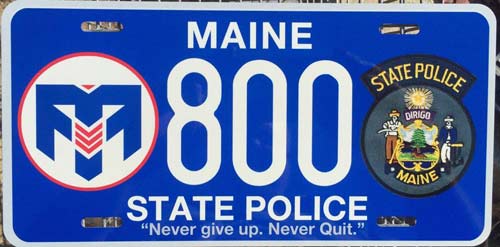 July 2016 Travis Mills Foundation issue.
July 2016 Travis Mills Foundation issue.
On October 15 2017, the Maine State Police partnered with Special Olympics, Maine State Troopers Association, and Maine State Trooper Foundation to have commemorative license plates displayed on their cruisers until the end of October that year. MSP troopers were authorized to display the attractive commemorative license plates on their vehicles to bring attention to the long-standing relationship between state law enforcement and Special Olympics. For three decades, Maine law enforcement officers have participated in torch runs to bring awareness and demonstrate support of the important work of Special Olympics and the exceptional athletes they serve. The plates were made of embossed aluminum and issued in pairs with sequential numbers for random assignment to MSP personnel with the exception of license plates #1 and #2 issued to the Colonel and Lt. Colonel. The plates were made in the traditional white over blue format of contemporary Maine State Police license plates. A silkscreened yellow and white logo reading LAW ENFORCEMENT TORCH RUN FOR SPECIAL OLYMPICS MAINE occupied the center left field of the plate followed by the assignment number embossed in white followed by the red and white SPECIAL OLYMPICS MAINE logo silkscreened on the right center field of the plate.
The plates were authorized for display on MSP vehicles until October 31 2017, whereupon they were then gathered for dispersement via charity auction and donation. Many were autographed by the MSP personnel attributed to the plate's number.
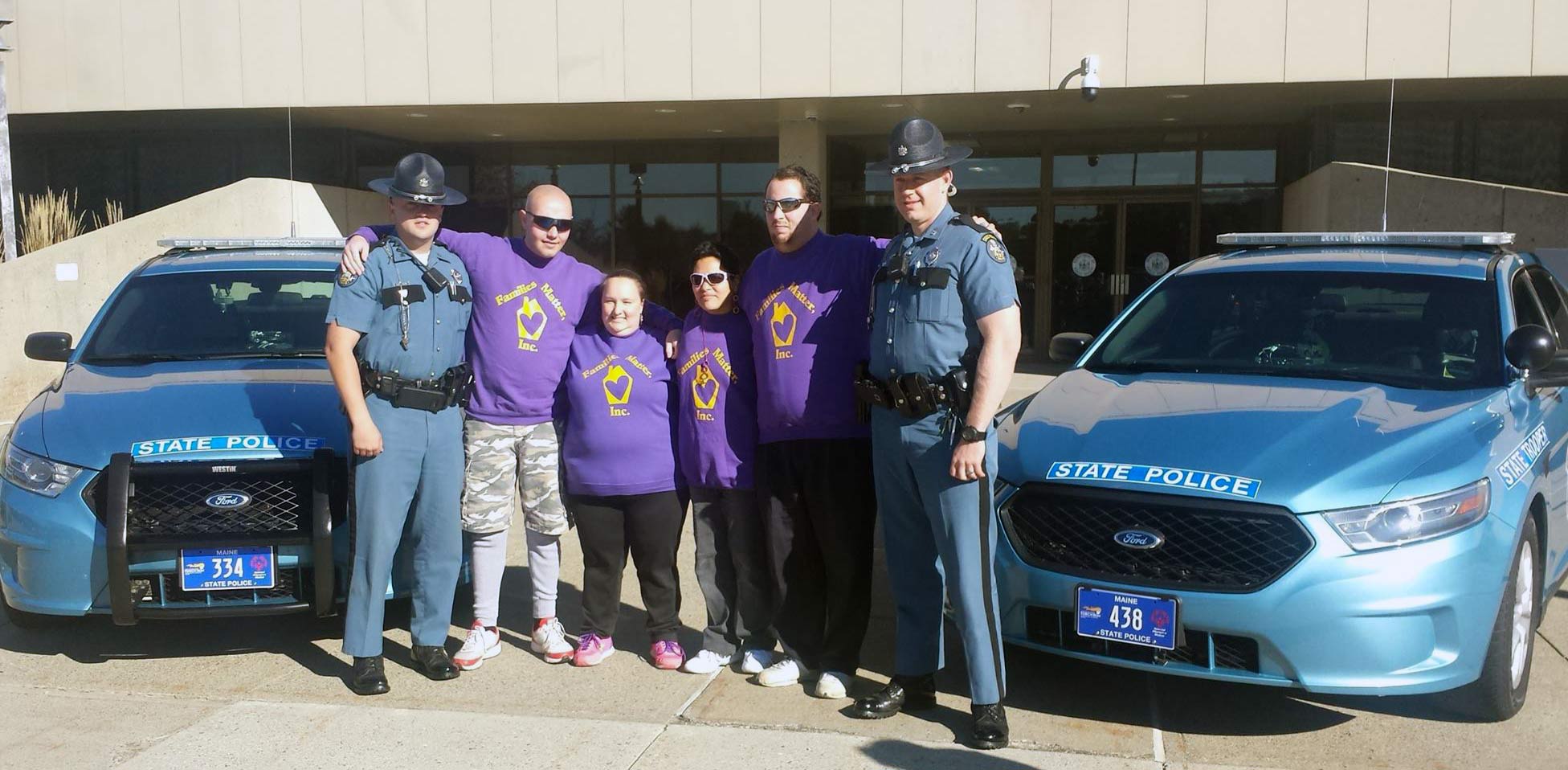 October 15 2017, the launch of the Maine State Police/ Special Olympics Torch Run initiative where the specially-made MSP license plates to honor the cause were revealed to the public.
October 15 2017, the launch of the Maine State Police/ Special Olympics Torch Run initiative where the specially-made MSP license plates to honor the cause were revealed to the public.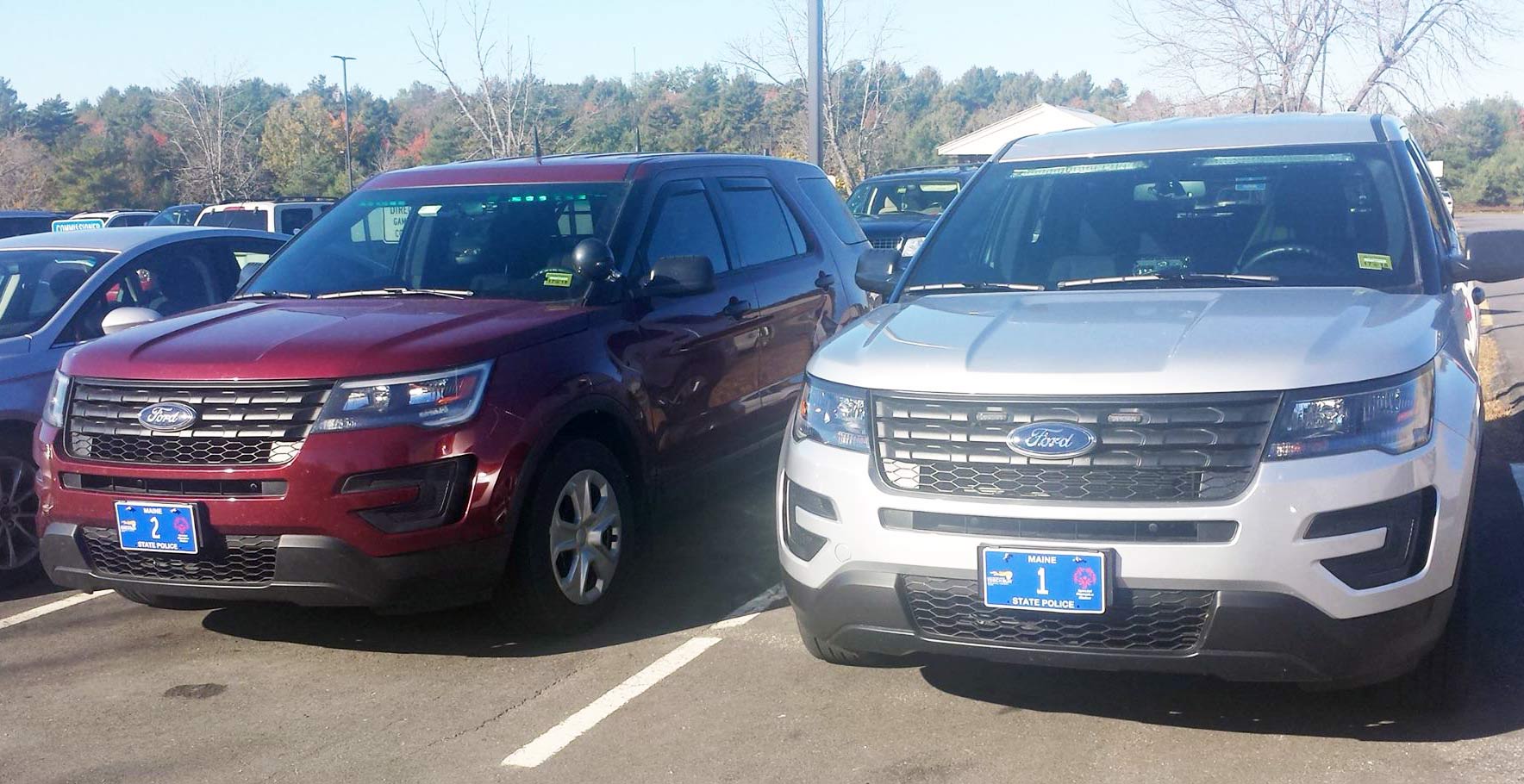 The number 1 and 2 Special Olympics Torch Run license plates for the Colonel and Lt. Colonel of the Maine State Police.
The number 1 and 2 Special Olympics Torch Run license plates for the Colonel and Lt. Colonel of the Maine State Police. October 15-October 31 2017 Special Olympics issue.
October 15-October 31 2017 Special Olympics issue.
On September 2nd 2018, the Maine State Police issued commemorative license plates for their fleet once again and this time they honored the Barbara Bush Children’s Hospital in Portland. The commemorative plates were pnce again a collaborative effort with the Maine State Troopers Association and the Maine Troopers Foundation. The white over dark blue license plates with graphics showcasing the name and logo of the hospital, were attached to cruisers and run until September 30th. Upon the end of the campaign, many of the plates were signed by the individual troopers and collected to be sold during an online auction and at other special events. All proceeds went to benefit the Children’s Hospital. The Chief of the Maine State Police, Colonel John Cote, said the Barbara Bush Children’s Hospital and Maine State Police have had a long association. Troopers have brought presents in for patients at the hospital annually at Christmas for several years. Cote said, “State police have been a strong supporter of the hospital and its mission. Our hope is these plates will raise awareness of the high quality services the hospital provides to our most vulnerable citizens and the funds raised will benefit those most in need.”
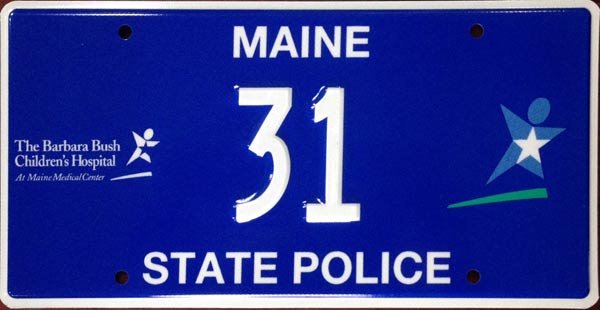 September 2 2018-September 30 2018 Barbara Bush Children's Hospital issue.
September 2 2018-September 30 2018 Barbara Bush Children's Hospital issue.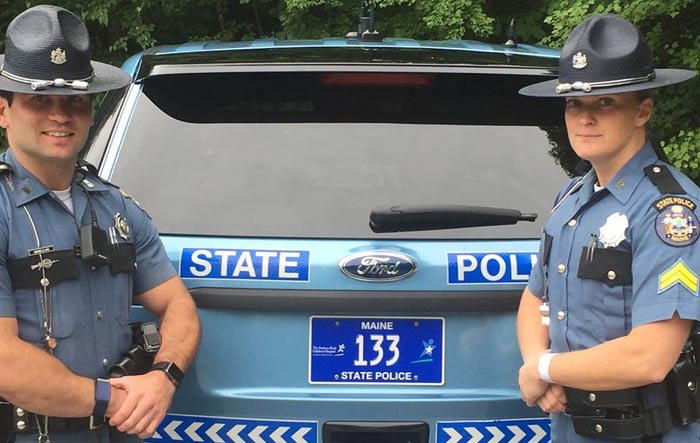
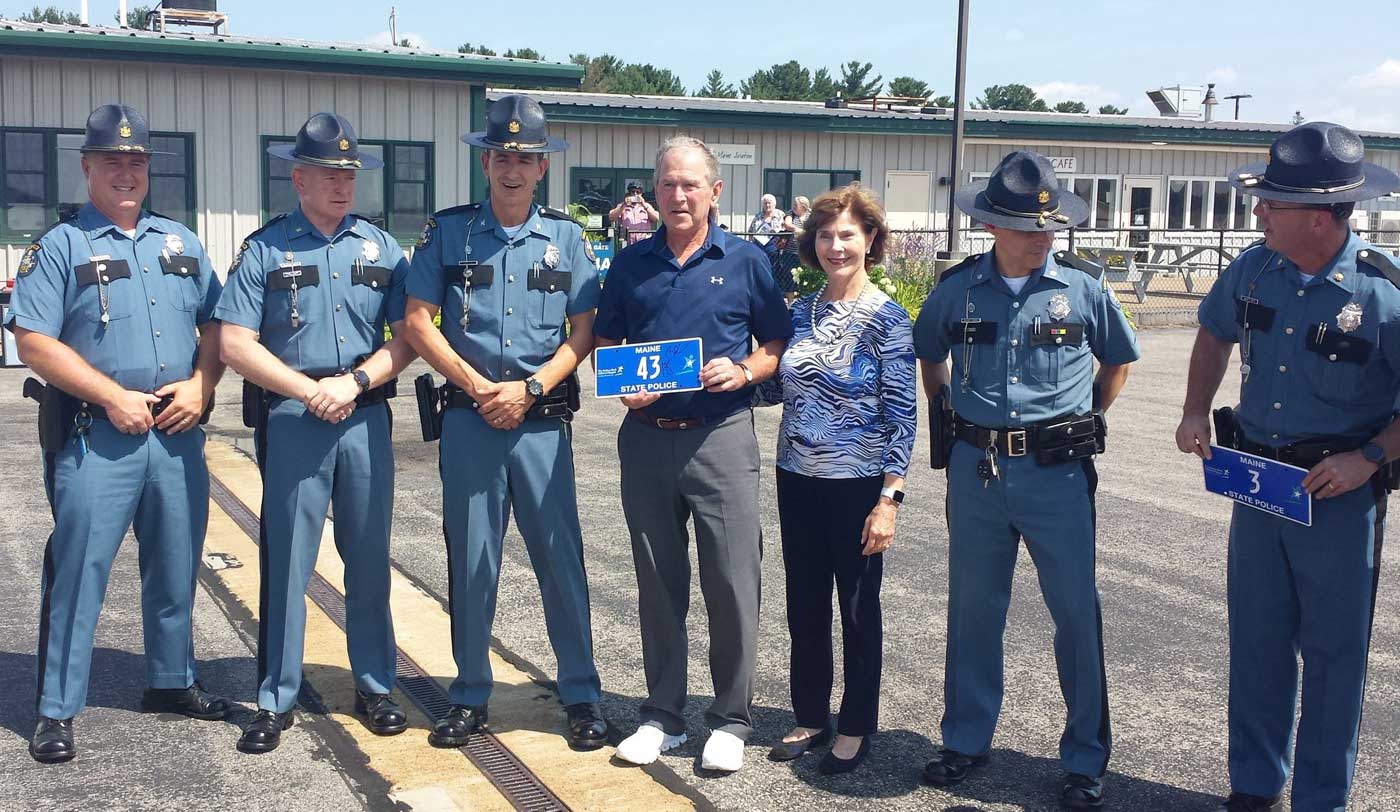 43rd US President George Bush and Laura Bush with Maine's Finest holding plate # 43.
43rd US President George Bush and Laura Bush with Maine's Finest holding plate # 43.  2018 Wreaths Across America issue.
2018 Wreaths Across America issue.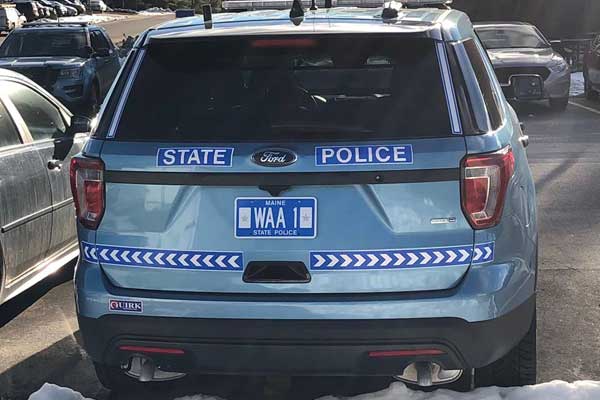 (Courtesy Tom Fiske)
(Courtesy Tom Fiske)On November 7 2019, Colonel John Cote of the Maine State Police along with the Maine State Troopers Foundation announced that the 2019 State Police Commemorative Plate would be supporting Honor Flight Maine. Honor Flight Maine is a non-profit organization created to honor American Veterans for their service and sacrifice. They transport veterans to Washington D.C. for tours of the memorials, giving special consideration to frail and terminally ill veterans. Honor Flight Maine frequently hold events welcoming home veterans or celebrating their service to our country. For the 2019 campaign, designated Troopers started displaying the plates on Veterans Day, Nov 11, 2019, and the plates remained on the cruisers until the end of the month. “We are privileged to team with the Maine State Troopers Foundation to honor all veterans during the month of November and to heighten awareness of the unique mission of Honor Flight Maine,” said Col. John Cote, Chief of the Maine State Police. “Many of Maine’s eldest and most tenured veterans would have no way to travel to our National Monuments on their own. Honor Flight Maine provides free transportation to these deserving veterans and allows them the chance to visit and experience the memorials created to honor their service and sacrifice.”
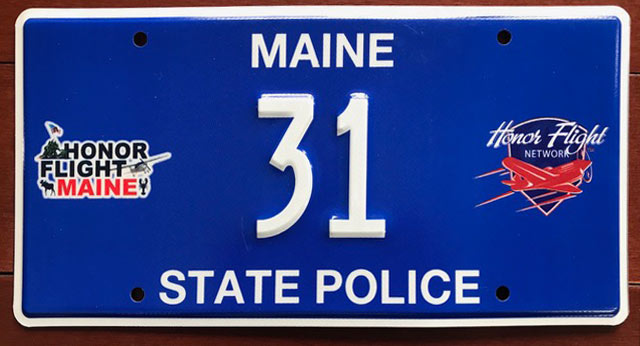 November 11 2019-November 30 2019 Honor Flight issue.
November 11 2019-November 30 2019 Honor Flight issue.
In 2022, the Maine State Police and Maine State Troopers Foundation (MSTF) teamed up once again to raise awareness and funds for non-profit organizations.
This particular year, they chose to design an Autism Awareness license plate and patch. MSTF partnered with the Autism Society of Maine, and the (Doug) Flutie Foundation for Autism Awareness Month in April of 2022.
“The Maine State Troopers Foundation is proud to partner with the Autism Society of Maine and Flutie Foundation as we enter Autism Acceptance Month,” said Sgt. Aaron Turcotte of the MSTF. “We are fortunate to have these two amazing organizations supporting us with the messaging our troopers will display on their license plates throughout the month. Autism may be hard to see, but it isn’t invisible. Practice Compassion, which we know is one of the Maine State Police Core Values.”
The plates have been authorized to be displayed on Maine State Police cruisers for the month of April. They were then auctioned off by the MSTF at a later date.
“It’s through our generous and dedicated community partners, like the Maine State Police, that the Flutie Foundation can raise critical funds allowing people and families with autism live life to the fullest,” said Nick Savarese, Director of the Flutie Foundation. “We are grateful to partner with the Maine State Police, who keep people with autism safe in their community and work to build inclusive communities of acceptance and respect.”
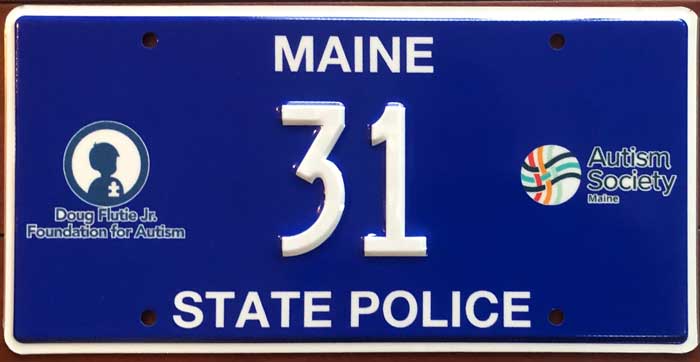 April 2022 Doug Flutie Jr, Foundation For Autism/Autism Society of Maine.
April 2022 Doug Flutie Jr, Foundation For Autism/Autism Society of Maine.
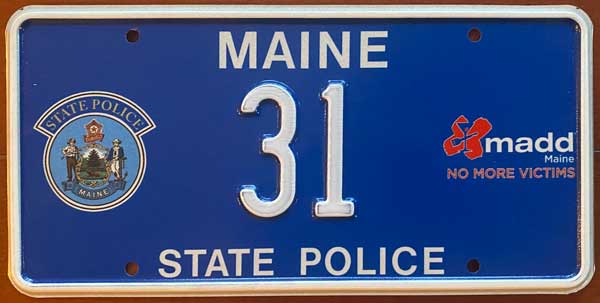 June 2023 MSP/MSTF MADD issue.
June 2023 MSP/MSTF MADD issue.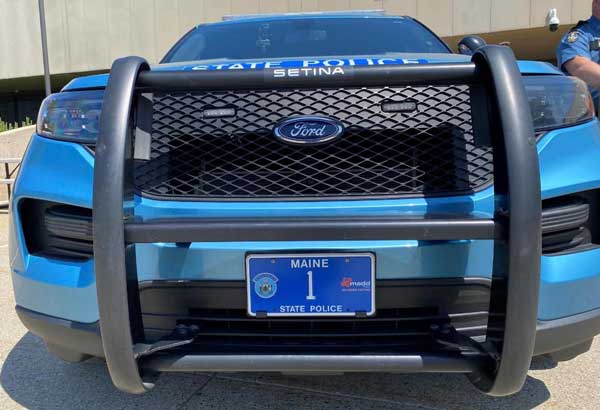 MADD 1
MADD 1 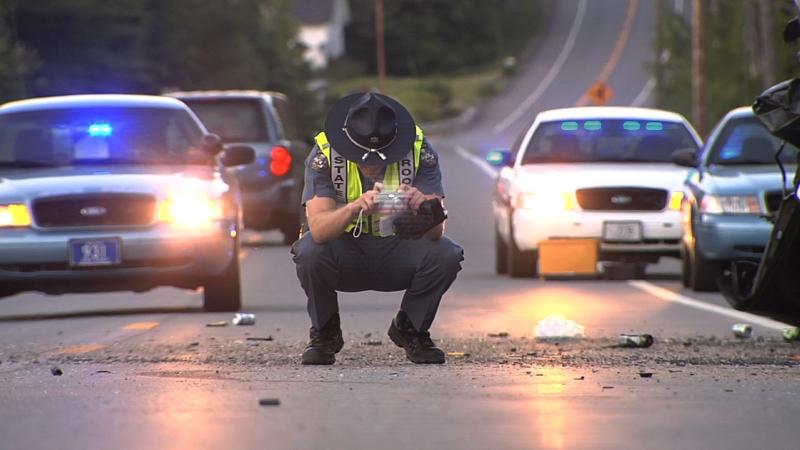
2021 marked the 100th Anniversary of the Maine State Police (Maine State Highway Police). In commemoration of the Centennial milestone, the MSP developed and deployed very distinctive black over orange license plates, replicating the first titled STATE POLICE plates used in 1936. In addition, nine special edition marked cruisers were released in January of 2021 – one for each of Maine’s Troops. These black, fully marked cruisers were designed with replica door seals and other markings duplicating the first cruisers issued in the mid 1930’s as the agency began the transition to cars over motorcycles. These vehicles were included in MSP's normal fleet order and were not additional purchases. They remained on the road for the full service life well beyond 2021.
The license plates featured the state name in black at the top center of the plate and STATE POLICE silkscreened at the bottom center. The left center field to the registration number depicts a first generation Maine State Police white over red insignia with a monochrome white and grey scroll below it with 1921 MAINE 2021 inscribed on it. At the right center field is the typical modern-age MSP emblem. The "retro" emblem also features a diagonal black band at the top left corner with the number 12 in white. This honors the twelve MSP Troopers who lost their lives while serving the people of Maine over the past century.
The plates were issued and distributed with random numbers not reflective of troop or specialized assignment and ran through to early 2022.
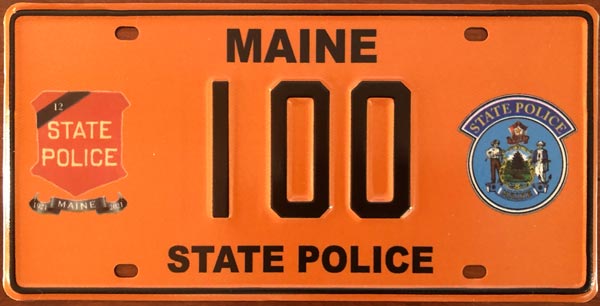 2021 100th Anniversary issue. Embossed aluminum.
2021 100th Anniversary issue. Embossed aluminum. 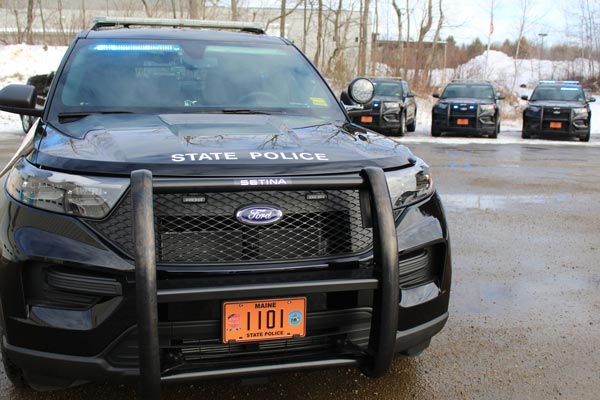 One of nine special "retro look" MSP cruisers outfitted for MSP Centennial celebration in 2021.
One of nine special "retro look" MSP cruisers outfitted for MSP Centennial celebration in 2021.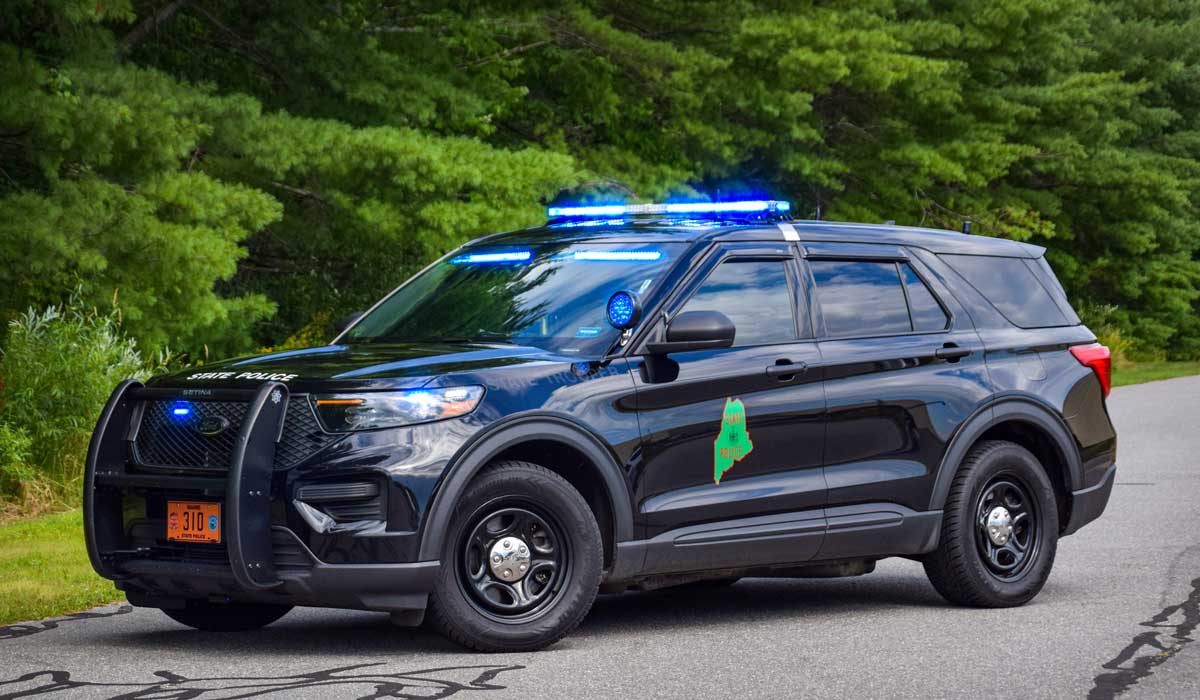 blabla
blabla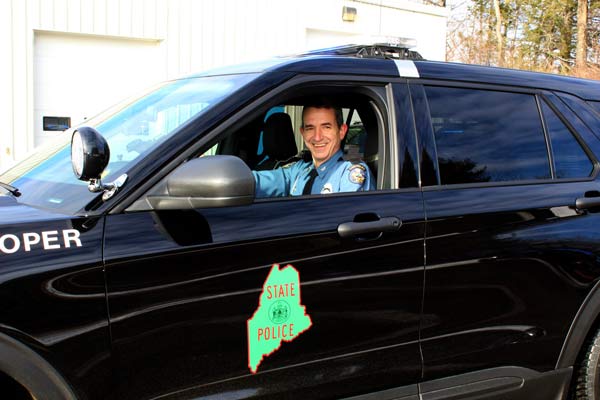 Retro door emblem
Retro door emblem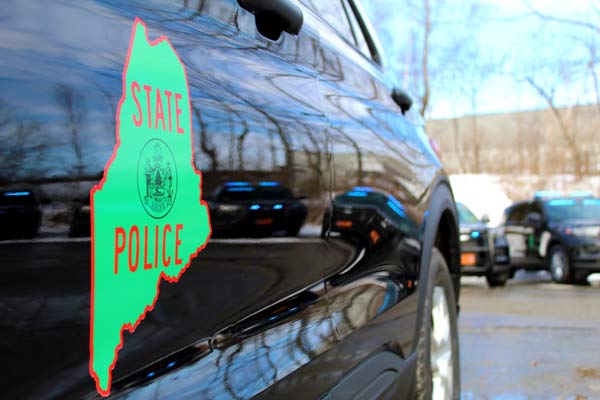

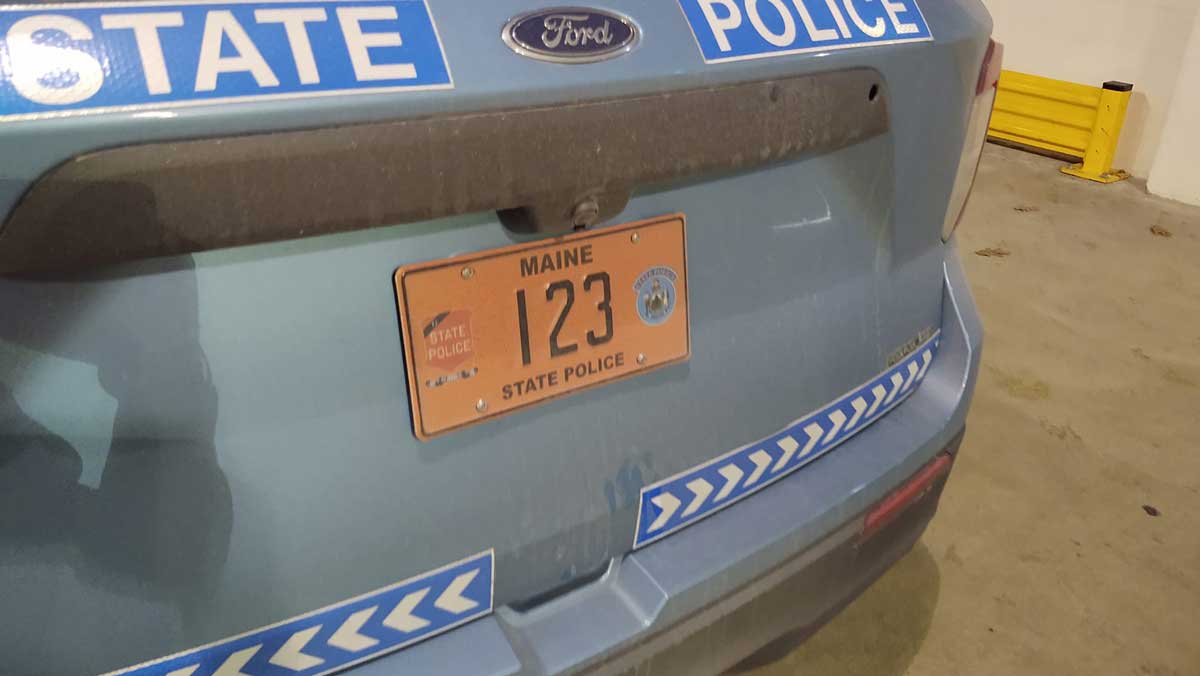
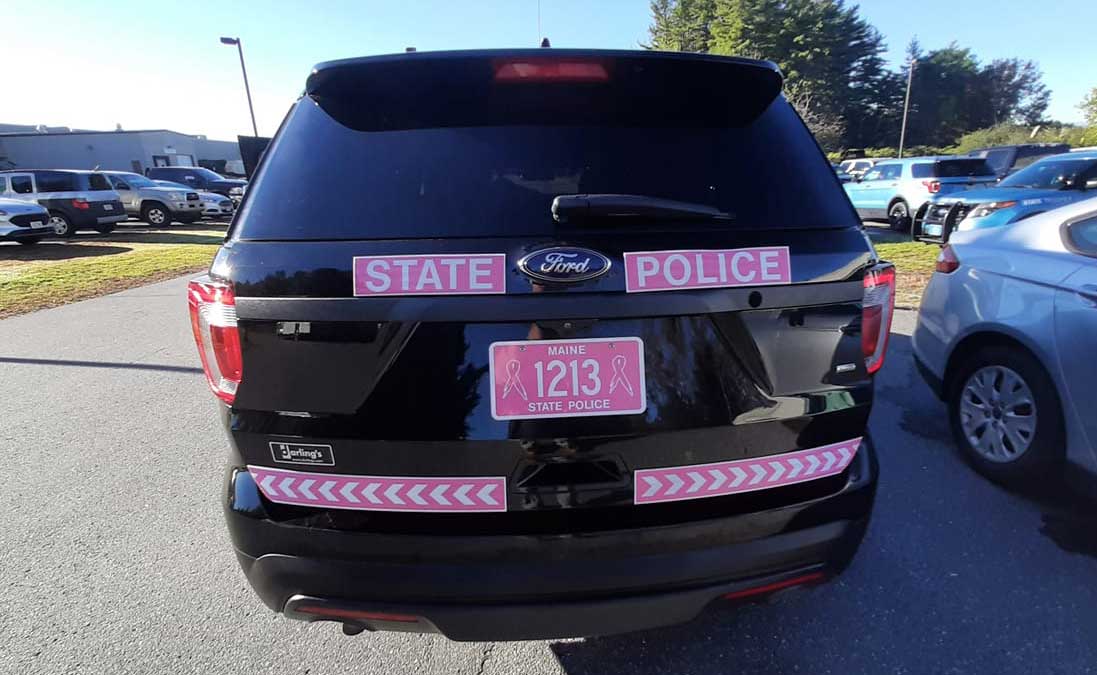
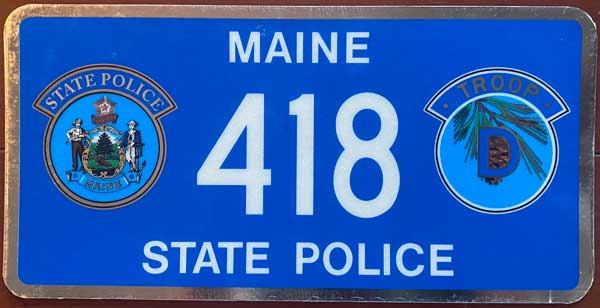 Prototype design.
Prototype design.
Motorcycles were a principal mode of motor patrol in the earliest years of the MSP and its predecessor, the Maine State Highway Police.
The earliest known motorcycle license plate for this agency was from 1929. The plate measured roughly 6 1/4" x 4 1/4" and was made of embossed steel. The plate had white characters over an indigo background. The top of the plate had the letters S-H over the word POLICE over a number up to three digits over MAINE 1929.
The plates were run on the front and rear of the motorcycle as were all subsequent issues.
A 1933 version of the same plate was also issued in the same format and color scheme as the 1929 version.
It is believed that the State Highway Police motorcycle plates were last used in 1934.
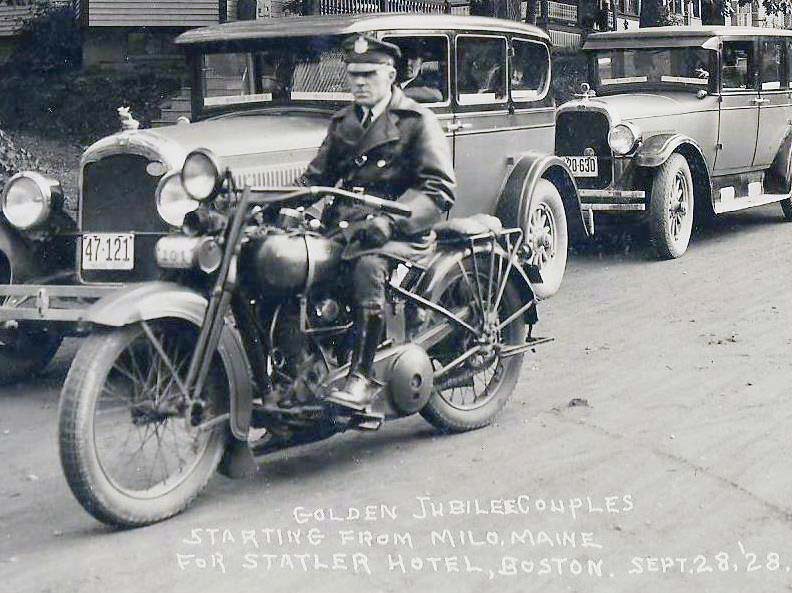 1928
(Courtesy Tom Fiske)
1928
(Courtesy Tom Fiske)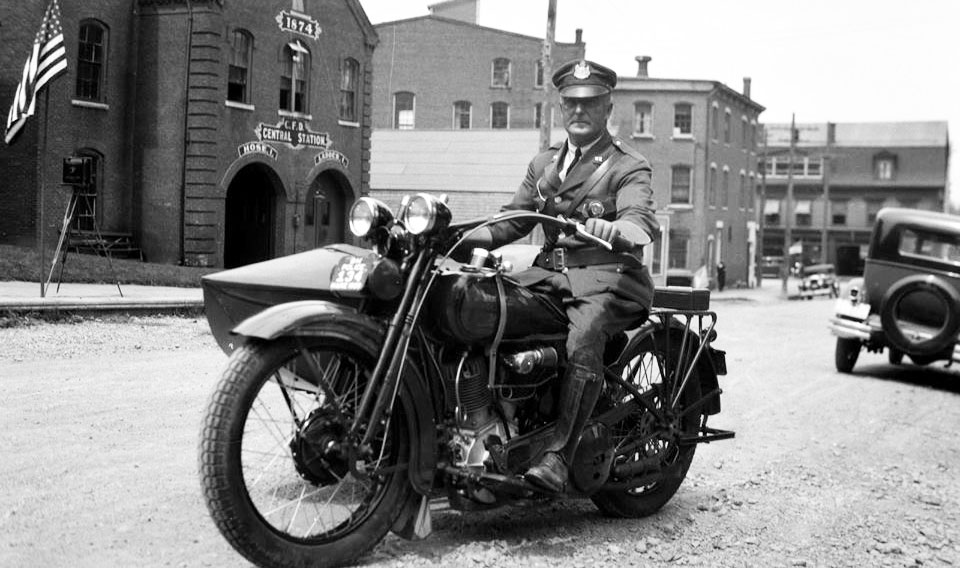 1929 Maine State Highway Police Officer William Gibson
1929 Maine State Highway Police Officer William Gibson 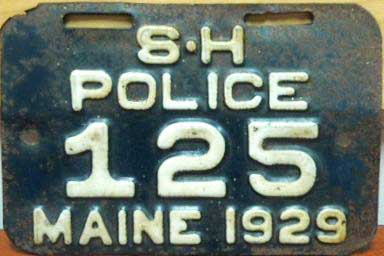 1929 State Highway Police motorcycle
1929 State Highway Police motorcycle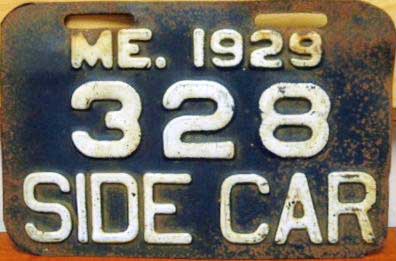 1929 motorcycle side car issue. Embossed steel.
1929 motorcycle side car issue. Embossed steel.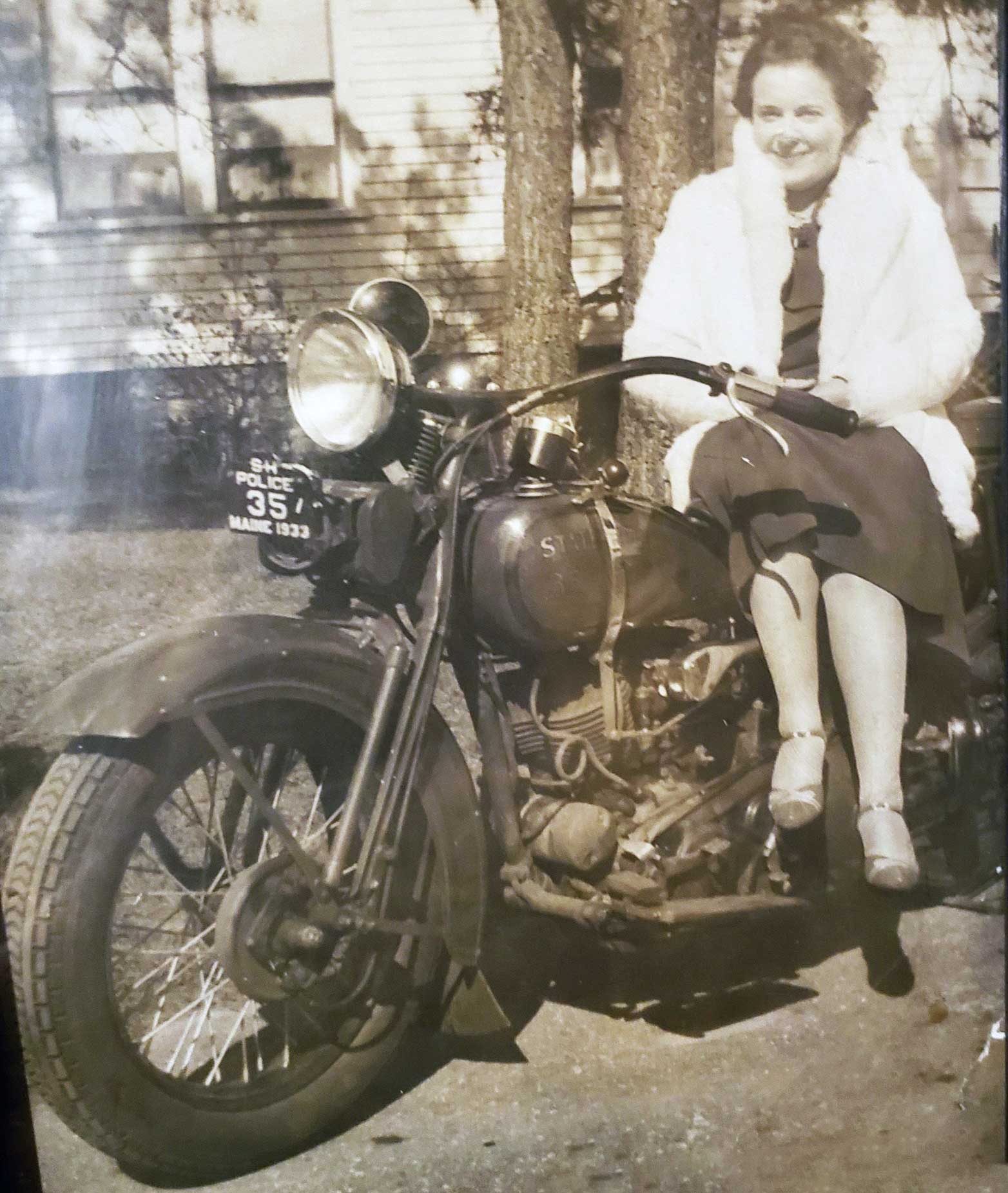 Maine State Highway Police 1933.
Maine State Highway Police 1933. 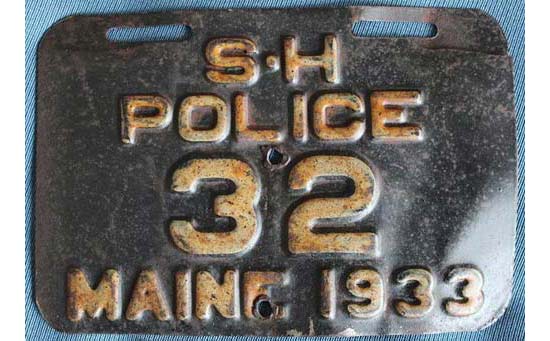 1933 State Highway Police motorcycle issue. Embossed steel.
1933 State Highway Police motorcycle issue. Embossed steel.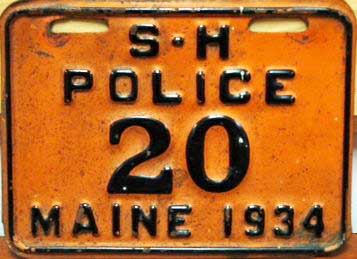 (Courtesy of Rob Nichols and Steve McCausland- MSP)
(Courtesy of Rob Nichols and Steve McCausland- MSP)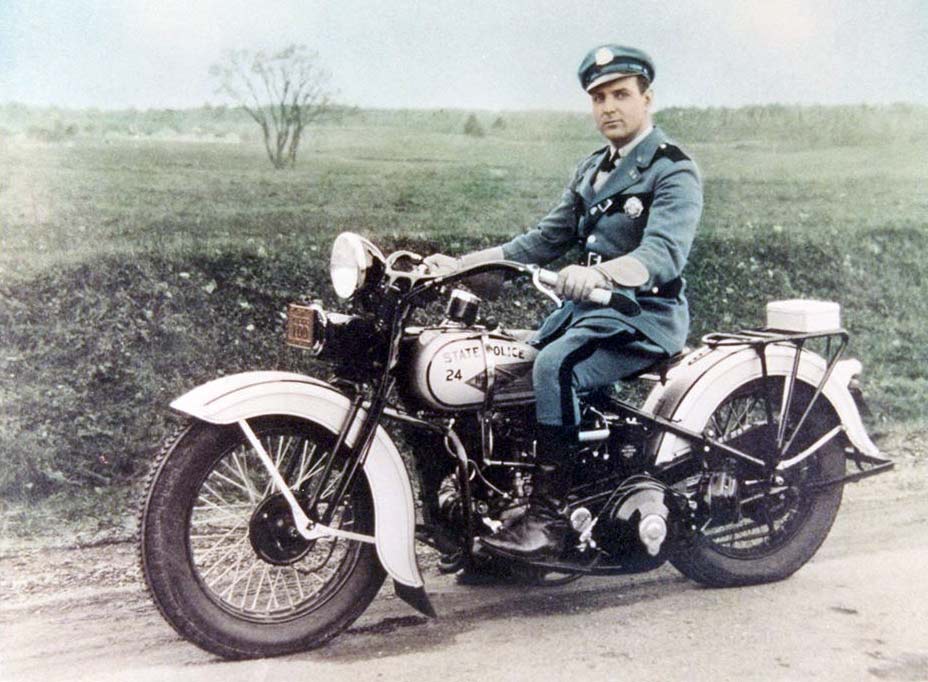 Maine State Highway Police Officer Roger Doyle (1934).
Maine State Highway Police Officer Roger Doyle (1934). The 1936 photograph of Patrolman Rex St. Ledger seen below, shows him astride his Harley-Davidson motorcycle number 51. The front license plate can be seen affixed below the headlamp and appears to measure the same as its State Highway Police predecessor (6 1/4" x 4 1/4"). It also appears to be white over black with STATE over POLICE over 51 over MAINE 1936.
As there are so few surviving specimens of Maine State Police motorcycle license plates, it can only be assumed they were issued annually in colors that differentiated from their automobile counterparts.
It is also believed that the MSP phased-out the motorcycle from its fleet around 1941. Any further information in this regard would be appreciated.
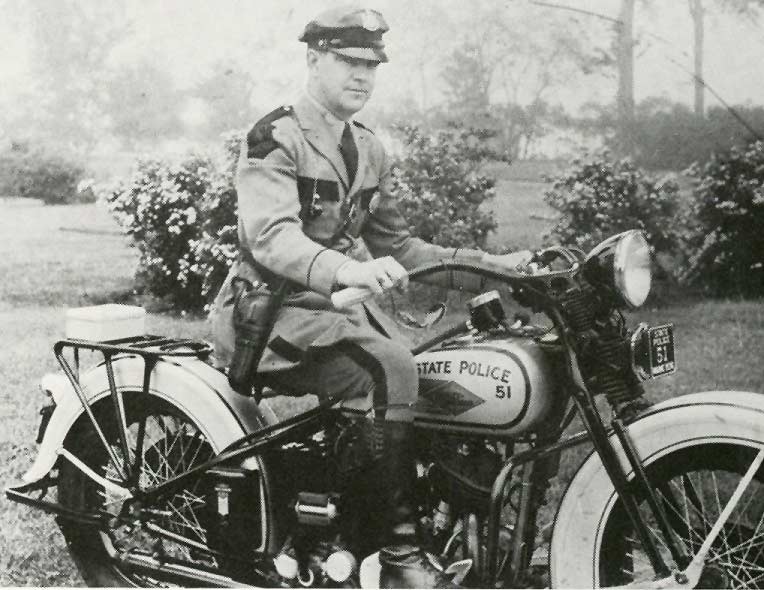
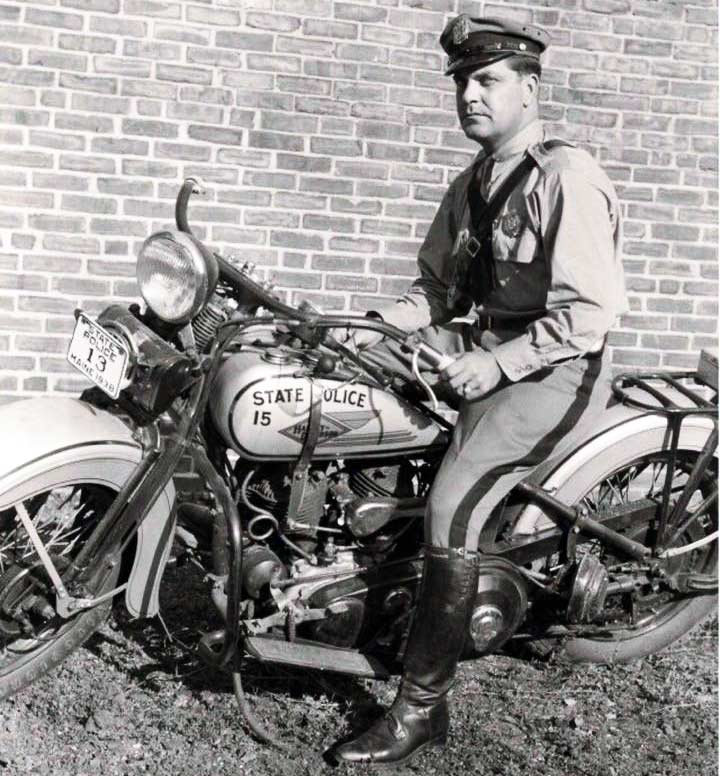 1938. Tpr Dominique LaChance on his 1934 Harley Davidson VLD.
1938. Tpr Dominique LaChance on his 1934 Harley Davidson VLD.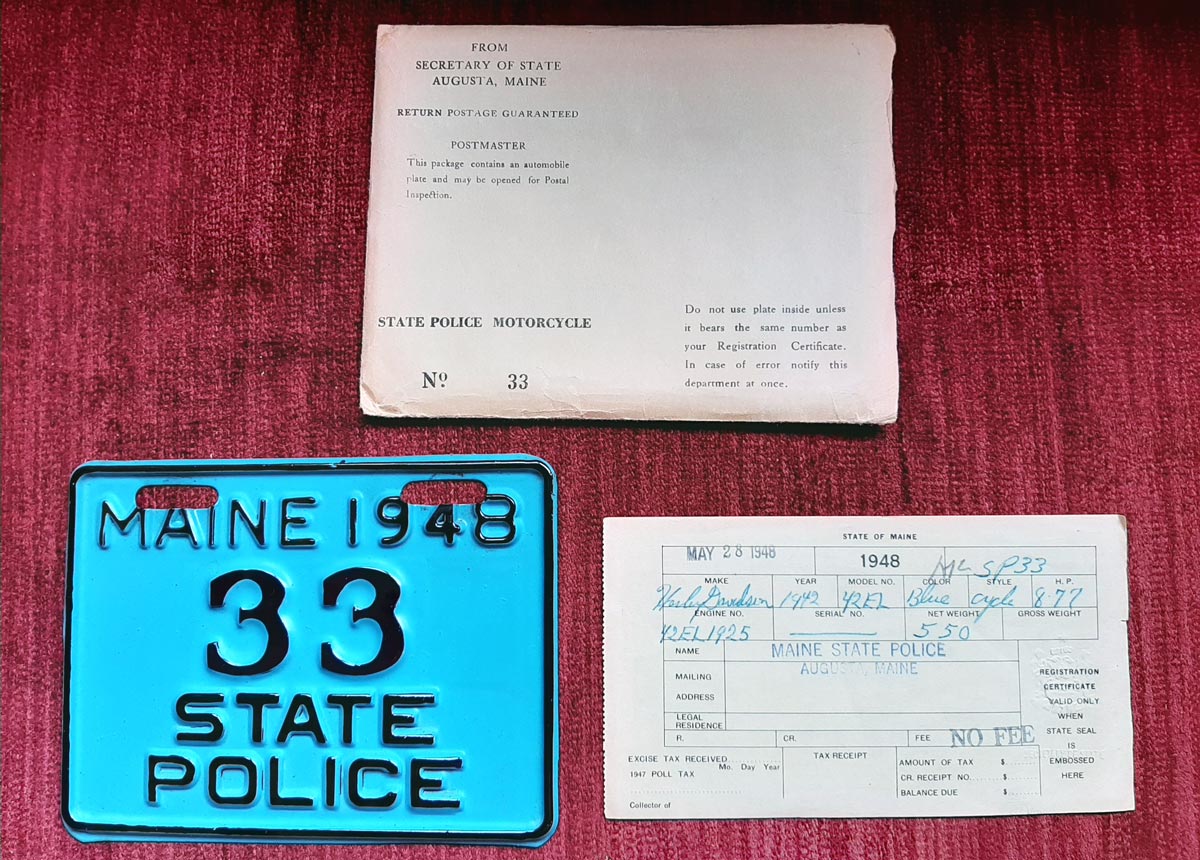 Spectacular mint condition 1948 MSP Motorcyce license plate with matching registration card and envelope.
Spectacular mint condition 1948 MSP Motorcyce license plate with matching registration card and envelope.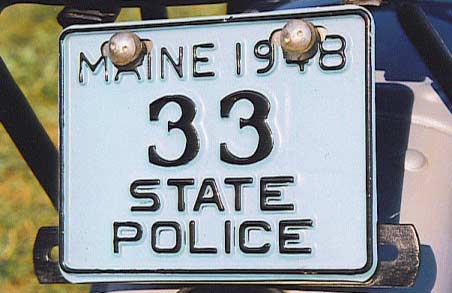 1948 issue MSP motorcycle on restored MSP motor.
1948 issue MSP motorcycle on restored MSP motor.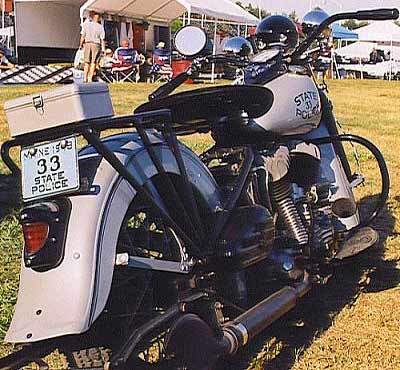
After the motorcycle for duty in the Maine State Police went dormant in July of 1951, it was not until just over sixty seven years later, that the absence of the motorcycle from the Maine State Police fleet came to an end. The idea was pitched to Command to give rebirth to the old Maine State Police "Motor Unit". By the Summer of 2018, an order was placed for six brand new Harley Davidsons that were provided by Seacoast Harley Davidson of North Hampton New Hampshire.
Selection of members began, and one of the intrepid candidates for the new unit was Trooper Tom Fiske, a major contributor to this page and this hobby. Once the members were selected, during the month of November of 2018, they attended a rigorous three week "Motor School" in Connecticut run by the Connecticut State Police.
In short order, proper Maine State Police motorcycle license plates were created and affixed to the new rides.
The design of the plates was simply a smaller version of the Maine State Police "full size" license plates, however measuring the standard size of seven inches by four inches for motorcycle plates.
The only difference aside from the size was a small "MC" stacked vertically along the left inside margin of the plate.
 Late 2018-Current motorcycle issues.
Late 2018-Current motorcycle issues.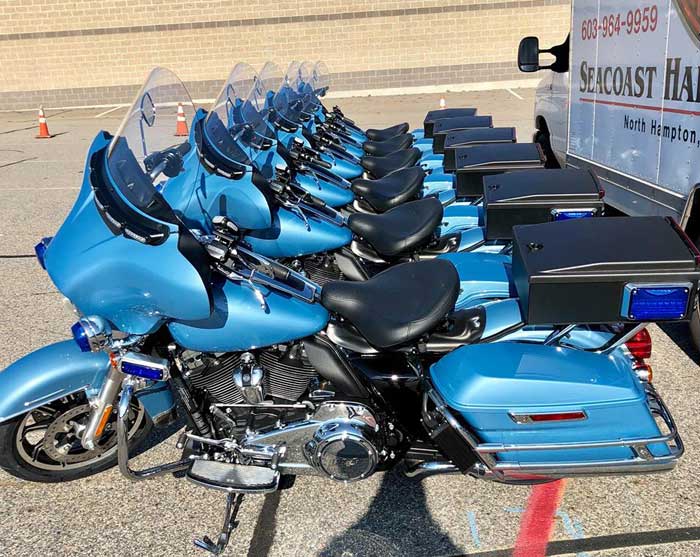 All six new Maine State Police motorcycles upon delivery-First MSP motorcycles since 1951! Fall of 2018.
All six new Maine State Police motorcycles upon delivery-First MSP motorcycles since 1951! Fall of 2018.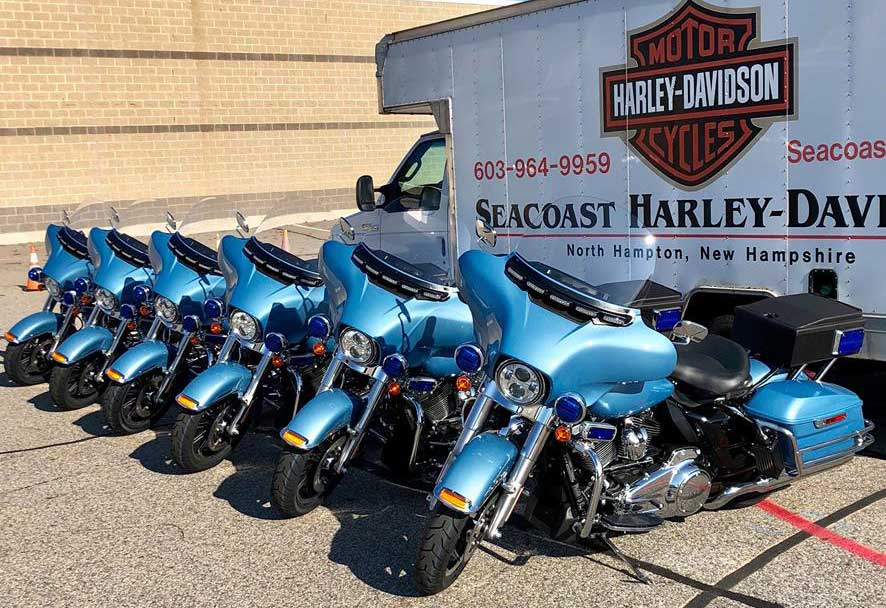
On the morning of April 3 2019, Detective Ben Campbell (1282) was heading along Interstate 95 in Hampden, when he stopped to assist a diabled motorist that had slid-off the paved portion of the highway. During his selfless task to help a fellow citizen, a passing logging truck on the same highway, lost two wheels where one ended-up striking and killing the 31 year old detective, husband and father of a 6 month old son.
Detective Campbell was transported to Eastern Maine Medical Center in Bangor where he succumbed to his injuries.
Detective Campbell had served with the Maine State Police for nine years and was assigned to the Polygraph Unit. He was survived by his wife, Hilary and 6-month-old son Everett.
On April 9 2019, a funeral for Detective Campbell with full police honors was held in Portland. Approximately 3000 people filled the arena where the funeral was held including hundreds of law enforcement officers from the United States and Canada.
One of the tributes to this fallen officer was special license plates made for the hearse and motorcycles on escort for Detective Campbell's cortege. The plates were flat silkscreened aluminum and utilizing the standard white over blue color scheme. MAINE STATE POLICE was inscribed along the top of the plate, Detective Campbell's badge number 1282 occupied the center, flanked on each side by full color MSP emblems with a black diagonal mourning strike from the 8 to 2 o'clock position over the emblem.
DET BEN CAMPBELL inscibed over EOW: 04/3/2019 in smaller white font.
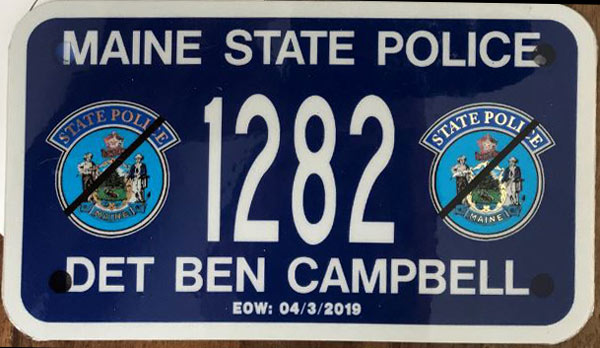 Funeral escort motorcycle license plate.
Funeral escort motorcycle license plate.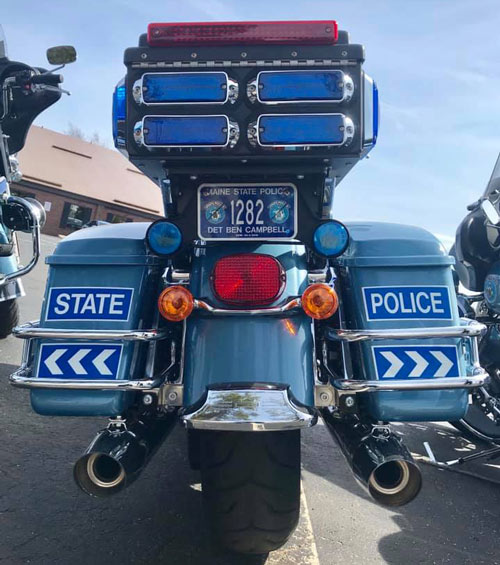
 MSP motorcycle escorts at the ready for Detective Ben Campbell's funeral cortege.
MSP motorcycle escorts at the ready for Detective Ben Campbell's funeral cortege.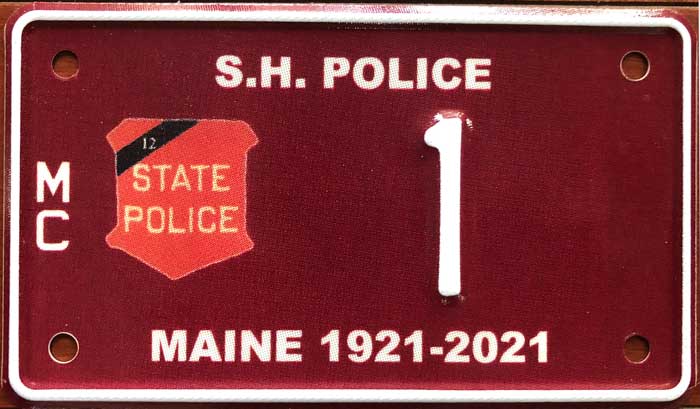 2021 MSP Centennial motorcycle issue.
2021 MSP Centennial motorcycle issue.
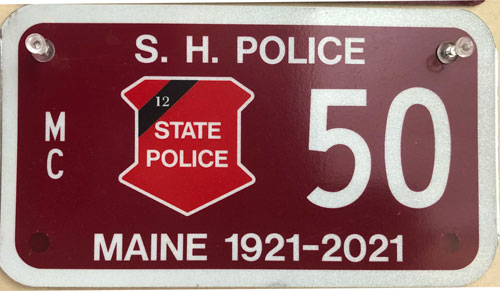 2021 MSP Centennial motorcycle issue.
2021 MSP Centennial motorcycle issue.
There are other special types of license plates issued that are not Maine State Police issue plates per se, but are tied-in to the agency via more informal means such as souvenir type plates issued for Conferences and the like.
One such plate that begs to be featured is the one seen below: the Maine LIQUOR ENFORCEMENT. These special reflective white over green license plates are used by State Police/Department of Public Safety personnel assigned to the Liquor Licensing and Compliance Division. The responsibility of this division is to license the manufacture, importation, storage, transportation and sale of all liquor and administer those laws relating to licensing and the collection of taxes on malt liquor and wine. The division can adopt rules consistent with Title 28A and other laws of the State for the administration, clarification, execution and enforcement of all laws concerning liquor and to prevent violations of those laws. They review applications for liquor licenses and are responsible for issuing and renewing liquor licenses. Division representatives inspect licensed establishments for compliance prior to the issuance of a license.
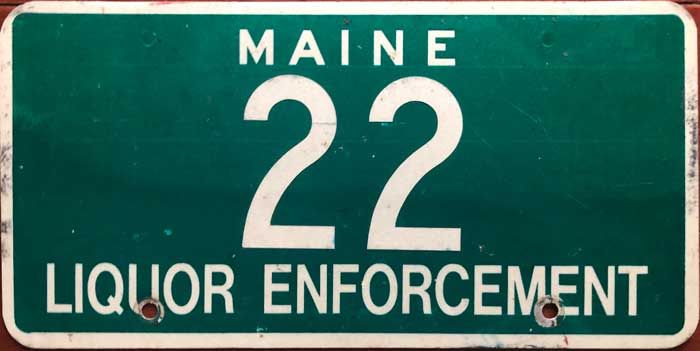 Liquor Licensing and Compliance Division of Maine State Police/Department of Public Safety, whose mandate is explained in the paragraph above.
Liquor Licensing and Compliance Division of Maine State Police/Department of Public Safety, whose mandate is explained in the paragraph above.
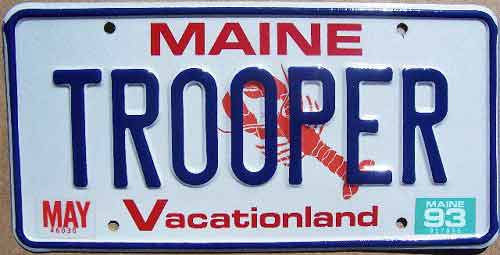 National Troopers Coalition souvenir plate 1993
National Troopers Coalition souvenir plate 1993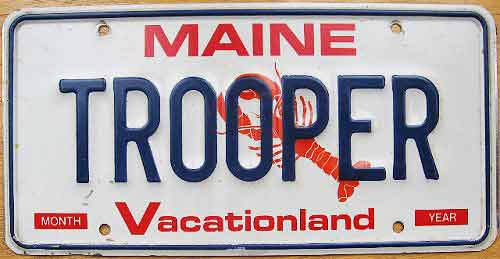 National Troopers Coalition souvenir plate unknown date- Smaller dies for TROOPER and no decals
National Troopers Coalition souvenir plate unknown date- Smaller dies for TROOPER and no decals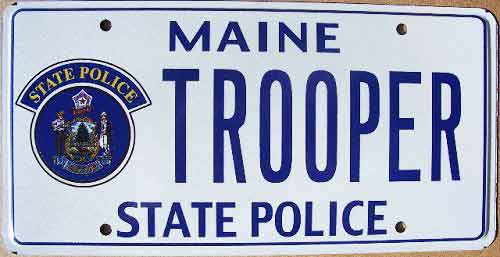 National Troopers Coalition souvenir plate-2002-
National Troopers Coalition souvenir plate-2002- 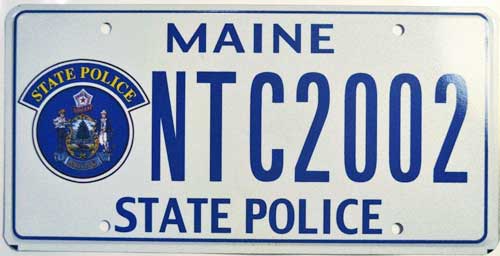 National Troopers Coalition souvenir plate-2002-
National Troopers Coalition souvenir plate-2002- 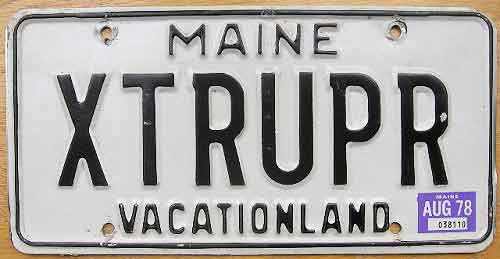 Regular issue vanity/personalized plate.
Regular issue vanity/personalized plate.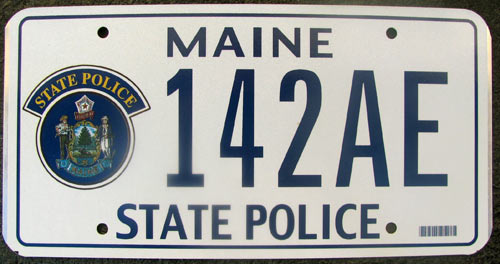 Graphic Prototype. Year unknown.
Graphic Prototype. Year unknown.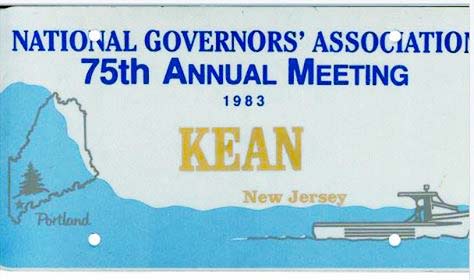 1983 National Governor's Association Meeting in Portland.
1983 National Governor's Association Meeting in Portland.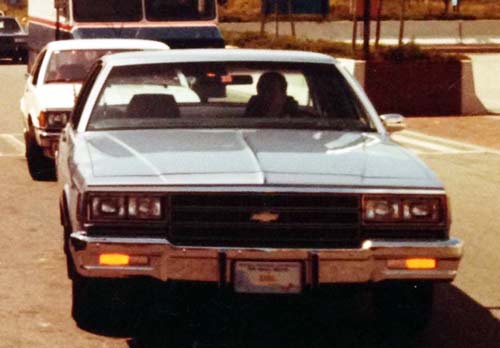
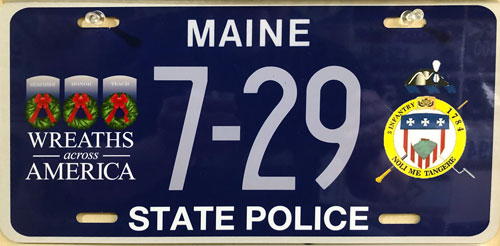 Wreaths Across America type honoring American Revolution era Infantry. Not official issue.
Wreaths Across America type honoring American Revolution era Infantry. Not official issue.